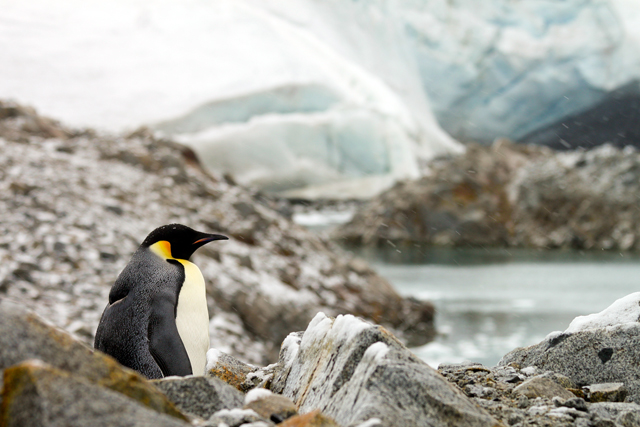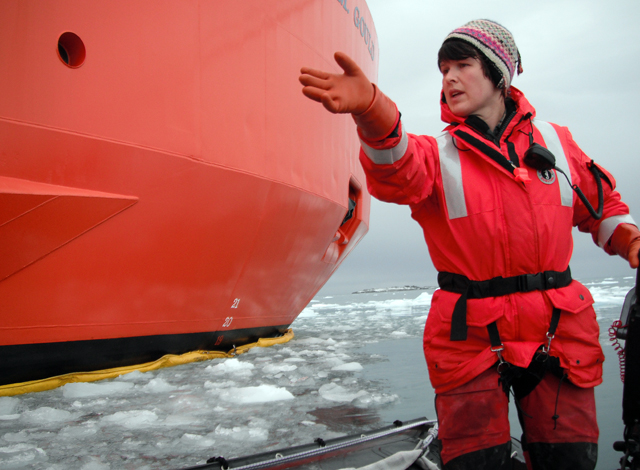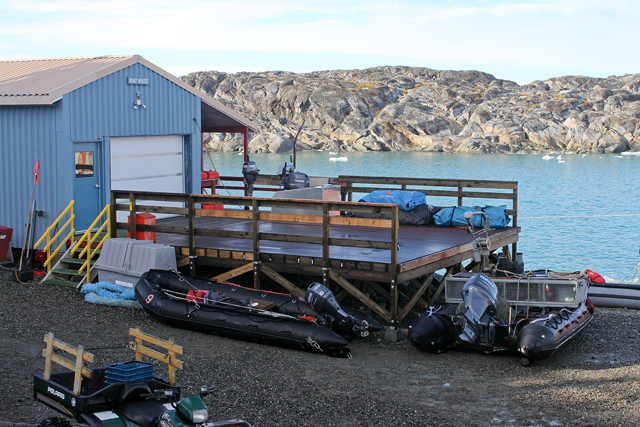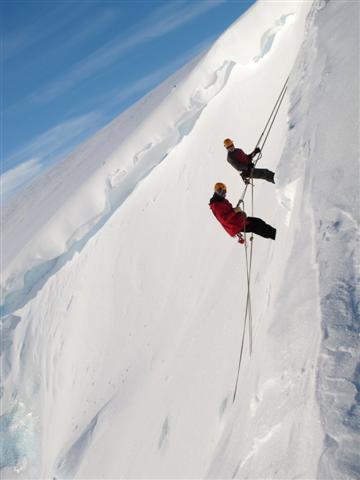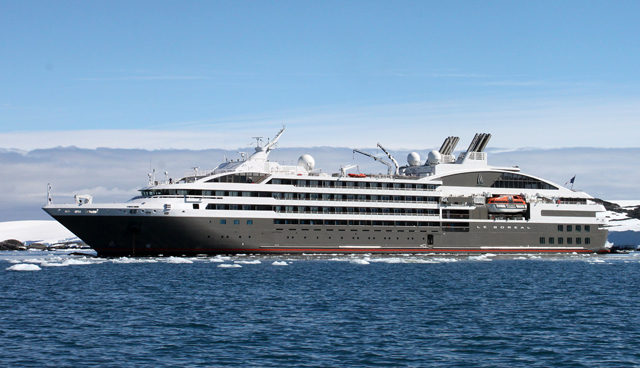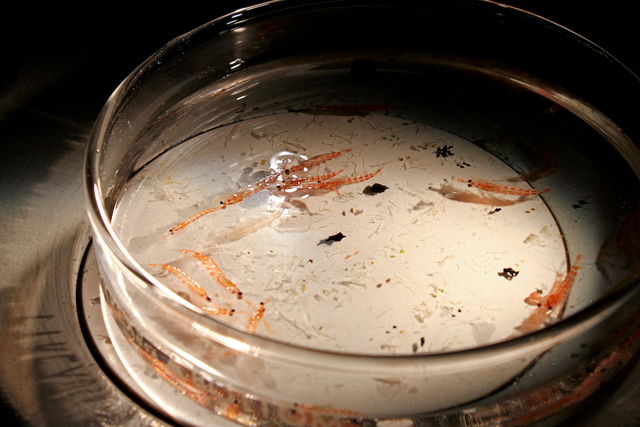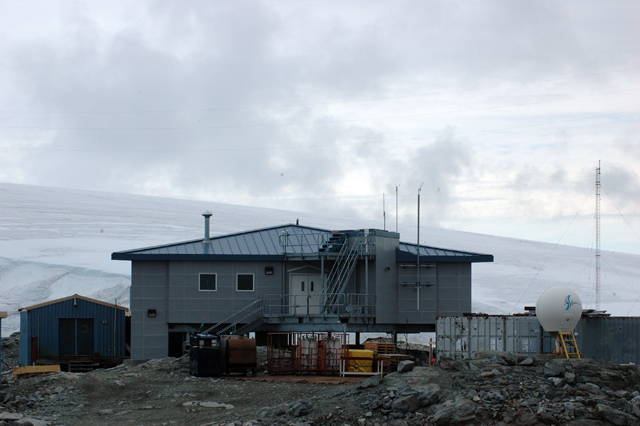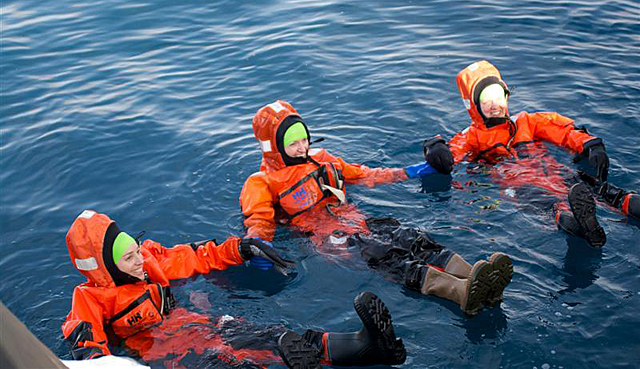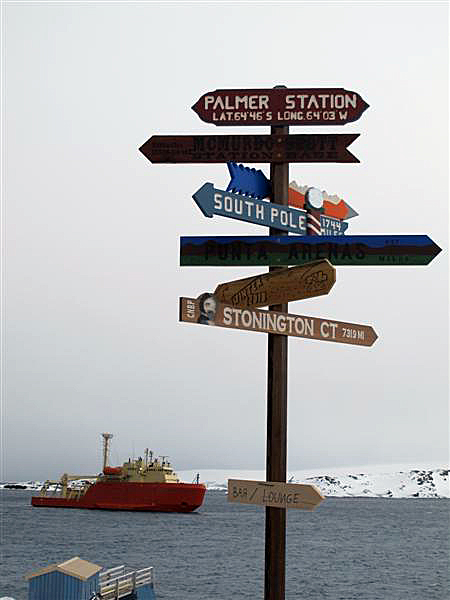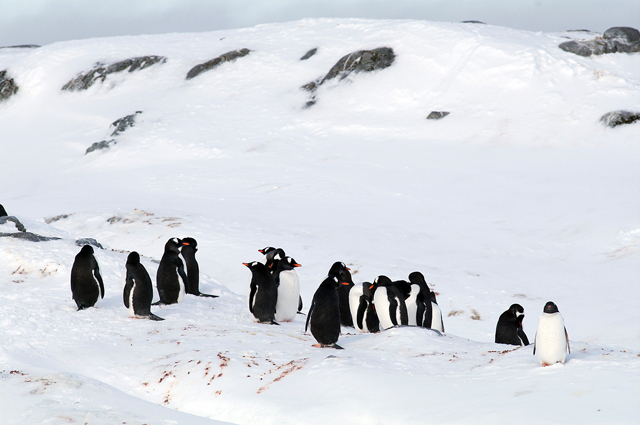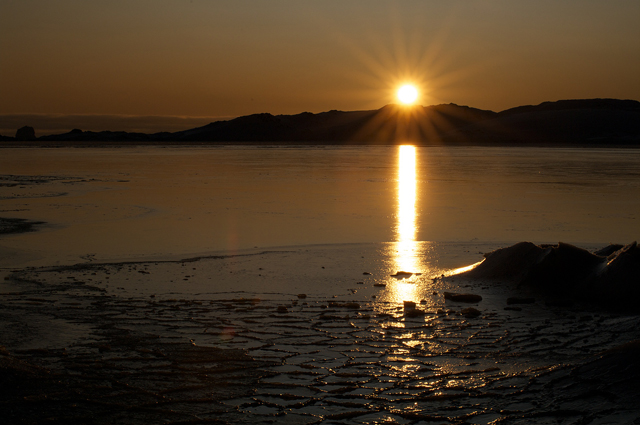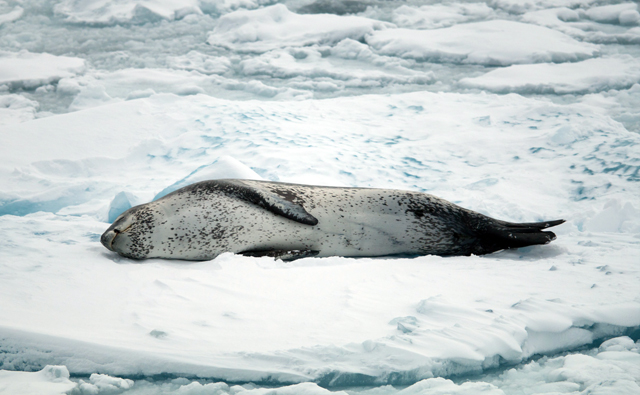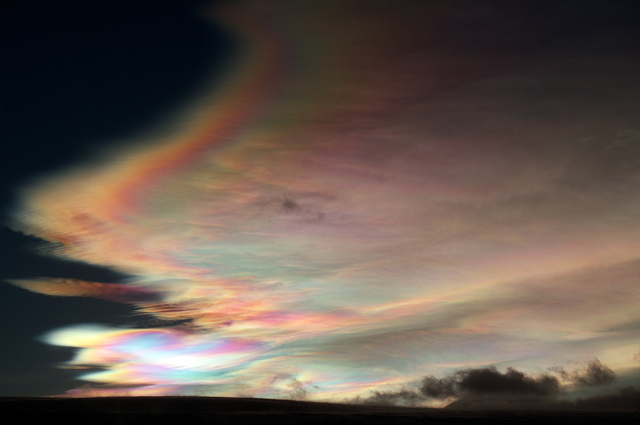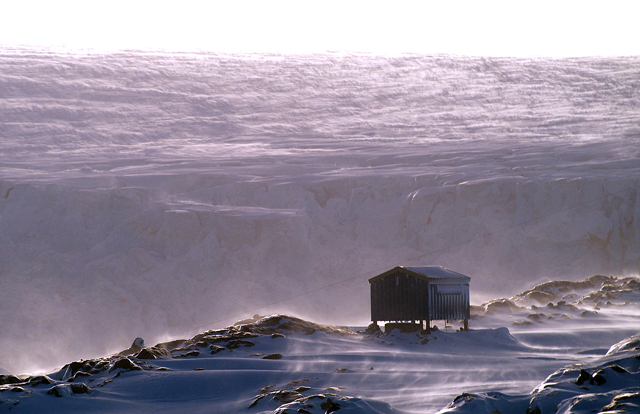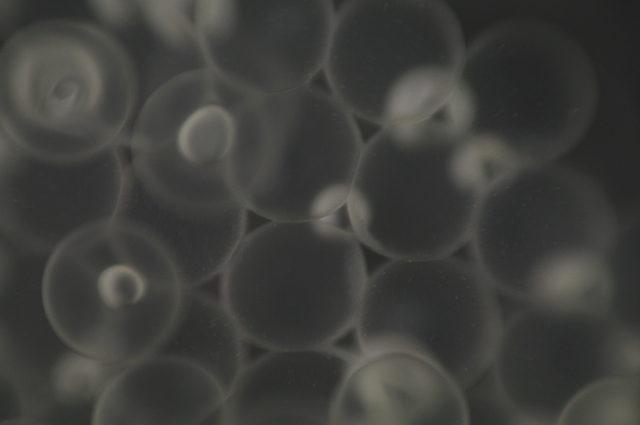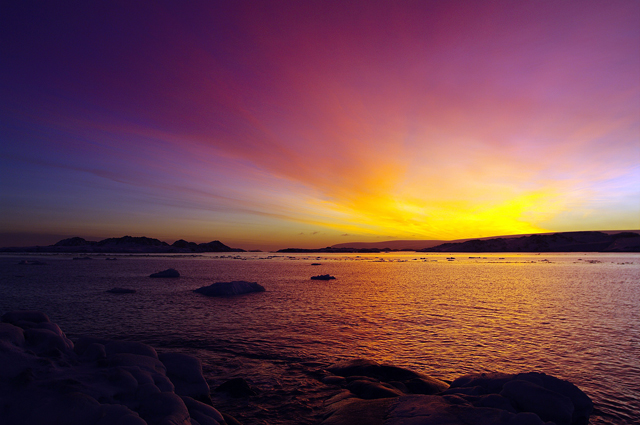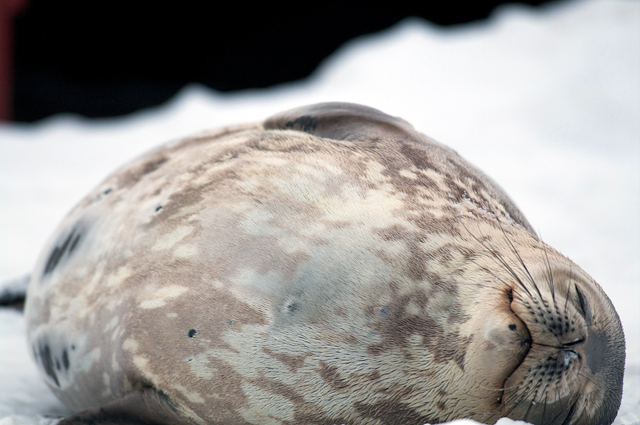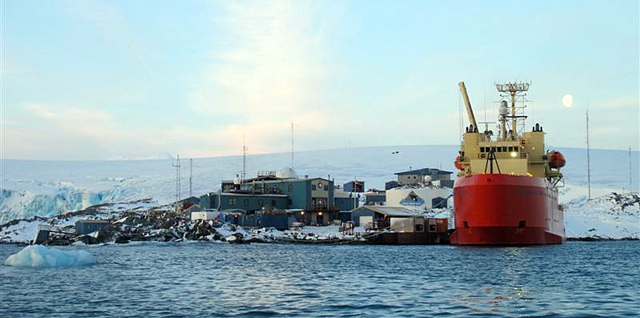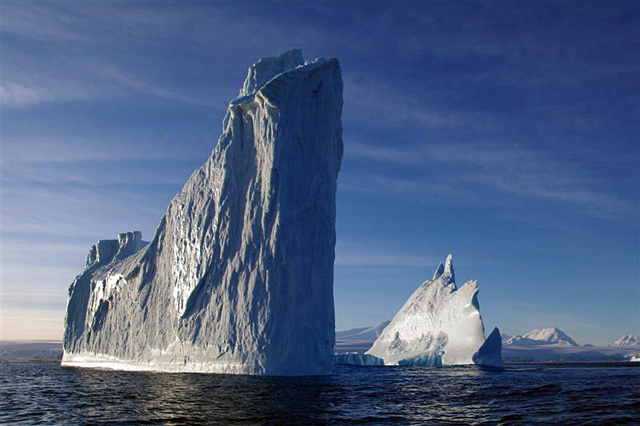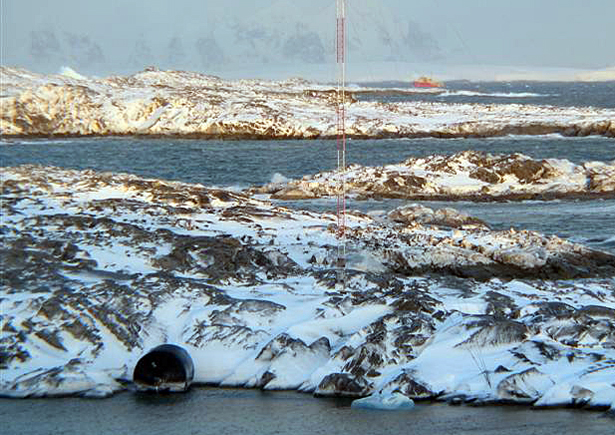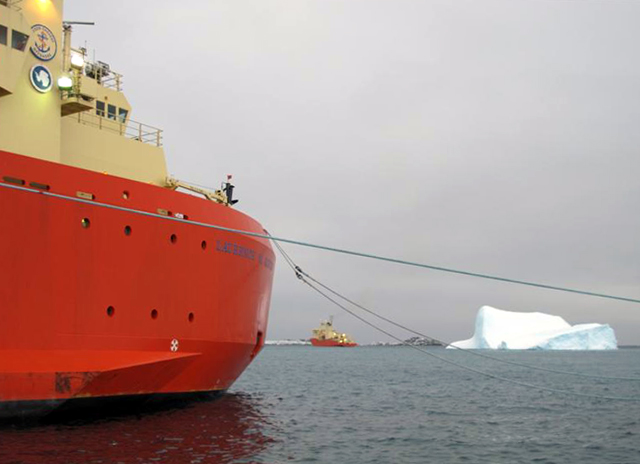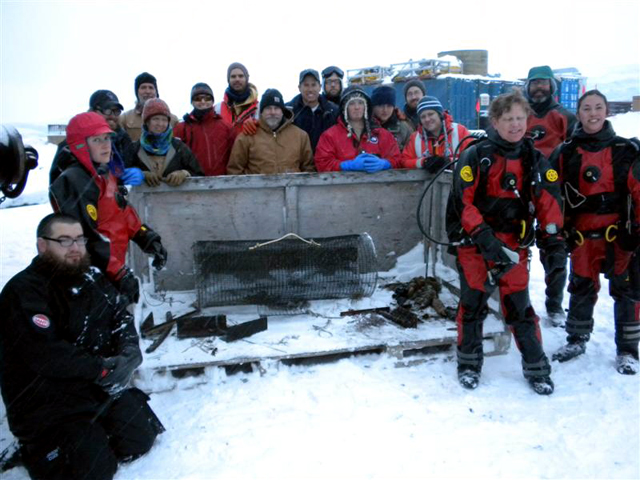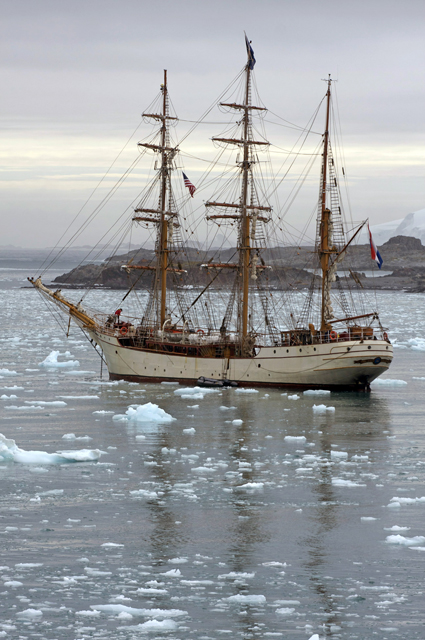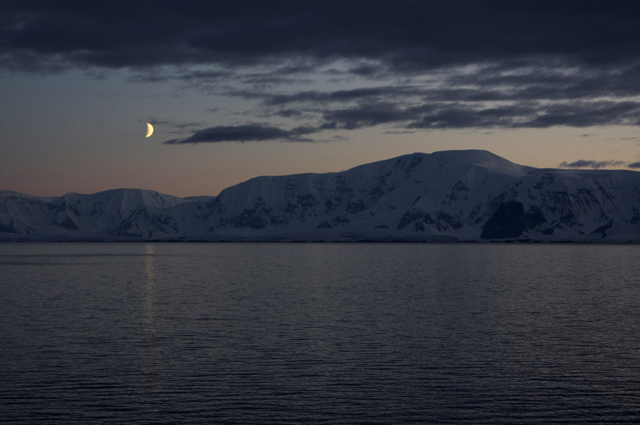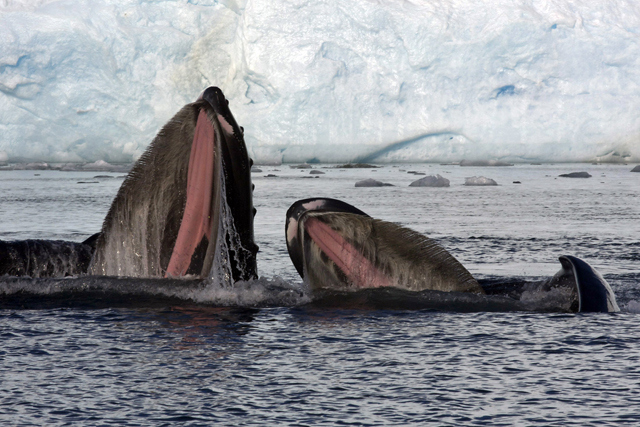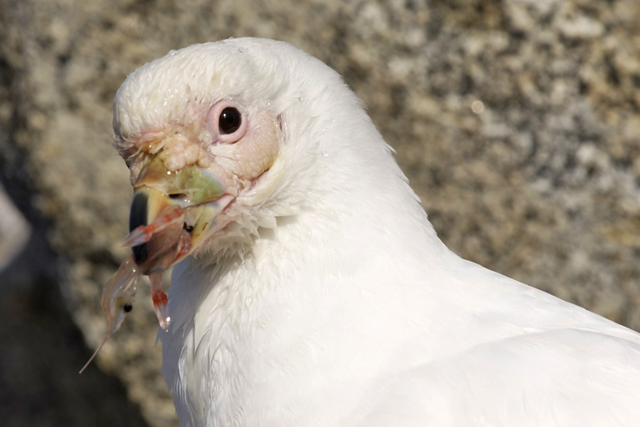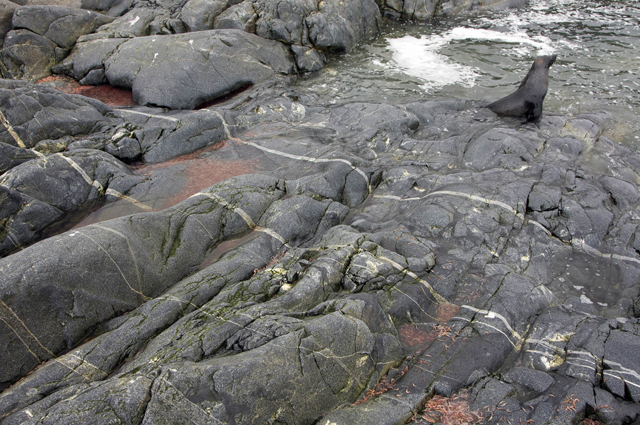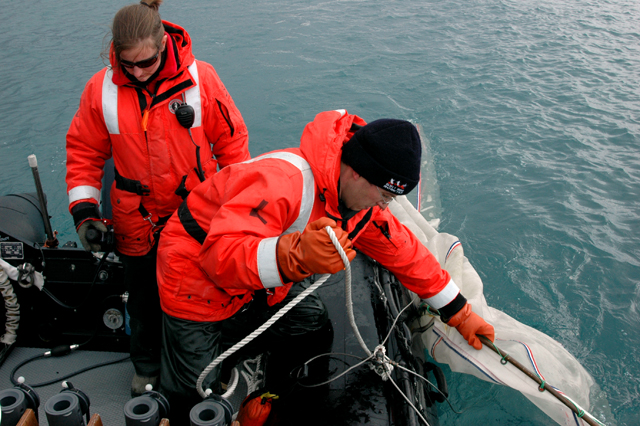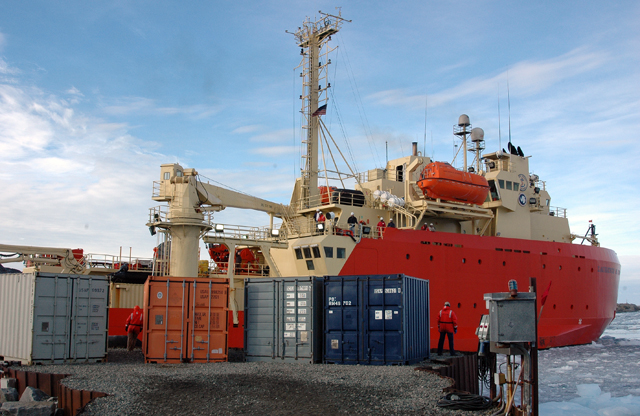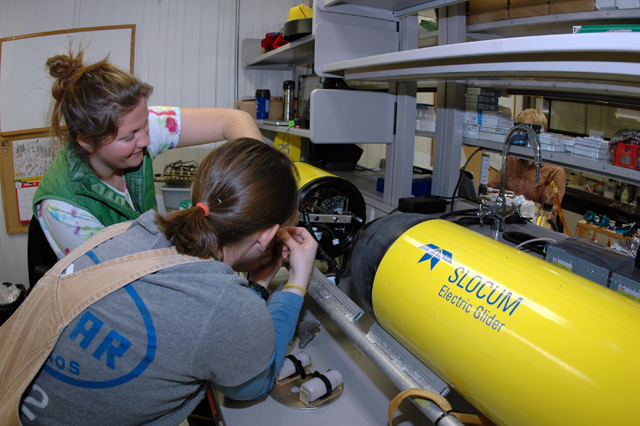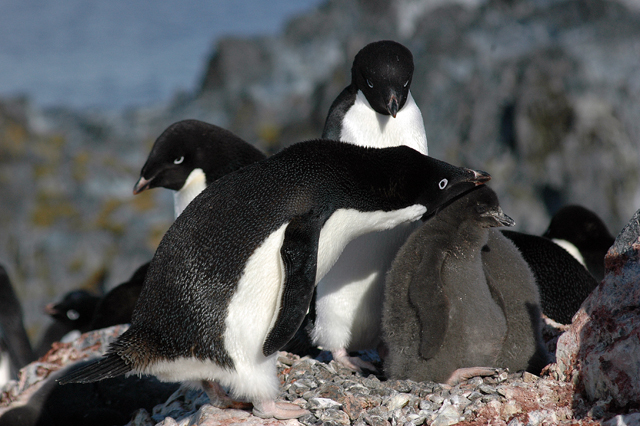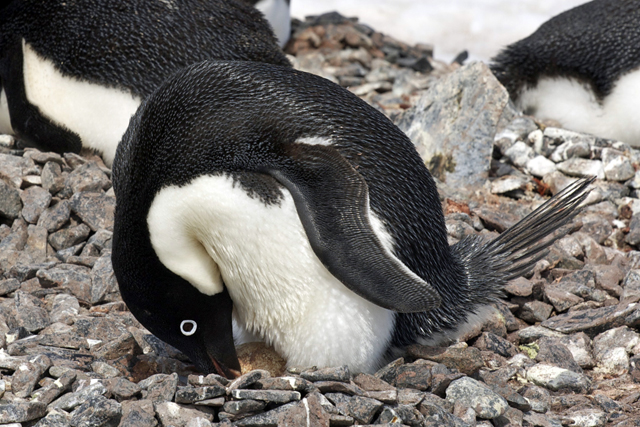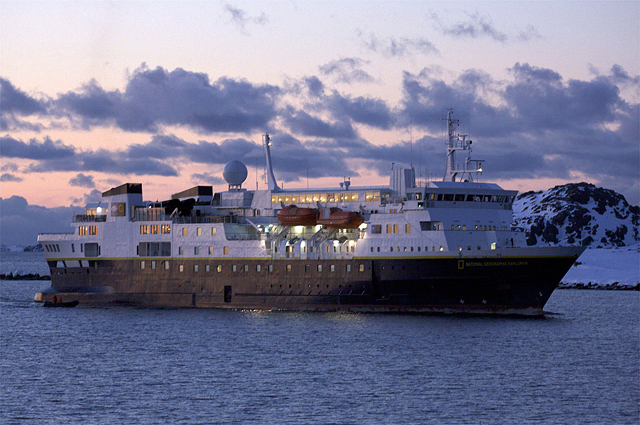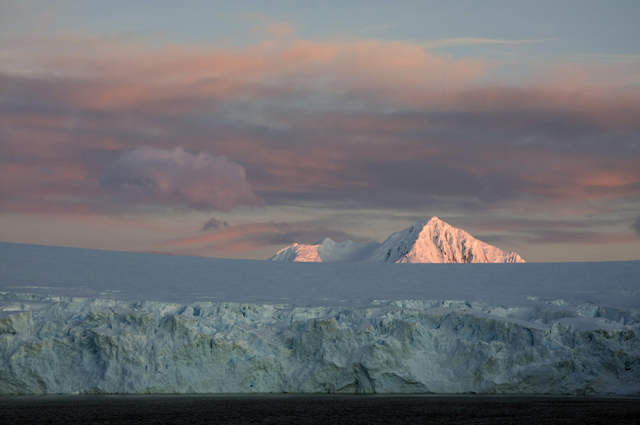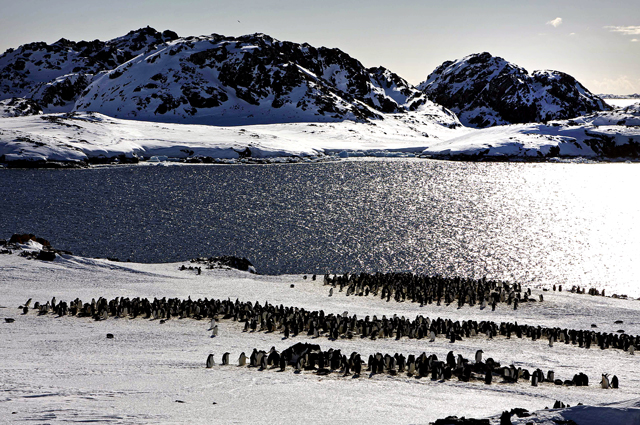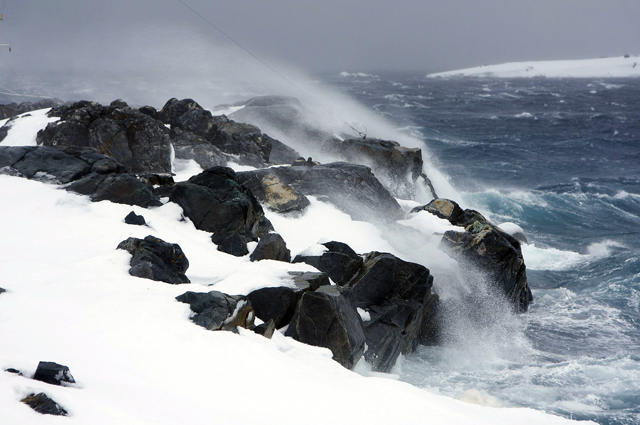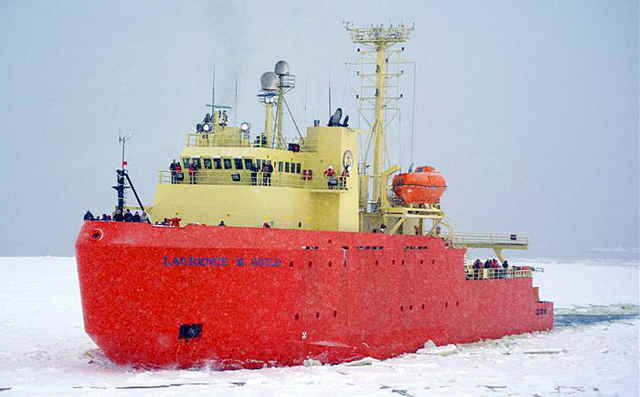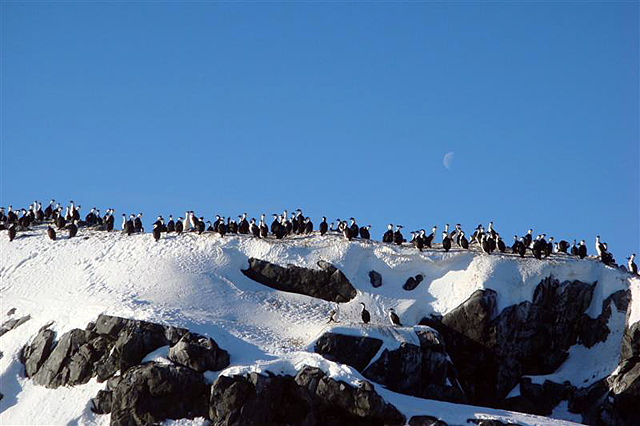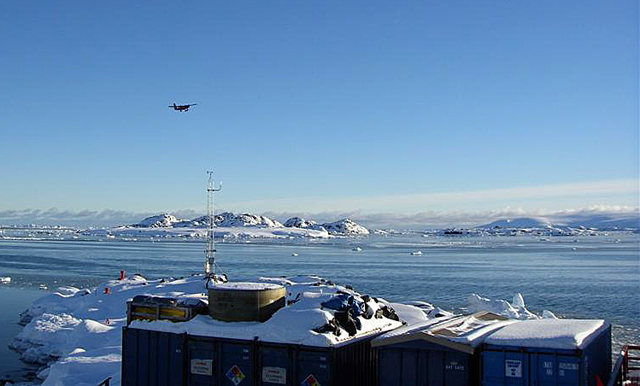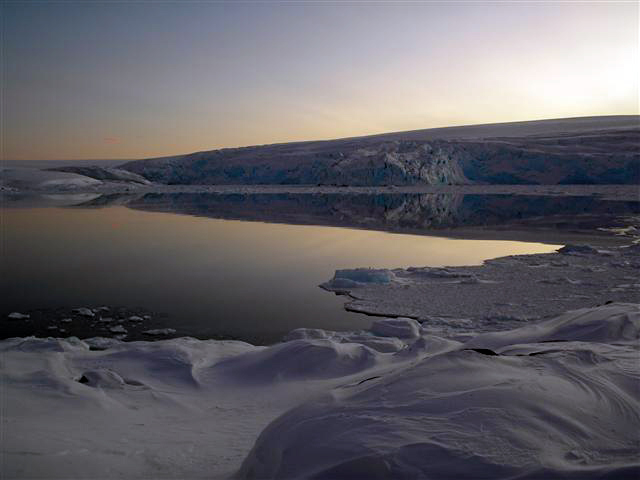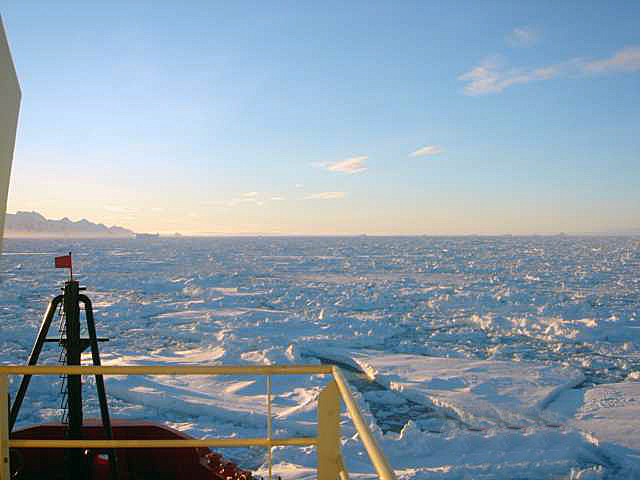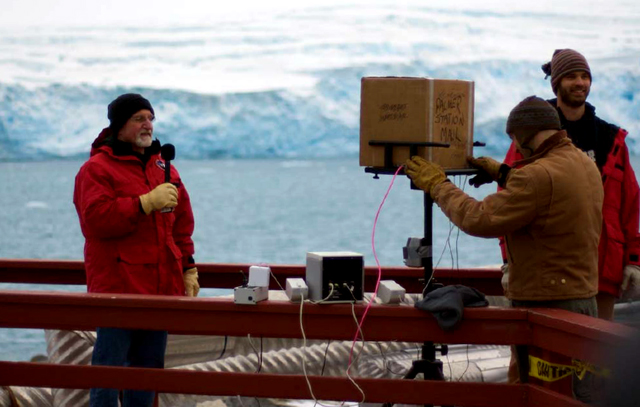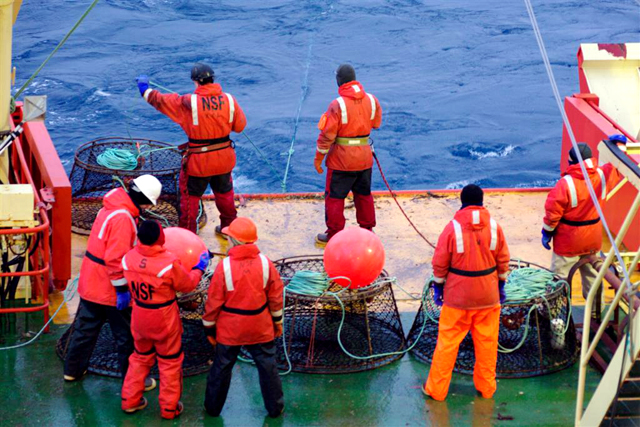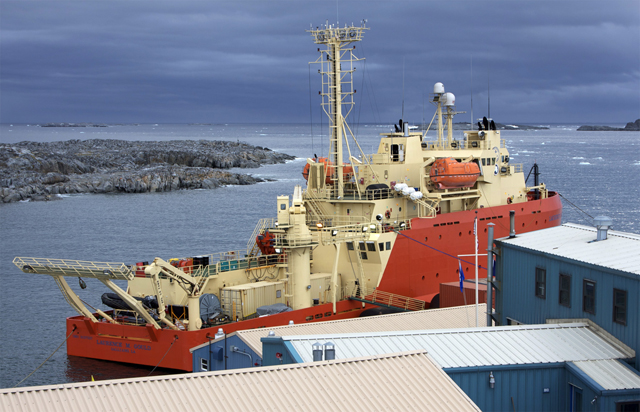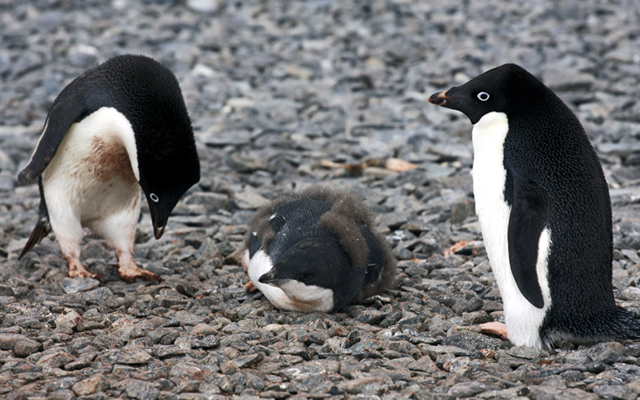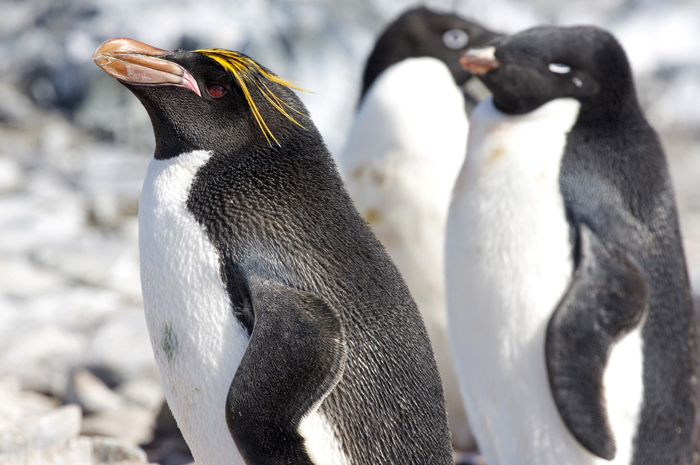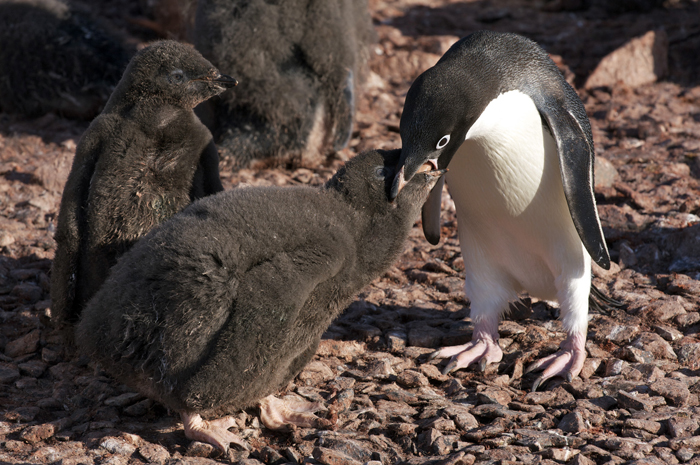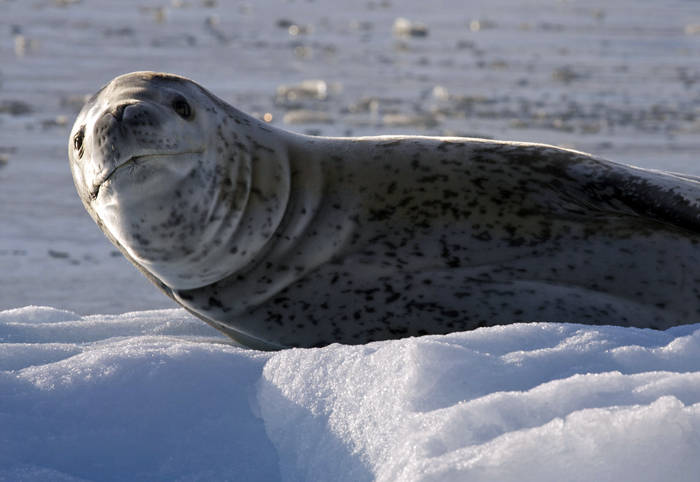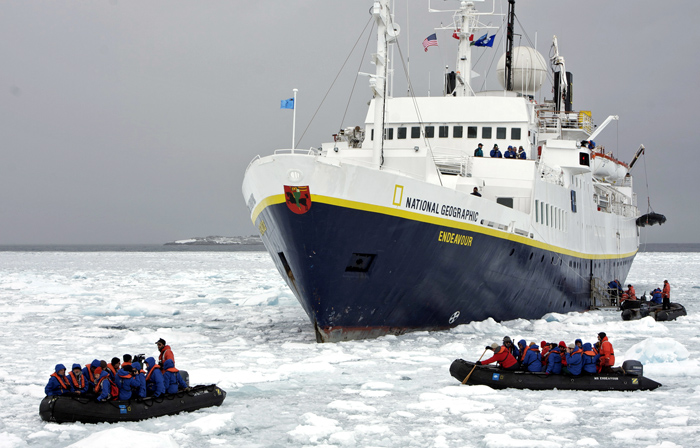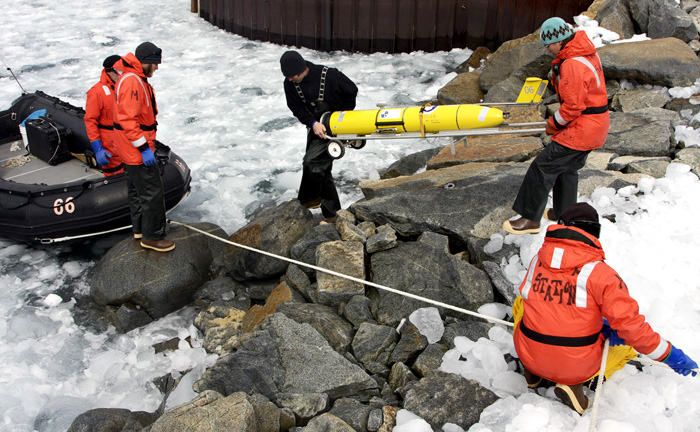|
Palmer Station Archives
August offers brief respite before summer season beginsPosted September 6, 2013
The month of August was a relatively quiet one at Palmer Station The annual sea ice set up in front of station for a whopping three weeks before strong winds blew it out for good. Most snow accumulation has blown away or simply melted out due to heavy winds and — believe it or not — rainfall during this late winter month. While this has been a mild disappointment for backyard skiers, it has been a bonus for our resident scientists who have been hopeful to collect water samples by boating all winter long. It’s also a bonus for a few recreational boating opportunities to explore around the islands and search for wildlife. It’s been a banner month for wildlife sightings. Highlights include a Weddell seal that has taken up residence in Hero Inlet behind our station; several gentoo and Adélie penguins swimming about; flocks of patrolling snow petrels and giant petrels; an elephant seal puttering around the pier; and a curious flock of some 200 cormorants that have been spotted flying around the vicinity. Meanwhile, our winterover grantees have been moving forward with new experiments in their laboratories. Urjeet Khanwalker and Ashley Nelson, working on a project led by John Postlethwait They’ve also set up a new experiment in which they are growing the embryos at warmer temperatures, around 4 degrees Celsius, instead of the regular ocean temperature of about minus 0.5C. Their hope is to uncover potential effects of warmer waters due to climate change. Scientists Sean O’Neill and Madie Willis have been looking at effects of dissolved organic matter on microbial communities for a project led by Linda Amaral Zettler at Marine Biological Laboratory Research associate Graham Tilbury reports that ultraviolet levels from the sun are increasing significantly this month due to the annual formation of the ozone hole. We’re only just a few weeks away from the arrival of our resupply vessel, the research vessel Laurence M. Gould The beginning of the end to winter season at PalmerPosted August 9, 2013
The month of July began with a delayed departure of the research vessel Laurence M. Gould The research vessel departure was delayed by five days to make more progress on the new boat ramp project. Eight construction workers, three of them divers for underwater work, were scheduled to leave on this vessel. Some of us are hoping that seals will come to enjoy the ramp for naps, but none of them have taken our offer yet. 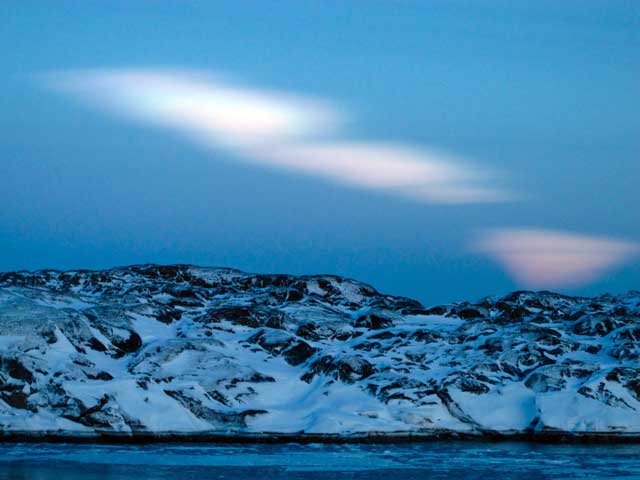
Photo Credit: Ryan Wallace
A band of iridescent clouds show up in the afternoon sky near Palmer Station.
There were 22 of us left at the station when the vessel finally departed on July 2. That day the whole station was very quiet. No more sounds of hammer drills at the pier. No more daily false alarms from fire alarm testing. No big ship blocking the view of our beautiful ocean (although we do like everyone on the ship!). The galley was empty with many more chairs than we now needed. A few days later, we had a more intimate mid-winter dinner than was possible in June, with all of us sitting at one table. Our chef prepared a wonderful meal, served by waiters with bow ties. The good food and drink led to a mellow night, with most of us probably crawling into bed early to catch up on sleep to recover from many weeks of activity. This month has been quite windy, with frequent gusts of 60 to 70 miles per hour. The winds and brash ice mostly kept us trapped at the station, as we had only two occasions for boating during the weekends. However, those two outings were blessed with happy sightings of penguins! No one saw any penguins in June, except two Adélies on June 5. On July 7, four of us headed straight to nearby Janus Island, with high hopes that some penguins were still sticking around. We were very excited when we saw eight Adélies porpoising up and down through the surface of the water. We watched them swim to and land on Janus Island. We have seen less and less wildlife lately, but nature still offers us treasures. Earlier this month, we had two days where beautiful bands of iridescent clouds showed up in the southern afternoon sky, opposite from the sun. Speaking of the sun, the daylight is getting noticeably longer, which felt a little weird, since we thought we were just starting the real winter. The temperature has been up and down, sometimes even above freezing, but we had the coldest night of the year so far on July 30 at minus 1 degree Fahrenheit (18 degrees Celsius). One of us still sleeps outside in the tent or the hut when it’s not too windy. Hero Inlet has been partly frozen for a few weeks now, and some of us envy the seals that freely crawl on top of the sea ice. Now much of the water in front of the station is frozen. Four of the winter-overs are scientists. Researchers Ashley Nelson and Urjeet Khanwalkar are continuing the studies of Antarctic fish and their embryos, while Madie Willis and Sean O’Neill are studying microbes in seawater. We are happy that the microbe group regularly heads out to collect seawater samples to keep our boating operation going – at least until the seawater froze. The fish group is observing the development of recently fertilized embryos under the microscope daily. Exciting news is that we saw the first heartbeats in the two-month-old embryos — new life to watch as spring approaches Palmer Station. Wildlife sightings grow less common in dead of winterPosted July 19, 2013
Palmer Station Members from several research groups studying everything for ocean acidification to the odd adaptation of Antarctic fish in the Southern Ocean continued their research during the entire month. Dive operations for a team led by investigators James McClintock and Chuck Amsler 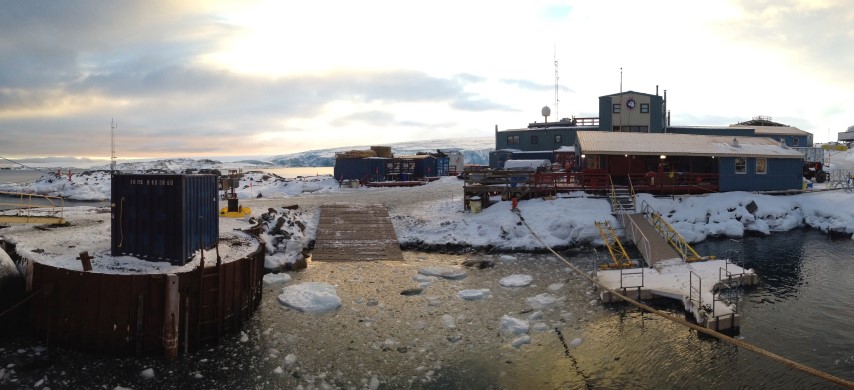
Photo Credit: Bob DeValentino/Antarctic Photo Library
Palmer Station on July 1, 2013, with a new floating pier and boat ramp.
The natural landscape surrounding Palmer Station became quieter, as wildlife populations dwindled to only the occasional sighting. Early in the month, about a dozen fur seals were spotted near the station at Bonaparte Point. Also during the first week of June, a cluster of eight elephant seals was seen huddled in a melted ice depression next to Sheathbill Cove of Amsler Island. There was one report of a leopard seal resting on floating ice near Gamage Point. Crabeater seals were also about. Several species of birds were still present during the month. A flock of more than 100 Antarctic terns were frequently observed swarming around the back of the station and resting along the Arthur Harbor shore. One or two cormorants could be seen perched on snow-covered rocks of local islands, and about a half-dozen were sighted flying by Palmer Station on the first day of June. Other bird species observed during June included Adélie penguins, giant petrels, kelp gulls, snow petrels, and snowy sheathbills. June turned out to be a relatively normal weather month at the station. Apart from a heavy snowfall on the 13th, little snow fell for the rest of the month. Very little sea ice was seen in June. The back of Hero Inlet froze over early in the month, and occasional pancake ice formed there and in Arthur Harbor during the colder days toward the end of the month. A few large ice bergs were seen from the station, but remained well offshore. The glacier fronting Arthur Harbor continued calving intermittently, though at a noticeably slower rate. This article was compiled from the June monthly Palmer Station report by Janice O’Reilly, assistant supervisor of Laboratory Operations, and research associate Graham Tilbury. Construction of boat ramp under way at Palmer StationPosted June 7, 2013
The sound of jackhammers filled the air in May, as construction of Palmer Station’s Scheduled to be completed this year, the new boat ramp will improve safety and make it easier to launch Zodiacs from Palmer. Despite cold weather and short daylight hours, a construction crew is working hard to complete the project before the summer season. In addition to increasing safety, the boat ramp will be capable of launching larger boats as well. In the world of science, Palmer Station’s research season is still going strong. Study of ocean acidification and its effect on sea life is winding down, but expected to start up again in September. Palmer’s two fish groups are busy, as they study cellular regeneration in Antarctic fish and breed them to produce embryos for further research. The arrival of the final re-supply ship for the winter was delayed, as the research vessel Laurence M. Gould Something fishy going on around Palmer StationPosted May 20, 2013
Winter has come to Palmer Station Braving the rough seas of the Southern Ocean, the first group to arrive hails from the University of Oregon Postlethwait’s team is studying the genetic and phenotypic difference between those Notothenioidei that have lightweight skeletons, such as the blackfin icefish (Chaenocephalus aceratus) and those that have normal skeletal structure yellowbelly rock cod (Notothenia coriiceps). The goal of this study is to find those genetic pathways the may be related to bone loss due to aging in humans. [See previous article — Raising Notothenioidei: Scientists successfully develop icefish embryos for evolutionary studies.] The second group to arrive is headed by Kristin O'Brien 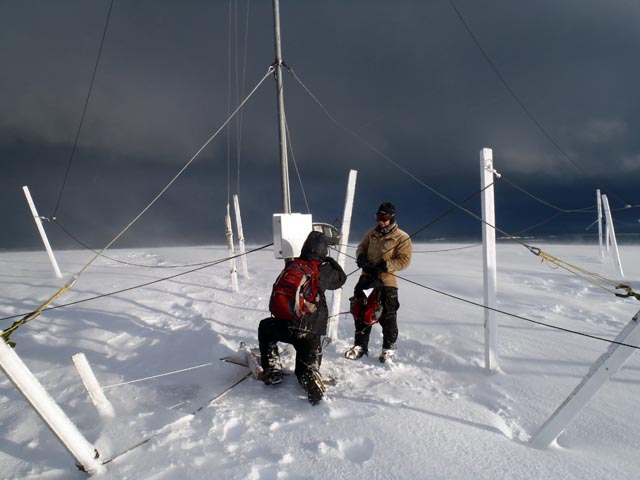
Photo Credit: Yuki Takahashi
Scientists work on a very low frequency antenna for observing lightning and related phenomena.
The goal of this study is to determine whether those Antarctic icefish that lack hemoglobin enjoy an advantage in comparison to red-blooded fish in the frigid waters around Antarctica. In addition to the new science groups that have arrived this season, Palmer continues to support the ongoing research into ocean acidification and its effects on native Antarctic organisms. Headed by long-time science mainstays, Chuck Amsler and James McClintock Palmer also played host to two short-term science projects: One study involved permafrost, which covers a number of islands near Palmer Station, and the amount of loss caused by climatic warming trends. The other research looked at lightning in the ionosphere and other electrical phenomenon that can be observed with low-frequency antennas. Despite the cold weather, and shortening daylight hours, there is no stopping the research taking place on the Antarctic Peninsula and Palmer Station Palmer Station prepped and ready for winter seasonPosted April 12, 2013
The biggest change at Palmer Station The fish are scientific specimens for a study looking at bone loss and osteoporosis. Some fish in the Southern Ocean have evolved with almost no red blood cells and lightweight skeletons that mimic the disease known as osteoporosis. Scientists hope to isolate the genes that helped these icefish adapt to the cold Antarctica waters differently than other closely related fish. Research may eventually help with treatments for bone loss in humans. Bill Detrich from Northeastern University In addition to crew turnover, the first steps in building the Palmer boat ramp began in March. Earlier this year, a floating dock was built. [See previous article — Docked: New pier built at Palmer Station for small boat operations.] The next phase of the project to make small-boating operations safer at Palmer involves installing a ramp over the coming months. The area leading to the shoreline needs to be leveled out as part of the preparations for the boat ramp installation. While some of the rocks can be moved around with the loader bucket, others need to be smashed with power hammers and broken up into much smaller pieces. This work is being done concurrently with the normal boating operations by researchers, so great care and coordination between the construction crew and the science teams on station are needed to be sure that they can all take care of the work that needs to be done. Part of the preparations to get the station ready for winter took place on the glacier behind Palmer Station. Personnel ensured the boundary flag line was well marked on the glacier, which is a popular place for hiking and skiing, as well as glacier rescue training. Due to the rapid retreat and melting of the glacier, new crevasses form fairly quickly and the flag holes melt out, making safe travel harder to identify. In addition to making travel tricky, melting has also been causing problems with the radio repeater and VLF antenna on the top of the glacier. Several trips were made to drill new holes to improve the stability of both the VLF and radio antenna. In addition to fishing expeditions, the Gould made a side trip to the nearby Ukrainian station Vernadsky The summer crew will find themselves sailing north shortly, with the station in the capable hands of the new winter crew. Signs of winter approaching at Palmer StationPosted March 8, 2013
As February came to a close at Palmer Station The research vessel Laurence M. Gould However, a few research teams still remain, and we welcomed a new group to the station in mid-February with a long history in the U.S. Antarctic Program Amsler Island is located just across Arthur Harbor from Palmer Station. It is home to what is now referred to as Old Palmer. It was at Old Palmer where U.S. Navy personnel lived while constructing the current station. While on station, the team will continue its research on ocean acidification. [See previous article — Perfect storm: Add ocean acidification to the list of threats faced by the Antarctic Peninsula.] The whale research team led by Duke University The vast majority of Adélies and other penguin species have left the Palmer area. There are no more penguins viewable on the Torgersen Island penguin webcam In early February, a helicopter based off of the Chilean naval ship Aquiles visited Palmer Station. On board the helicopter was a scientist who was collecting samples of the grasses that grow in the Palmer area. A second visit by the Chileans later in February involved not a helicopter but a fly-by from an airplane. Palmer also hosted the last of the scheduled cruise ships for the season, along with several yachts. Not all visits to Palmer are by cruise ship; private or chartered yachts also occasionally visit the station. One such yacht was the S/Y Quijote, a 40-foot, steel-hulled boat hand-built by the captain. Two ships support Palmer LTER program in JanuaryPosted February 15, 2013
January at Palmer Station During the annual LTER cruise, the Gould spends a month following nearly the same grid pattern in the ocean that was set up in the fall of 1990 when the program was established. The ability to sample the same places for the past 23 years — though the study area was expanded farther south several years ago — means the data scientists collect can offer insights into the long-term environmental trends under way in the area. Oceanographic, atmospheric and sea ice data give researchers an idea of the impact of the sea ice coverage on the overall ecosystem. On the biological side, researchers study top predators like penguins and seals, along with the rest of the polar food web, from shrimp-like krill to the bacteria in the ocean. While the ship is out during the LTER cruise, there is still a lot of fieldwork near the station around Anvers Island. Some samples are collected in conjunction with the LTER cruise to contrast the regional changes against a more concentrated area. The Gould wasn’t the only research vessel (R/V) at Palmer supporting science in January. Near the end of the month, the R/V Point Sur The group, under a project led by David Barbeau Because they were unable to put in at any of the field locations, the team ended up having to set up tents at Palmer Station until the end of the LTER cruise because the station had reached its maximum population of 44. The Point Sur will also support scientists led by a team from Duke University January has also been a busy month for visitors. We had visits from both the Chilean and British navies. A number of tourist cruise ships also came and went. The cruise ships that visit Palmer range from small yachts to large 1,300-passenger ships. The number of passengers dictates how we handle a visit. If there are more than 200 aboard, then station personnel go out to visit the ship and give a presentation about the science that the U.S. Antarctic Program Wildlife was fairly active in January. There are several sheathbill nests on station with chicks that hatched. The Adélie penguin chicks have grown to about the size of the adults, and they are in the process of losing their soft, downy feathers. [Check out the penguin cam at Torgersen Island The summer science season still has a few more months left before winter starts. But the coming colder, dark months promise to be as busy as a typical summer season. Palmer Station hosts visitors large and small in DecemberPosted January 4, 2013
December was full of visitors at Palmer Station The month started off with a short, two-day visit from the Gould. Aboard the ship was a team that heads the company charged with running the logistics contract for the National Science Foundation (NSF) Parazynski is a former NASA Shortly after the departure of the Gould, Palmer had its first cruise ship visit with the National Geographic Explorer. There are only a limited number of such tourist ships that can visit the research station each year. In order to visit, the ship needs to put a request in through the NSF. This keeps station services from being constantly interrupted by a continued stream of visitors. Cruise ships with less than 200 passengers are able to visit Palmer directly. Station personnel guide the visitors on a walking tour, talking about everything from how fresh water is made to the research under way and recreational opportunities. And, of course, we talk up the famous Palmer brownies that wait in the station dining hall (referred to as the galley), which is turned into a temporary visitor center where guests can interact with station science and support personnel. If a cruise ship has more than 200 passengers aboard, Palmer personnel will visit the vessel via Zodiac. The passengers are treated to a presentation about the station activities, along with a meet and greet with the station staff and scientists. The only other cruise ship to visit Palmer during December was the Le Boreal. This is part of a special yearly visit when the guests on the cruise donate a gift to the scientists of the Palmer Long Term Ecological Research (LTER) The gift this year was for a Penguin-Cam that will be installed on Torgersen Island. Once the camera is set up, people from around the world will be able to view the Adélie penguin population online. The camera will also allow for scientists to give talks in real-time with classrooms back in the United States and other locations worldwide. There was also a visit from the ice patrol ship the HMS Protector, formerly the MV Polarbjorn. The visit from the Protector was not just a friendly visit but also an official one. A group from the ship came to station to perform an official Antarctic Treaty Shortly after the Protector departed station, a ship from the Chilean navy paid an informal, friendly visit. About 30 crewmen came ashore for a tour of the station. The crew left us several gifts, including a book about the Chilean navy, an updated picture of their ship, and several other items from their homeland. December was also a big month for wildlife. The Adélie eggs on Torgersen have started to hatch, filling the air with chirps from the little chicks. The krill in the waters near Palmer have just exploded, feasting on the phytoplankton blooms. The abundance of krill has drawn many whales to feed in the area. So far, we have spotted mostly humpback and minke whales. On Christmas day, many of us had an opportunity to observe a pair of humpbacks feeding around Bonaparte Point. The next day, possibly the same two whales were seen feeding just off of the seawater intake pump house, right next to the station. The holiday celebrations at Palmer were fairly laid back, with a gift exchange and a family style meal. Most people took advantage of the down time to call home and talk to family and friends. It was a quiet and reserved end to a fairly busy month, but it is looking like January will be an even busier month. Palmer Station ramps up dock work; skuas raid Adélie nests for eggsPosted December 14, 2012
November passed by fairly quickly at Palmer Station Some of the new arrivals began prep work for a new boat ramp and floating dock that will support Zodiac operations. The installation will occur in two phases. The first, which started last month, should be completed before Christmas, and the second phase will start later in the summer and continue into the winter. Currently, supports and an anchoring system are being installed for the floating dock, and some grading work will be done for the ramp. In order to install the supports for the floating ramp, the crew spent part of the month digging through as much as six feet of accumulated snow and ice before getting down to the rocky shore. Once they crew reached bare rock, they chipped and drilled away to bring it down to a level work area. The anchor bolts had to be installed early in the morning to prevent the melting snow from filling the holes with water and preventing the epoxy from holding the bolts in place. Another member of the research team from Rutgers University The Adélie penguins on nearby Torgerson Island now have eggs in their nests. That has brought several opportunistic skuas to the area to wait for their chance to swoop in and steal any penguin eggs that they can. Broken eggs can be found scattered all over the island in the snow. The Adélie penguin population continues to shrink each year on Torgerson, due to ongoing climate changes documented by scientists here. Several penguin colonies consist of just a few pairs or a pair of penguins. This makes them especially vulnerable to skua attacks, putting the colony at an even greater risk of disappearing. Improving summer weather has allowed researchers to start making regular visits to both Dream Island and Biscoe Point to observe the penguin populations in those areas. Just like back home in the United States, Palmer Station celebrated Thanksgiving near the end of November. There where two turkeys and a ham made for the meal. One of the turkeys was meticulously smoked by two station support members overnight leading up to the feast, and it was particularly tasty. There was stuffing and cranberry sauce, as to be expected, and even some cranberry relish. And there were 14 homemade pies for the crew of 38 people. There was more than enough food for everyone, though it didn’t last long in the leftover fridge. The ground was still covered with snow by the end of November, with random snow showers still coming though. The new snow would soon melt in the blazing sunshine, along with the existing snow piles, turning the roads into a wet mush. With the Gould scheduled to arrive at the start of December, and the upcoming cruise ship visits, November may be the last calm month of the summer season here at Palmer. Science regroups for summer field season at Palmer StationPosted November 21, 2012
October started with just one science group at Palmer Station To reach the U.S. Antarctic Program’s After putting in a field camp on King George Island farther north, the Gould made its way down the Antarctic Peninsula, only to be slowed down considerably by sea ice on the southern side of Anvers Island. The ship had to ram a path through the ice to get to the station. This turned out to be very time- and fuel-intensive, as the ice was heavily packed, turning a two-hour transit into a nine-hour ordeal. 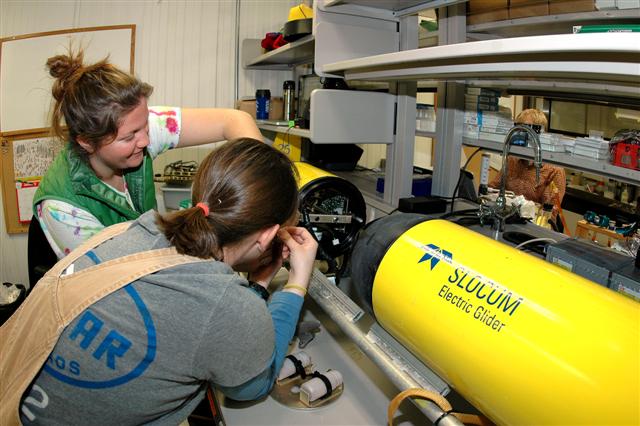
Photo Credit: Peter Rejcek/Antarctic Photo Library
Scientists with Rutgers University prepare a glider for deployment during a previous field season.
The science groups that arrived represent a variety of polar biological research interests, ranging from the smallest marine organisms to the iconic Adélie penguins. The latter are disappearing from the region due to climate change. A group led by co-principal investigator (PI) Philippe Tortell They will also study the seasonal changes in phytoplankton photosynthesis, and conduct controlled experiments to see how a change in carbon dioxide levels may affect phytoplankton. This is the first time the group has worked on station. Much of their time spent over the first few weeks involved setting up their instruments, with limited sampling in the ocean due to the persistent sea ice. PI Shelley Bench from Stanford University Team members with the seabird component of the Palmer Long Term Ecological Research (LTER) Another team from the Palmer LTER, headed by Oscar Schofield at Rutgers University 
Photo Credit: Sean Bonnette
Scientist Sven Kranz navigates around the Palmer Station area to collect water samples for a project studying phytoplankton.
A couple of scientists will be at Palmer through March for the microbial biology study that is part of the Palmer LTER that Hugh Ducklow Ducklow is also the PI for a separate project in which one scientist will be at the station to take water samples in an effort to understand the production and export of organic matter from the surface of the ocean to the seafloor in the coastal Antarctic marine ecosystem. Even with all the science work going on, personnel still found time to have a Halloween party. The variety of costumes ranged from inspired scientific puns, to clowns, superheroes, and even some animals. The station science personnel skillfully decorated the bar with cobwebs, spiders and even a giant flying bat. It was a very fun way to end the month. This was a colder-than-average October. More snow accumulated, though the exact amount of was hard to measure. The wind did a very good job of blowing it all over station, and caused several drifts that measured several feet in depth. The sea ice broke up at the end of October, allowing the science groups to leave station and do their sampling. This also gave rise to the hope that winter would finally give up its icy grip on the area, and spring would kick into gear. Palmer Station bumps up against some work on the pierPosted October 19, 2012
September brought major changes to Palmer Station With the arrival of the Gould, the once quiet station was thrown into top gear. One of the first issues that needed to be addressed was installing some extra pier bumpers to the existing ones so the ship would sit farther away. 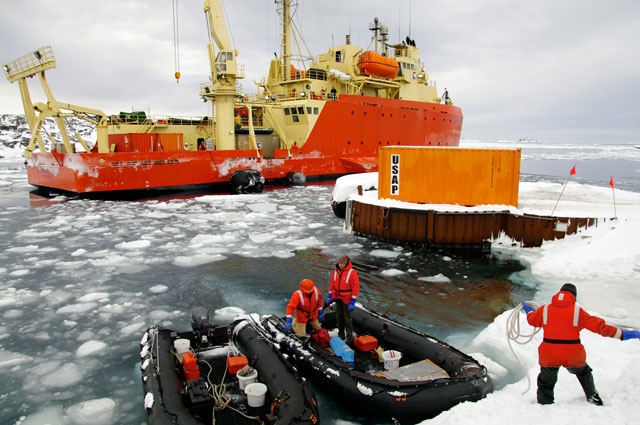
Photo Credit: Sean Bonnette
Palmer Station personnel and the LMG crew unload new bumpers for the pier.
While in dry dock earlier this year, a dent was found on the underside of the Gould that was determined to be from a ledge near the Palmer pier. To keep the ship from being damaged after the repair, it would need to be kept farther away from the pier. In the warehouse in Punta Arenas, Chile, there was a single bumper — but that alone wouldn’t space the boat out far enough. A second bumper was sourced locally in Punta Arenas from a field near the airport. Shortly after arriving in Hero Inlet, the Gould lowered down both bumpers so that they could be secured into place. After the bumpers were in place and secure, the ship was able to tie up to the pier with no issues. The weather for the cargo operations was very cooperative. Milvan containers were swung from ship to shore with no issues, and then several were swung back to the ship full of waste and northbound cargo. Two incoming milvans were full of the station’s resupply of food for the summer season, ranging from cuts of beef to juice concentrate, frozen veggies, and even ice cream. Normally, with the first boat of the season, the Gould would also offload fuel, but that has been postponed for later in the summer. The entire port call lasted six days, during which the winter crew turned over their jobs and emergency response duties to the summer team. This made for a very busy port schedule. In addition to their regular duties, all personnel also serve on one or more emergency teams, including fire, glacier search and rescue and ocean search and rescue. Turnover for the fire team included a drill. Before anyone knew it, the port call was over, and the summer crew found itself at the end of the Palmer pier, waving goodbye to their northbound counterparts. Normally, at this point, the station crew would perform a traditional jump off the pier, wishing the northbound bunch a safe trip, but the brash ice closed in behind the Gould as it left. For this trip north, well wishes and enthusiastic hand-waving would have to suffice. Palmer Station begins transition to new seasonPosted September 14, 2012
August was a month of transition at Palmer Station The first weekend of August was busy. Not just from work obligations but due to the rush to write, shoot and edit a short film for the 48-hour movie category in the annual Antarctic Winter International Film Festival (WIFF). To ensure that the films would be made over the weekend, there was a list of required items that each submitted film needed to have. There were a large number of films from most of the crewed Antarctic stations, and Palmer submitted two films, with nearly everyone getting involved. One of the films revolved around the everyday interactions between the crew and the things that they might end up saying in their heads when small community annoyances come up. The other movie was a short sub-one-minute film focused solely on making no sense and included the five required items with improvisational acting. While neither film received enough votes to come out as an overall winner, everyone involved agreed it was a great time making them. Science has ramped down but still moves forward with two researchers who are continuing winter work on Antarctic fish embryos. The scientists have wrapped up experiments and are preparing samples to send north at the end of September. It was a windy month, with temperatures staying in the 20s on average. There were also a few colder days that hovered around 0F for highs, before spiking to around 40F. This left the winter-over population wondering if the temperatures would stay this high for the remainder of the winter. Well, they didn’t. After having an unseasonably warm week, the temperatures returned to normal, dropping back into the 20s. As August came to a close, it wasn’t uncommon to spot large flocks of cormorants flying in formation in the area around Palmer. There have also been more sheathbills and petrels flying in the air. Even a minke whale was spotted near the station, despite a thin layer of sea ice. The last weekend of the month brought the winter-overs together to show off art and other creative projects that they had worked on over the previous months. Projects ranged from paintings to wood sculptures to knitted items and even an ice sculpture. The amount of projects on display filled up the station galley. In just a few short weeks, with the end of August, the majority of those now on station will make their way north, and the summer science season will begin. Early spring cleaning occupies crew at Palmer StationPosted August 10, 2012
July was a windy month at Palmer Station As nice as fireworks would have been, Independence Day festivities relied more on BBQ and patriotic cupcakes. Compared to the midwinter celebration a few weeks before, the party for the Fourth was fairly laid back and relaxed. Another section of the aquarium is being cleaned and updated, as part of a renovation project that started last winter. The work includes cleaning the existing electrical installation and recessing it in the wall. The wall will also get a water-resistant covering that will help it to hold up better in the wet-lab environment. The garage area is also undergoing a thorough cleaning, along with reorganization. Home to both Logistics and the heavy shop, the garage is one of the busiest spots on station. The floor and walls are being repainted and work centers reorganized to make better use of the limited space shared by two departments. Years of accumulation, like in any garage, were cleaned out, leaving even more space than from reorganization alone. Wildlife sightings of seals and birds were down from June. Several leopard seals have been spotted on ice floes in Arthur Harbor. Sheathbills continue to hang around the area. Much like pigeons in the city, they can be found scrounging for any food they can find. There hasn’t been much noticeable sea ice buildup so far at Palmer this season. There has been a few times where the threat of being iced in neared. But without fail, the winds would pick up and blow the ice out to sea over the course of a few days. Much to the chagrin of station residents trying to take time-lapse footage, this would usually take place overnight in the dark. Direct sunlight returned to Palmer in July. Despite being out of view for only about a month, the return of the sun was a welcome sight. And with the cooperation of the winds and clouds, there have been several spectacular sunrises and sunsets viewable from station. Emergency teams continued with their training last month. In addition to his or her regular job duties, everyone wintering at Palmer is also on at least one emergency team. Besides fire and trauma teams, Palmer also boasts a Glacier Search and Rescue (GSAR) squad and an Ocean Search and Rescue (OSAR) team. Ready for just about any emergency — but hoping that they don’t need to respond — the teams help keep the winter- over crew involved and the station safe. The winter season at Palmer is two-thirds complete. With two months left, there is still plenty of time for the sea ice to form and maybe enable some travel to the nearby islands without the use of inflatable boats. Maybe. Palmer grows quiet in winter as researchers, widlife leave areaPosted July 20, 2012
June was a transition month at Palmer Station 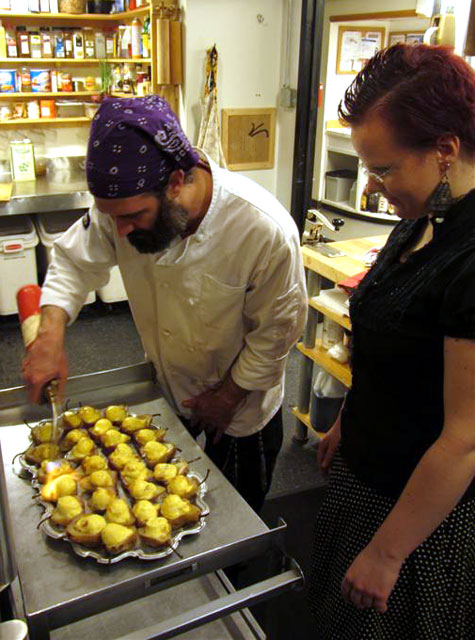
Photo Credit: Janice O'Reilly
Russell Freeman and Irina Mueller prep crème brulee for dessert at the Midwinter dinner at Palmer.
Two scientists from research groups led by Bill Detrich at Northeastern University In the week leading up to Midwinter, a special Antarctic holiday that celebrates the winter solstice, the Gould was loaded up with the rest of the northbound hazardous waste collected at Palmer during the last two years. Every two years, all the hazardous waste onsite at Palmer is packaged into milvans and loaded into the cargo bay of the Gould to begin a month-long journey north to Port Fourchon, La., for disposal. To prepare the waste to be loaded, U.S. Antarctic Program (USAP) The Gould departed on Midwinter morning, giving the remaining winter-overs just enough time to celebrate with a family-style meal prepared by chef Russell Freeman, with help from various station members. The size of the wintering crew meant that just about everyone had a hand in the preparations for this important celebration. 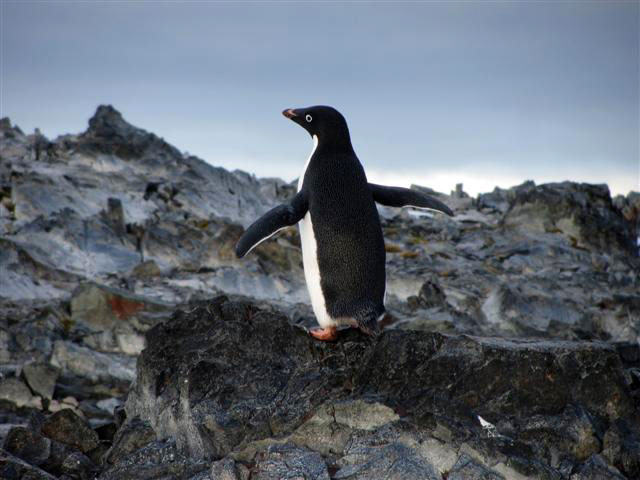
Photo Credit: Janice O'Reilly/Antarctic Photo Library
A lone Adélie penguin on Torgersen Island near Palmer Station in May 2012.
The festivities lasted late into the evening, with stories of past seasons and laughter shared by the Palmer community. A few days later, various station members plunged off the pier into the ice-cold waters for a belated tradition to celebrate the lengthening days to come. The wildlife population around Palmer has decreased dramatically over the past month. Despite best efforts to locate them, it appears that the penguins that were remaining on the outlying islands have moved on for the winter. In their absence, there are still plenty of elephant seals, along with fur and leopard seals. There were also several minke whale sightings in the waters around station. For the better part of the next three months, the crew at Palmer will be isolated, with no ship traffic. Not to worry, though; we are well prepared and there are winter projects to keep us busy before summer field season returns. Science wrapping up for 2011-12 season at Palmer StationPosted June 22, 2012
Science labs bustled with activity during May at Palmer Station Research divers collecting samples for ocean acidification studies in the station lab completed their work last month. The study, led by Charles Amsler and James McClintock The lone grantee on station for an unrelated project looking at the ecology of Belgica antarctica, the only free-living insect found on Antarctica, also wrapped up his season’s research. Belgica larvae undergo extreme stress, including freezing of body fluids and dehydration. The researchers, led by Richard Lee at Miami University Other research under way at Palmer included various studies related to the ecology of Antarctica’s unique species of icefish, and a project sampling the microbes that live in the ocean that get energy from both organic matter and sunlight, called photoheterotrophs. Palmer Station felt the beginning of winter during May, as daylight hours shortened and temperatures dropped. However, populations of penguins could still be observed, some busily transferring pebbles. Interestingly, Adélie penguins were observed on the north and south sides of nearby Torgersen Island on three different occasions. Gentoo penguins were sometimes observed swimming in the open water near the station. Early in the month, three chinstrap penguins were identified on Nightmare Island during a combined operation for the survival cache swap on Dream Island for ocean search and rescue (OSAR) operations, and science support fieldwork for obtaining GPS reference points for the Polar Geospatial Center at the University of Minnesota. Other bird populations observed during the month included blue-eyed shags, kelp gulls, Wilson’s storm petrels, snowy sheathbills, and giant petrels (adults and grown chicks). A small group of terns (unidentified) continued to congregate at the far shore of Arthur Harbor near the glacier behind the station. Fur, elephant, crabeater and leopard seals were still present in the Palmer vicinity. A group of humpback whales was seen by the OSAR team near Halfway Island. As noted earlier, May was relatively mild, but as temperatures started to drop, the cold was counterbalanced by many great sunrises and sunsets that illuminated the mountains to the south. Except for some gusty days in the middle of the month, May was a fairly calm month. Very little sea ice was seen, with only a couple of days of heavy brash ice passing through. One iceberg came into view near month’s end. The glacier was heard calving several times during the warmer, rainy days. There was a healthy coating of snow blanketing Palmer Station heading into June. This story mostly compiled from reports by Janice O’Reilly, Winter Assistant Supervisor of Lab Operations, and research associate Neal Scheibe. Something fishy happening around Palmer StationPosted May 18, 2012
Fish! That’s what it’s all about here at Palmer Station The station’s laboratories are full of scientists — the majority of them studying the exotic fish that swim in the frigid Antarctic waters of the Southern Ocean. The aquariums are filled with the icefish Chaenocephalus aceratus, which are fascinating due to the lack of oxygen-carrying hemoglobin in their blood, and also the ever-curious, red-blooded rock cod Notothenia Coriiceps. The research vessel Laurence M. Gould Each return by the Gould brought six large totes filled with new fish that were caught by fishing pots and benthic trawls around Dallman Bay to the north of Anvers Island where Palmer Station is located. Fish were also caught from Crystal Sound near the Antarctic Circle. After careful transfer of the fish to our aquariums, the scientists collect tissues from the specimens and also prepare them for in vitro fertilization to produce embryos. One of the biologists’ main goals this season is to examine how the embryos grow at elevated temperatures and in different conditions. Station science also included our two dive researchers from the University of Alabama at Birmingham Scientist Yuta Kawarasaki from Miami University Lastly, two members of the support staff on station have been assisting our bird researchers, Bill Fraser and Donna Patterson, with late-season weight measurements of giant petrel chicks on nearby Humble Island. These remarkable and majestic birds are born in January and fledge in May, just as the winter months grow harsh. While our light is finally starting to diminish with each day here just north of the Antarctic Circle, our climate continues to stay relatively warm, and we have yet to see any significant snow buildup. Instead, rainstorms and sudden ice storms seem to dominate the weather patterns, and our surrounding waters continue to stay very open for Zodiac travel and science opportunities. As we merge into May, the fish science will continue on with another several rounds of fishing runs by our colleagues on the Gould. We’ll see what we can catch! British Royal Navy scans seafloor around Palmer StationPosted April 20, 2012
Even though grass, in fact, does grow on the islands around Palmer Station The month started off with the successful completion of a drilling operation on nearby Amsler Island by a group led by James Bockheim 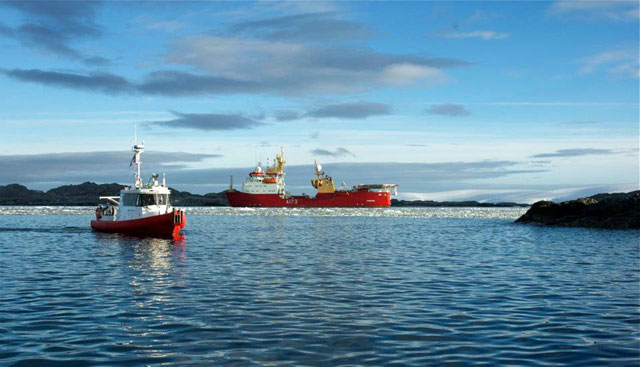
Photo Credit: Ryan Wallace
The British Royal Navy HMS PROTECTOR, in the distance, and its survey boat the JAMES CAIRD, conduct a survey of the seafloor around Palmer Station.
The research groups of the Palmer Long Term Ecological Research (LTER) Dive researchers led by Jim McClintock and Chuck Amsler 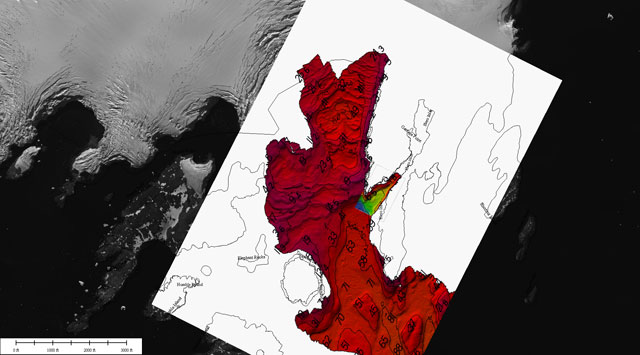
Photo Credit: ©DigitalGlobe background imagery; HMS PROTECTOR bathymetry; image courtesy of Paul Queior
Bathymetry from the Royal Navy scan of the seafloor around Palmer Station.
Last, but not least, scientist Yuta Kawarasaki, a graduate student at Miami University The research vessel Laurence M. Gould March saw the last official visits by guests of the tour ships Ushuaia and the Corinthian II, and we also had a visit by the newly acquired ship of the British Royal Navy On the social side of things, the director of our construction and maintenance department, Zee Evans, hosted an amazing art show in the bar and lounge, featuring outstanding paintings, photos, handcrafts, and live performances of poetry and songs. There was also a wine tasting, with wines brought from all parts of the world. High-profile visitors make an appearance at Palmer StationPosted March 9, 2012
February began and ended with visits from distinguished guests. Lindblad Expedition’s National Geographic Explorer came to Palmer Station Climate Reality cruise notables
Ragnar Grímsson, president of Iceland Hasan Mahmud, Bangladesh's minister of Environment and Forests Tokyo Sexwale, South Africa’s Human Settlements minister Christiana Figueres, executive secretary of the UN Framework Convention on Climate Change Kevin Trenberth of the National Center for Atmospheric Research James Hansen, head of the NASA Goddard Institute for Space Studies Richard Branson, founder of the Virgin Empire Ted Turner, founder of TBS and CNN television networks Tom Brokaw, veteran American television journalist Tommy Lee Jones, Academy Award-winning actor Jason Mraz, Grammy Award-winning musician Needless to say, it was an exciting day. The guests were given a slightly expanded tour of the station, while many of our local scientists answered questions aboard the Explorer. Through the middle of February, Palmer Station was the welcoming recipient of many days of sunshine and calm weather. We worked hard to convince short-duration residents that this is not the norm. Scientists Chuck Amsler and Jim McClintock James Bockheim His group returned to collect data from soil stations that were left over the winter. They have also been drilling on Amsler Island in order to place instrumentation that will allow them to study permafrost. Fuelies from McMurdo Station arrived to continue working on the wax buildup in one of Palmer’s bulk storage tanks. They have successfully removed all the remaining liquid fuel and shoveled out the wax. Now they are working on removing the lining in the tank. To close out the month, another group of distinguished guests, the Blue Ribbon Panel The panel has been tasked with reviewing the current operational status and facilities of the U.S. Antarctic Program The panel visited McMurdo and South Pole Science continues amid season of odd weather eventsPosted February 17, 2012
This season’s odd weather continued in January. The sea ice finally receded south, but repeated snowfalls plagued the month, occasionally accumulating overnight. Though snow should seem normal for Antarctica, in our neck of the woods, the heart of summer is generally just a bit too warm for it. Perhaps the snow was aided by the distinct lack of sun and ambient light compared to previous years, which was actually quantifiable in the weather station data. In short, it’s been gloomy. Still, science must go on at Palmer Station 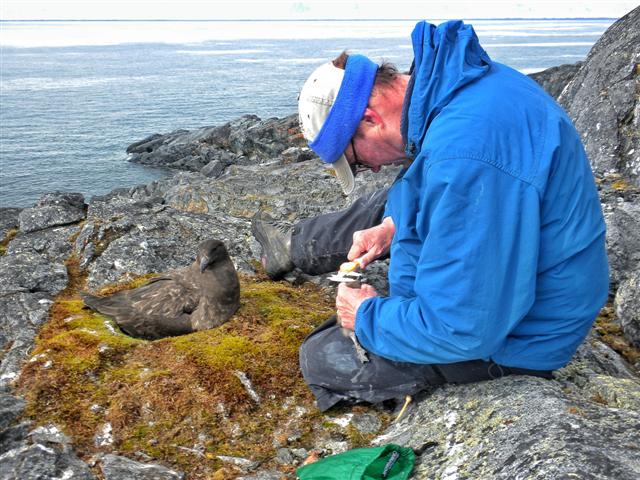
Photo Credit: Kerry Kells/Antarctic Photo Library
Scientist Bill Fraser, head of the Palmer LTER seabird component, measures the length of a brown skua chick's beak near Palmer Station.
The “buggers,” led by Rick Lee of Miami University The zooplankton arm of thePalmer Long Term Ecological Research (LTER) The LTER birders found that all the mating pairs of south polar skua in the local vicinity have failed to raise offspring this season. In recent years, the skuas have been in decline, just like Adélie penguins, but their complete failure to reproduce in the local area is unprecedented. 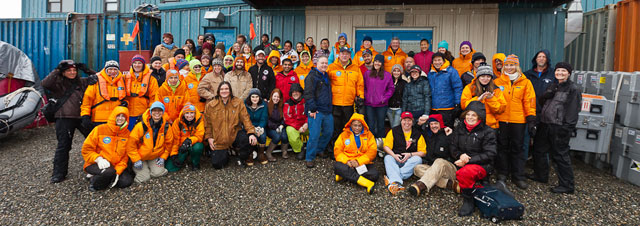
Photo Courtesy: Brian Nelson
Former Vice President Al Gore, center, poses with residents of Palmer Station and members of the Climate Reality Project.
The research vessel Laurence M. Gould The LTER scientists also made their annual visit to the British Antarctic Survey’s Rothera Station The final week of January and the first week of February was a mass hysteria of overloaded schedule: another port call from the Gould, visits from two cruise ships, one yacht visit, and two off-shore lectures. We were also graced with a special appearance by former Vice President Al Gore Palmer hosts LTER site review and related science in DecemberPosted January 13, 2012
This year’s persistent sea ice finally shoved off in early December, leaving an open boating area around Palmer Station Early in the month, the research vessel Laurence M. Gould The station was abuzz with scientists for several days — some longstanding members of the Palmer community, and some completely new to Antarctica. The assessment team tagged along with all subsets of the Palmer LTER: taking water column samples, counting birds, and echo sounding for krill, as well as going for a short mock-cruise on the Gould. Our visitors also showed great interest in station life, non-LTER science, and support logistics, so everyone was kept very busy. Paul Morin The Oceanites group is interested in using high-resolution satellite imagery to track, count, and even differentiate species of penguins in a colony. They have already found many previously unknown penguin colonies using this technology. After the site review, we experienced a couple weeks of normalcy. The phytoplankton arm of the Palmer LTER launched another autonomous underwater vehicle (AUV), which is now sampling an area known as the Palmer Deep, just south of Anvers Island. A glider launched in early November is continuing its journey to the British Antarctic Survey’s Rothera Station The rest of the LTER is seeing increases in oceanic biological activity, normal for this time of year. The zooplankton arm measured massive aggregations of krill in the area, which are always welcome because they attract more megafauna, or large critters like humpback whales. In fact, in the days leading up to Christmas, the boating area was teeming with humpback whales. Lots of folks made it out in Zodiacs, and some were lucky enough to get very close encounters by these curious whales. Amazing holiday tidings indeed. Sea ice continues to stymie researchers at Palmer StationPosted December 9, 2011
Sea ice along the southern Antarctic Peninsula continues to be problematic to science efforts at Palmer Station A wide band of ice beginning at the southern end of Anvers Island extends all the way down to the Bellingshausen Sea. Because Palmer Station is on the northern tip of the band, wind and current conditions have strongly governed the state of sea ice around station. Pack ice has varied in density throughout the month of November, often too thick for boating operations. Northeasterly winds seem to offer the only reprieve. 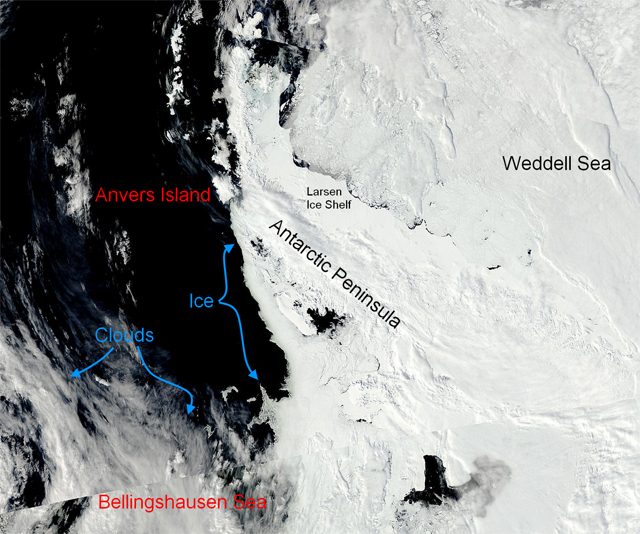
Photo Credit: NASA, with annotations by Brian Nelson
NASA MODIS satellite image of Palmer Station region on Nov. 14 shows ice-choked areas.
The Palmer Long Term Ecological Research (LTER) The Palmer Station research associate began collecting GPS ground control points for the Polar Geospatial Center (PGC) Temperatures are rising along the peninsula as we enter the austral summer, and much of the winter snow accumulation is now gone. The penguins have laid eggs, and other local birds are nesting. A week-long break in the wind in mid-November provided excellent conditions to get out and see the wildlife, as well as collect scientific data, before the relentless sea ice crept back into the area, seemingly of its own accord. 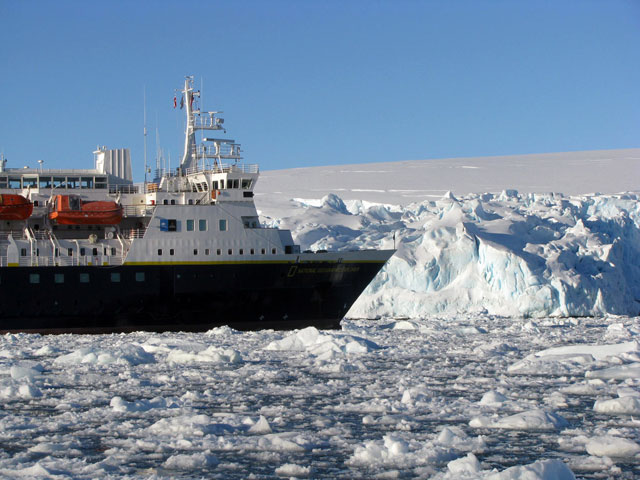
Photo Credit: Marci Levine
The National Geographic Explorer pushes through ice in Arthur Harbor near Palmer Station.
The ice didn’t stop the National Geographic Explorer from being the first tourist cruise ship to visit station this season. On Thanksgiving Day, more than 100 passengers were given a tour of station while Explorer Zodiac drivers steered ever-widening circles in Arthur Harbor to maintain a broken but reasonable path of open water back to the ship. The yacht Spirit of Sydney visited shortly after, carrying Jørgen Amundsen, a descendant of Roald Amundsen. As part of the centennial celebration of Roald Amundsen’s arrival at the South Pole on Dec. 14, 1911, Jørgen Amundsen will make an attempt to summit an unclimbed and unnamed peak along the Antarctic Peninsula on the same day. Jørgen Amundsen said he considered visiting the South Pole on this historic date, but felt that the spirit of adventure, discovery and accomplishment would be better memorialized by breaking new ground, rather than revisiting a location that is now well-established and much more easily attainable. Summer ice packs in Palmer Station to extent not seen in a decadePosted November 11, 2011
Palmer Station For the first time in 10 years, summer residents witnessed fast ice — sea ice fixed to the shore — with enough stability for foot travel. In fact, it’s been more than a few years since winter personnel have seen this occur. During September and the first half of October, scientists walked out to one of their sampling sites and dropped nets through a hole in the ice cut by chainsaw to collect phytoplankton for a project studying how the single-celled plants evolve through the seasons. [See related article — Turned on and off: Scientists study seasonal gene expression in phytoplankton.] In mid-October, the ice finally destabilized and blew out with a storm. Since then, Palmer has alternated between periods of strong northerly winds, precluding boating, and thick pack ice from horizon to horizon, also precluding boating. So, in lieu of field-station sampling, Palmer scientists have had to find creative ways to fill their sample bottles. The microbial arm of LTER has been using seawater that pumps through the aquarium. The zoological team has dropped nets over the side of the pier. The phytoplankton component of LTER brought four autonomous underwater vehicles with them this year, and they have one more on the way. One of these gliders is scheduled to “fly” all the way from Palmer to the British Antarctic Survey’s Rothera Station Last year, a glider made part of this trip and was retrieved by the research vessel Laurence M. Gould The LMG pushed her way through the pack ice this month for a multi-tasked cruise. Before reaching Palmer Station, she stopped at King George Island to open a field camp and at Duthiers Point, the entrance to Andvord Bay, to perform repairs to a GPS station. Once at Palmer Station, the LMG began loading tanks of waxy fuel to be transported to Punta Arenas for storage. First researchers of 2011-12 season arrive at Palmer StationPosted September 9, 2011
Winter was cut short early at Palmer Station The arrival of the ship brought the station’s population up to 25 from 15. A science group led by Deneb Karentz 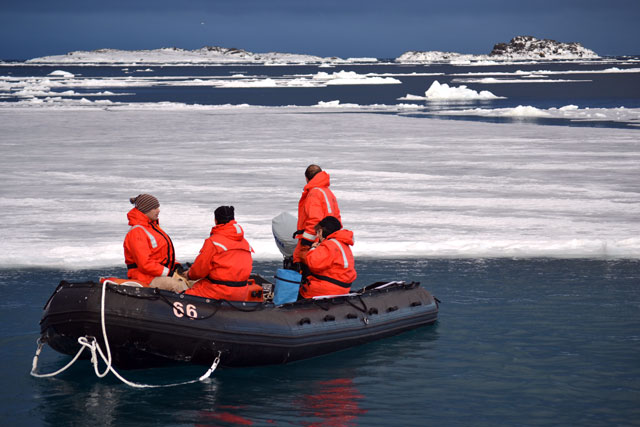
Photo Credit: Bethany Goodrich
Sea ice around Palmer Station throughout August made it difficult to leave the vicinity in a rubber Zodiac.
While the team has faced some challenges and limitations due to the presence of sea ice, the researchers have developed interesting and unique solutions to the problems. Palmer has been locked in sea ice almost the entire month, except for one very windy day that briefly pushed the ice out. A single Zodiac was able to get in the water for a few hours before being forced back to station, as the ice solidified once again. While the ice appears thick, littered with bergy bits, or chunks of glacier ice, it is not stable enough to be traveled over by foot. The ice may be a hindrance to both science and recreation, but it has provided some fantastic photographic opportunities. Recreation has been limited to land-based activities throughout the month, but that has not slowed most people down. Several storms deposited enough snow on the glacier to allow skiing and snowboarding, and some station residents took advantage of the rare opportunity for fresh powder in Antarctica. Most activities last month were based indoors, with movie nights, card games and hobby projects galore. 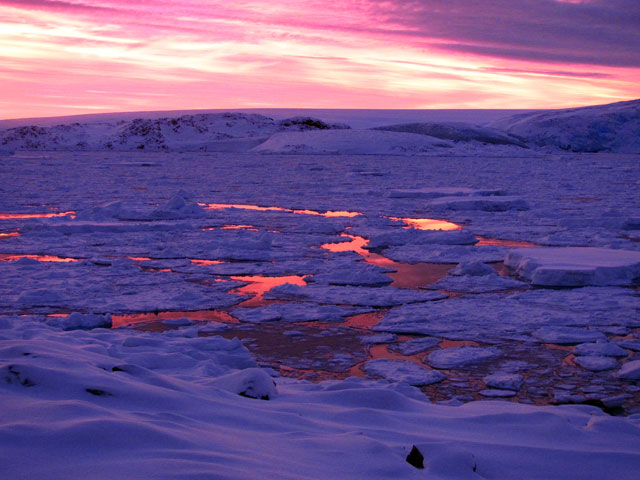
Photo Credit: Perri Barbour
The pink colors of twilight reflect on the snow and water near Palmer Station.
With the return of the Gould with part of the summer crew, winter at Palmer is coming to an end. Guidebooks are appearing on tables around station, and personnel surf the Internet during off-hours to search for exotic locales for upcoming vacations. Most residents are ready to undertake a new adventure, but there is still a feeling of fondness for this small, comfortable community. Many residents will return again next year, while for others it may be their last season on the Ice. Many friendships will be long distance for years to come, and some will begin to fade. Winter at Palmer is a unique experience, and the memories will last forever. As new community members come in, and others begin to leave, many activities on station will remain the same. Research will continue, as will normal station operations. Names and faces may rotate, but station requirements and challenges will never falter. As the weather begins to warm, new challenges and adventures await. Brief winter isolation at Palmer ends with arrival of new science teamsPosted August 12, 2011
There’s something about the darkness of mid-winter that inspires a celebration. Millennia ago, in Europe, the ancients celebrated the winter solstice by bringing evergreen branches into their homes as reminders of the lively verdancy of summer, and they feasted. By the latter days of the Roman Empire, this annual festivity evolved into Christmas. When Capt. Roald Amundsen and Capt. Robert Scott wintered at the edge of the Ross Ice Shelf On June 21, 2011, the sun did not appear over most of Antarctica. But it did shine over Anvers Island for less than four hours, the shortest day of the year. The temperature at Palmer Station That evening we sat down to a splendid dinner reminiscent of the first mid-winter celebrations 100 years earlier, as described in the memoirs of the Scott and Amundsen expeditions. This connection with the great explorers — and the upcoming centennial of their attainment of the South Pole — infused the event with the aura of a solemn occasion. And like Antarctica’s first inhabitants, we are spending these dark but cheerful days preparing for activities to come when winter departs. Various systems in the station’s infrastructure are undergoing repair or improvement, including the generator exhaust stacks, some of the electrical wiring, the galley ceiling and the Zodiac pontoons and their instrument and equipment boxes. The laboratories and aquarium are being prepared for the return of the scientists, the first of whom arrive with the research vessel Laurence M. Gould Palmer Station settles into winter multitaskingPosted July 15, 2011
June started with a flurry of activity, as the science groups packed up to leave, beginning with several entertaining events for the crews of Palmer Station A fun and oddly educational fish print party was held for cataloging icefish caught by one of our science parties for research, with homemade ice cream served as well. The farewell festivities concluded with an open mic night in the station lounge, and the audience was treated to musical performances by scientists, station personnel and Gould crewmembers. The last few remaining summer personnel were coaxed onto the Gould, leaving behind 15 of us to keep the station operating over the winter. This is the first time since September 2009 that Palmer Station has been without an active science group on station; however, data collection continues year-round for other projects. The winter staff celebrated the first day of isolation with a sushi dinner. Two weeks later, we were treated to an elegant Midwinter celebration dinner. Our chef prepared an exceptional meal including dishes such as bacon-wrapped scallops, roast pumpkin soup, Beef Wellington, crab legs, pumpkin ravioli and Baked Alaska for dessert. Notable differences started to occur for the winter personnel in June. Sea ice moved into the harbor, and wildlife sightings were rare. The weather became more overcast, making our short days seem even briefer. The overcast weather has made us appreciate the rare clear conditions even more, with cameras ready for any spectacular dawns, dusks or stars. Another significant difference is the level of multitasking taking place on a daily basis. The station upkeep of cleaning and shoveling is more frequent for each station member, now that we are down to 15 people. All of us are involved with one or more safety teams. Folks are enthusiastically taking on new duties and helping out in unanticipated ways, such as performing station rounds and learning how to patch a Zodiac. June started with a flurry of activity and continued with flurries of snow. Now the team at Palmer will continue forward with our winter projects in our ever-brightening environment. Palmer Station scientists head home for the winterPosted June 24, 2011
As the month of May winds down at Palmer Station The research vessel Laurence M. Gould Scientists at station have also been busy, with four separate groups conducting research into the late part of the season. A team led by Kristin O’Brien While the fishing process, and transporting of live fish has posed unique challenges, it has also provided the opportunity to see these rare and unique creatures up close. The chemical ecology group — led by Chuck Amsler, Bill Baker and James McClintock But the end of May meant the close of much of the research. The Gould departed station in the first week of June with the science grantees and will not return again until August, leaving Palmer with only 16 winter-overs. Rescue teams have been very busy practicing. With such a small winter population, residents must be prepared for anything that may happen. 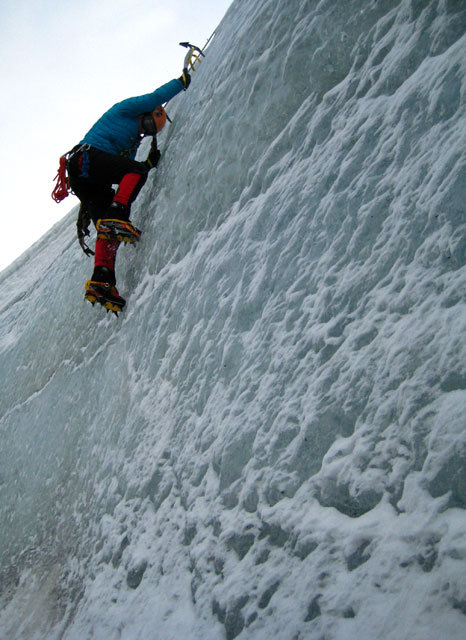
Photo Credit: Christina Hammock
A member of the Palmer Station glacier search and rescue team trains on ice face.
Recreation opportunities have been limited this month, due to very short days and unpredictable weather, with 70-knot winds on a recent Sunday. But every opportunity available has been taken, with trips to nearby islands when wind speeds are below 25 knots, and trips up the glacier when they are not. Several people on station participated in The Ride of Silence As the winter weather sets in and temperatures continue to drop, creaks and groans become less common from the glacier behind the station. The thunderous calving events are even rarer. Cloud cover has created some spectacular sunrises and sunsets, providing amazing shades of pinks and oranges that can never be properly captured by a photograph. Rare breaks in the cloud cover have also provided some great stargazing. Palmer Station plunges into winter seasonPosted May 6, 2011
April at Palmer Station The first half of April barely slackened from the pace set in the first week. While the ship took away most of the Palmer Long Term Ecological Research There was also a new science team in town — a group that became affectionately known as “the badgers.” 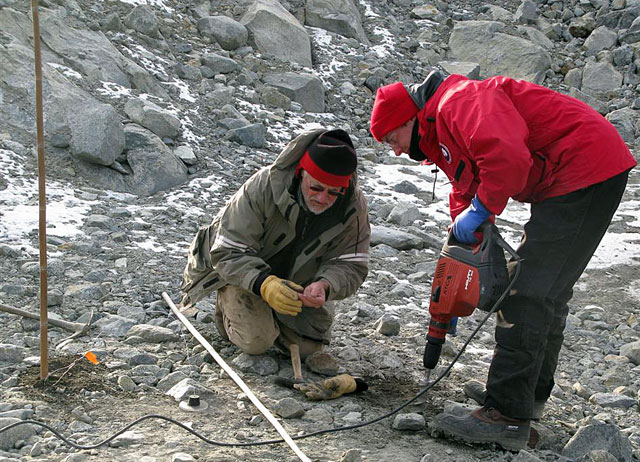
Photo Credit: Kelly Wilhelm
Scientists Adam Beilke, left, and James Bockheim collect soil samples for a study on permafrost and climate change.
Named partly after the mascot of their home institution, the University of Wisconsin-Madison Armed with drills, picks, and rucksacks, the group looked much like an Indiana Jones expedition as they set out from station to collect soil samples and set up remote instrumentation on many of the local islands. One of the many interesting aspects of their research is how the ripple effects of climate change play out in the Antarctic, as the glacier melt exposes land rather than sea, as it does in the Arctic. Landscape changes of a much more rapid kind were also taking place in early April, as the antenna riggers once again altered the Palmer skyline. After days of up-and-down climbing, a 100-foot-tall relic of communication days gone by was dismantled and transported to station piece by piece in a Zodiac. The tower formerly held an HF antenna that was installed in 1972 for direct communication with other U.S. Antarctic Program (USAP) Meanwhile, the station hosted a few special visitors. The first was a representative from the Point Sur, a 135-foot-long research vessel based in California, who was on station to learn and plan for possible USAP summer science cruises based from Palmer. The scientific community welcomed the opportunities that a smaller vessel could provide, and station staff took a keen interest in the novel possibility. In addition, a couple of representatives from the National Science Foundation On April 21, the Gould arrived at station carrying a research team led by Kristin O’Brien But before the ship can dock after these fishing cruises, the water flow to the Gould’s on-board fish tanks must be shut down, making the task of transporting the icefish to the Palmer aquarium a race against time to keep the fish alive. Palmer’s logistics team proved up to the task by coordinating what O’Brien said was the smoothest offload she had ever seen. Recreation was in full stride for the new season. The first weekend of winter offered the perfect chance for new Palmer crewmembers to get to know each other with an a night of karaoke. Not only did folks let loose their voices, but also several surprise guests appeared in costumes that only a rummage through the skua bin could supply. One weekend, the badgers led a geology walk for station members that highlighted the various land formations on the local islands. A rare afternoon of blue skies and calm winds was occasion for a full round of disc golf on the course in Palmer’s “backyard.” Earth Day was commemorated at Palmer with two special events. The first was participation in the Nature Conservancy’s Picnic for the Planet, with a picnic on the water in a Zodiac, complete with red-checkered tablecloth and accordion accompaniment. The other was the traditional underwater daisy picking, where the science divers remove litter from the waters around the pier and volunteers help to haul up relics, ranging from old soda bottles to long-missing tools. April started with a splash, and we expect the winter season will go along swimmingly. Emperor penguin makes rare appearance at Palmer StationPosted April 22, 2011
Standing tall and surveying the landscape, he almost seemed to know how rare he was. Or, maybe, how lost. An emperor penguin took up residence at Palmer Station A steady stream of onlookers walked out to the station’s “backyard” for a close peek at the emperor, which stood out so distinctly from the smaller penguins regularly seen at Palmer. Some long-timers could scarcely recall if one had ever been spotted here before. The beginning of March also brought rarities of a different kind of wildlife — one that lived about 70 million years ago. A paleontology team, led by Peter Ward and Joseph Kirschvink Back near the Palmer Station waters, records were also being broken. A science dive team, led by Chuck Amsler, Bill Baker and Jim McClintock The Palmer Long Term Ecological Research But March at Palmer wasn’t all left-brain. Two impressive artistic events brought a note of aesthetics and entertainment to station. The first was a visual art show with entries ranging from ice carvings and hand-made instruments to paintings, sculptures, and weavings. The following weekend brought an intimate Open Mic night, complete with acoustic guitar solos, accordion duos, storytelling, rapping, and a full-band set. Costumes, inside jokes, and re-written lyrics with a Palmer twist highlighted just how familial a community can be by the end of a great season. Inevitably, outdoor recreation inspired by great weather and end-of-season excitement partially gave way to the drum of station turnover preparation. Boxes and luggage were filled meticulously with samples and chemicals, travel gear and guidebooks. The collective keyboard strokes of “End of Season Reports” being typed could be heard around station. Meanwhile, a legacy was being fabricated behind closed doors. After weeks of work, investing many hours of free time, a team of station craftsmen unveiled a new and exquisite back bar, installed just in time for the arrival of the Gould and the winter crew. When station personnel turnover hit, not a minute was wasted, as Palmer seemed to hum like a well-oiled machine. Even a partial list of the week’s schedule would have been a feat to accomplish in seven days: station fuel transfer; turnover of Fire, Glacier Search and Rescue, Ocean Search and Rescue, and Trauma teams; a fire drill walk-through; moving several milvans of cargo; food offload; boating courses; orientations; cross-town dinners; ship line handler training; and spill response exercises. In addition, a team of 15 volunteers joined antenna riggers at the top of the glacier behind the station to hoist a new kind of tower for the very low frequency (VLF) project antenna. When it was all over, there was an unmistakable mixture of exhaustion and excitement on both the Gould and at the pier, as the ship pulled away and the first day of winter began. Ushering in a March for the record books, the emperor penguin turned out to be only one of many firsts to be marked at Palmer in the finale of summer. Palmer Station personnel construct new boat rampPosted March 11, 2011
The beginning of February at Palmer Station The LTER cruise proved successful, with good weather for water sampling and installing temporary field camps for seabird census work on islands to the south. The LTER project, nearly 20 years old, studies the effects of climate change on the marine ecosystem along the northwestern region of the Antarctic Peninsula. The Gould visited Palmer Station again briefly on its way back north to take with it members of several science teams that had been working around the nearby islands on projects ranging from bugs to microbes to underwater gliders. During the lull in science support activity, the station crew completed a long-awaited project: The boathouse now has a large deck platform with room for several boats, replacing the small ramp that formerly fit only one. This will prevent the need to pile boats all over the pier and the road when inclement weather requires them to be out of the water. Late in February, the Gould returned, bringing a science dive team from the University of Alabama at Birmingham and University of South Florida Three science groups remained on board the Gould to do geological work in the James Ross Island vicinity, the northernmost reaches of the Antarctic Peninsula. David Barbeau Before South America and Antarctica pulled apart, a land bridge existed between the continents. Ross MacPhee 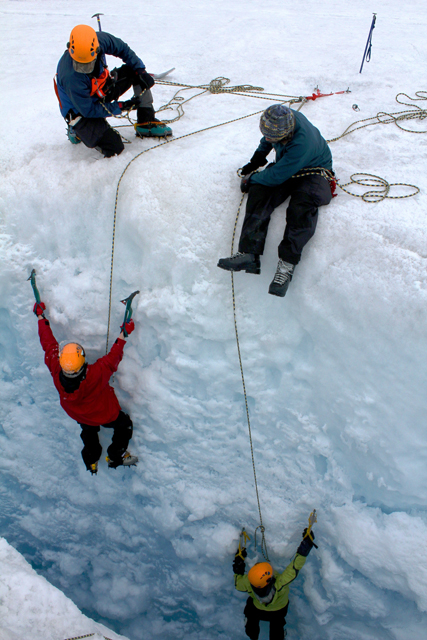
Photo Credit: Tim Nicoll
Palmer Station Glacier Search and Rescue team members belay scientists Kim Bernard and Kate Ruck into a crevasse during a recreation day.
Joseph Kirschvink So far, the teams have reported some interesting findings. In a recent report, Peter Ward Back at Palmer Station, a rare calm Sunday provided a chance for the Glacier Search and Rescue team to host a recreation day. Interested parties were taken to a section of glacier overhanging Arthur Harbor and lowered into a crevasse. They then had the opportunity to climb back out on the ice face. Nearly half the station participated, both scientists and station support staff alike. In contrast to January’s beautiful sunny calm, February was a month of dreary drizzle. The final week brought in a barrage of significant low-pressure systems, pummeling the station with wind and ocean swells for days on end. Autumn seems to be upon us. Summer science hits high mark at Palmer StationPosted February 4, 2011
The weather at Palmer Station The weather arrived serendipitously, as the station simultaneously reached its maximum number of science groups for the season, and nearly its personnel capacity. Of the new arrivals this month, Richard Lee and David Denlinger’s 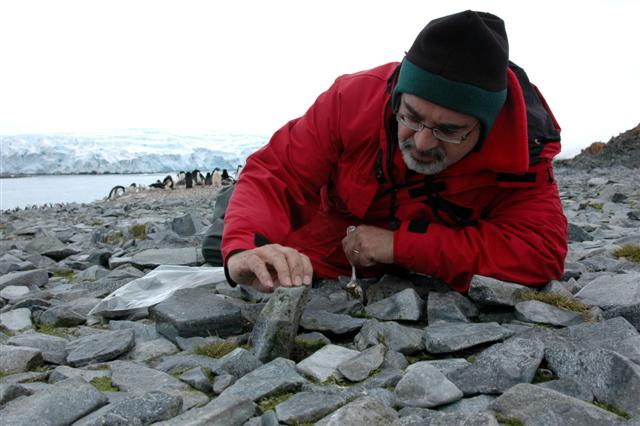
Photo Credit: Peter Rejcek/Antarctic Photo Library
David Denlinger searches for Belgica antarctica on Torgerson Island off the Antarctic Peninsula during the 2009-10 field season.
Differing from last season, two members of the group will stay through the end of April to collect the tiny insects as they slowly freeze in preparation for the winter season. This extra time will provide information concerning the coping mechanisms these flightless flies use to survive the Antarctic winter. A new research group, led by Matthew Cottrell from the University of Delaware These microbes, called photoheterotrophs, are able to grow both by absorbing light energy and by consuming other organic materials. Because light levels differ so drastically here from summer to winter, Cottrell is interested in the seasonal habits of these microbes. One of the busier research cruises of the season aboard the Laurence M. Gould The scientific aspect of the trip was successful. And so was the recreational aspect. Traditionally, during the PAL LTER cruise, the Gould visits Rothera, the British Antarctic Survey’s But this year the scientists and crew of the Gould defeated the British, 1-0. Some attribute their good luck to the braying of a vuvuzela on the American side, brought directly from the 2010 World Cup by South African Kim Bernard, a krill researcher on the PAL LTER. Back on station, recreational activity has been pervasive in the off-hours. The long spell of miserable weather in October and November definitely set a tone for the season that has everyone taking full advantage of any nice day. Scheduled evening events occurring indoors, like science lectures, have had a tendency to go on hold this month, as people rush out to pursue outdoor activities. Even the wildlife seems to be more abundant, as crabeater seals laze on ice floes by the dozen and humpback whales make appearances within the boating limits. The warm sun has also increased calving activity on the local glacier above Arthur Harbor. But those wishing to go hiking on the glacier this month have had to employ increased awareness, as snowmelt reveals new cracks and crevasses. The station’s Glacier Search and Rescue team (GSAR) had to decrease the safe recreational area, as several encroaching crevasses have widened enough to gulp up a person, and new cracks within the flagged area are enough to grab an ankle, or a knee and thigh in some spots. Fortunately, GSAR’s proactive work has prevented any injuries. And, on the plus side, a new tongue of recreation area was opened on the back side of the glacier, allowing Palmer residents to travel by foot to the near edge of a point overlooking Biscoe Bay. Small community at Palmer shifts with the arrival of shipsPosted January 7, 2011
The nuances of station life change subtly with every shift in personnel. The feel of December was heavily influenced by the distinct influx of voice recorders and scribbling notebooks held by science-journalism fellows from the Marine Biological Laboratory Led by Chris Neill, a journalism group visits Palmer Station In addition to these wielders of the mighty pen, our very own poet (they do exist), Katharine Coles joined us on an Antarctic Artists and Writers Program She said, “This has been, for me, an absolutely magical and life-changing experience. And for me it’s not just because of the icebergs and the penguins, although the icebergs and the penguins are quite wonderful. The thing that has been most surprising to me, and that has given me the most food for thought … has been the community and the people here. … The way that you use language and play with language at this station is something that is a delight to a poet and is something that I absolutely would be unable to ignore.” The science community at Palmer Station has banded together on a joint project this month. The Palmer Long Term Ecological Research (PAL LTER) The scientists collected a large amount of seawater and separated it into three groups that simulate different concentrations of CO2: pre-Industrial Revolution CO2 levels (180 parts per million), current CO2 levels (390 ppm), and future peak CO2 levels projected by the United Nations Intergovernmental Panel on Climate Change The scientists hope to observe any changes occurring to the marine ecosystem based on these CO2 levels. They plan to perform this experiment again later in the season, and on the research vessel Laurence M. Gould The phytoplankton arm of the PAL LTER program launched an autonomous underwater vehicle this month. The AUV, or glider, “flew” to the Gerlache Strait and back, collecting water column information. Simultaneously, two other gliders were soaring through Antarctic waters; one in the Ross Sea north of McMurdo Station Our holiday season was kicked off with a philanthropic visit from the Abercrombie & Kent cruise liner Le Boreal. The guests on this cruise choose to pay a little extra in order to bolster the scientific community here. This year they donated a digital microscope camera to the LTER group. 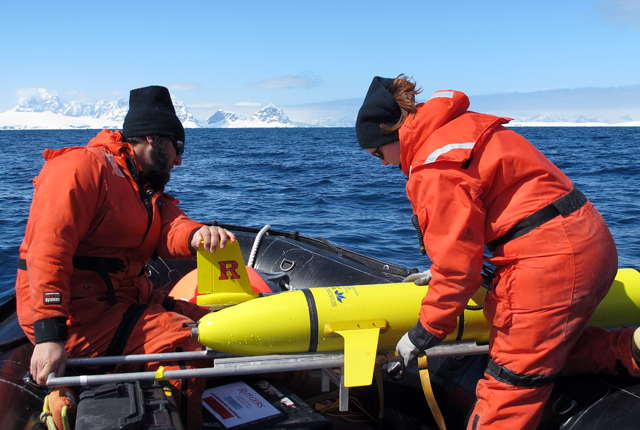
Photo Credit: Jennifer Bogo
Michael Garzio and Kaycee Coleman launch a glider near Palmer Station. The autonomous underwater vehicle takes physical ocean measurements.
This program is supported and encouraged by Jim McClintock We were also visited this month by the Russian icebreaker Kapitan Khlebnikov, and with it, Dr. Joanne Feldman, who served as the Palmer Station doctor last summer season. The Kapitan Khlebnikov sailed a semi-circumnavigation of the Antarctic continent after leaving Palmer Station, and Dr. Jo was able to hand carry several postcards from Palmer to McMurdo, just in time for the holiday. [See previous article: Diving into medicine.] Our holiday season has been festive and busy. We sat down to a wonderful Christmas dinner with a table set for 33, our current population. The following day held Palmer’s traditional “Yankee swap” gift exchange, where rules were argued lovingly and gifts were stolen respectfully. Our holiday din: Adélie chicks peeping, gentoos porpoising, humpbacks exhaling, and elephant seals making that awful sound that elephant seals make. First visitors of summer season make port call at Palmer StationPosted December 10, 2010
In describing Palmer Station October’s mad weather continued into November, barely losing steam through a busy port call that doubled the local population and had us all running. Since the hasty northbound departure of the research vessel Laurence M. Gould Prior to the port call, preparations were being made on station by an expanded waste team for the biannual hazardous waste run. Led by Raytheon Polar Services’ 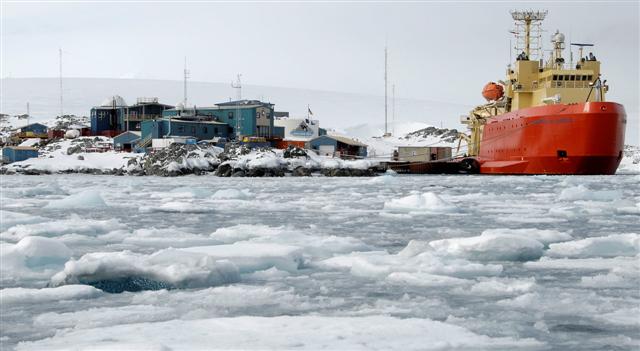
Photo Credit: Andrew V. Williams/Antarctic Photo Library
The research vessel Laurence M. Gould docks at Palmer Station.
Normally, the Gould would take the hazardous waste directly back to the United States, but this year it will be loaded onto the research vessel Nathaniel B. Palmer Before reaching Palmer Station on its most recent transit, the Gould stopped to quickly and successfully open Cape Shirreff field camp in the northern reaches of the Antarctic Peninsula on Livingston Island. Five scientists will spend the austral summer there studying Antarctic fur seals. [See previous article: Keeping track.] The port call itself, in addition to the hazardous waste management, included several other temporary visitors. The National Science Foundation A new science group had two members here to install new equipment in Terra Lab. The principal investigator, Qian Wu, with the help of Andrew Watt, installed a Fabry-Perot Interferometer that will provide wind and temperature information from the mesospheric and thermospheric layers of Earth’s atmosphere. In collaboration with scientists and similar instrumentation at Australia’s Davis and Mawson Two other new science events arrived on station this month, both investigating viruses. Under Grieg Steward, a team is here to study the effects of viruses on the local phytoplankton population. Data collected by the Palmer Long Term Ecological Research A second project is the post-doctorate work for Jennifer Brum. Brum will be studying different styles of virus reproduction and how they relate to various annual cycles of the Palmer area ecosystem. The final weeks of November brought two visiting ships to station. The Chilean Navy vessel Lautaro had the honor of being our first visitors of the summer season. The Lautaro supplies the Chilean Antarctic research stations and collects bathymetric data around the Antarctic Peninsula. They brought beautiful weather with them, and after touring Palmer Station, they invited us to a barbeque on the deck of the Lautaro. The first commercial cruise visit, on Thanksgiving Day, was the National Geographic Explorer, bringing more than 100 guests to tour the station. One of the Explorer’s divers, Lisa Trotter, also served as Palmer Station’s winter site manager from April through September of this year, so it was great to welcome her back, if only briefly. [See previous article: Diving in.] First summer science teams arrive at Palmer StationPosted November 5, 2010
The summer science season is slowly ramping up at Palmer Station In this first month of summer, Palmer has been pummeled by wind, snow, sleet and rain. We’ve seen hours-on-end of sustained 50-knot winds, gusting into the 80s, approaching the maximum recorded wind speed of 93 knots. The wind and rain have stripped the area of nearly all its snow and turned the short road through town into an icy, slushy mess. But it was better to be at Palmer than on the research vessel for the northbound leg of its recent transit. The high wind and waves in the Drake Passage provided a miserable crossing for much of the outgoing winter crew on the Laurence M. Gould The Palmer Long Term Ecological Research (PAL LTER) In the few days that were calm enough for boating, the scientists made their first krill catch: a meager 20-or-so juveniles of the shrimplike animal. They also made their first water column sample collections at Station E, a location of long-standing record nearly two miles away from Palmer. Station E is known for beautiful views back toward Anvers Island on nice days, and notorious for foul swell, chop and seasickness on anything less than a nice day. A new research group is on station for a month to study the long-range atmospheric transport of chlorinated organics such as DDT. This work follows the discovery of trace amounts of these compounds in Adélie penguin tissues. A paper on the finding was published online in 2008 in the journal Environmental Science & Technology. [See previous article Persistent chemical.] Scientist Jenna Luek has been collecting samples of air and snow, and hopes to snag some glacial meltwater, now that the base of the nearby glacier has been exposed. The samples will be used to determine sources and sinks for chlorinated organics. Rebecca Dickhut Palmer Station’s generators received some much-needed attention this month. Generator #1 had been unable to take a full load all winter due to a new, but faulty, injector pump. With that repaired, power plant mechanic Dennis Calhoun was able to completely rebuild generator #2. The normally soothing hum of instrumentation at Terra Lab has been accented this month with the harsh but satisfying sounds of construction. On the inside of the earth sciences laboratory, a darkroom has been built to house a new instrument. On the outside, a new enclosure will provide a view of the sky to the darkroom. A timely break in the weather provided the perfect opportunity to slice through the metal skin of Terra Lab’s roof and seal the enclosure in place. The weather window for this construction project came just in time, as a science group led by Qian Wu from the National Center for Atmospheric Research We are looking forward to a busy port call of the Gould in early November that will serve as our hazardous material run for waste that requires special handling and disposition. The visit will also include a few brief science events and some station personnel turnover. We are also crossing our fingers and looking forward to better weather. Summer crew arrives at Palmer StationPosted October 15, 2010
Summer is now in full swing at Palmer Station The LMG also brought fresh food, supplies, and the station’s generator fuel for the upcoming summer season of science. 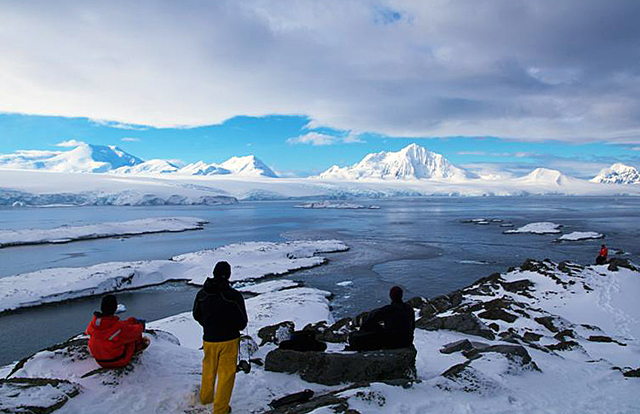
Photo Credit: Sean Bonnette
Palmer Station personnel view Anvers Island from another island. Mount William is in the background to the right.
Most of the incoming crew worked the previous summer season, so turnover of duties went off without a hitch. Everyone came together to offload all the cargo from the ship, adapting to their jobs like they had never left station. Transferring fuel to Palmer from the LMG involves just about everyone working together to set up, monitor, and take down all the equipment needed. It’s mostly an all-day affair. Before fueling can begin, steps must be taken to ensure the containment of any potential spills, either from the LMG or at Palmer. A containment boom is put into place around the ship, along with absorbent rolls placed on deck to stop the spread of any spills. On the station side of the operation, all snow is removed from around the fuel line, which is monitored during fueling. On the fuel line from the LMG there are several clamps in place ready to seal off the line in the event of a puncture. Thanks to all the hard work and preparation put into station fueling, there were no spills and the transfer was very successful. Before the LMG could depart, the station emergency teams needed to turn over duties from the winter to the summer crew. The various emergency teams on station include Glacier Search and Rescue, Ocean Search and Rescue, and Trauma and Fire. Of all these groups, the fire team had the most intensive turnover during the port call, including a fire drill after the winter crew handed over their gear. After a short trip to make conductivity, temperature and depth (CTD) measurements of the water column, the ship made its way north back to Punta Arenas, Chile. Just after untying the LMG, station personal jumped off of the Palmer pier into the frigid water in the polar tradition of farewell, wishing their co-workers and friends a safe trip north. Wildlife returns to Palmer station as summer thaw beginsPosted September 17, 2010
The winter at Palmer Station Over the past month the sea ice has come and gone a few times. Most of what continues to accumulate in the waters around Palmer doesn’t add up to more then rounded pancake ice. Some icebergs have been observed off to the west, but they mostly continue to stay clear of the immediate area. The coming and going of the sea ice has made for increased boating opportunities around the station for search and rescue training, as well as recreation. Soon most of the nearby islands around the station will be off-limits due to the return of the wildlife and seabird breeding. The critter count around station continues to increase each day, with more seal sightings, along with the return of some penguins and other birds. Several small groups of 20 or so gentoo and Adélie penguins have been spotted on local islands. Several groups of gentoo penguins have also been encountered while out boating. This gives those lucky enough to be there a good view of how quickly the penguins move as they porpoise through the water. The number of leopard seal sightings is also on the rise, some as close as the station’s seawater intake pump house. Most are seen in the water fishing or catching some sleep on an ice floe. Social activities on station continue with concerts, art shows, and themed nights in the station lounge area. One of the biggest events in August was a four-band concert. The music ranged from fun covers of punk songs to acoustic Metallica songs to a mandolin cover of “Spiderman” by the Ramones. The station art show consisted mostly of photos taken by the station personnel, but there were also some woodwork and mechanical creations. Pictures ranged from cities to seals to tropical islands. Also on display were the “not quite perpetual motion machine” and a hand-crafted sushi tray. In just a few weeks, the winter season will be coming to an end at Palmer. There will be freshies (fresh vegetables and fruits) once again, the station will be fueled, and there will also be fresh faces. Wildlife returns to Palmer station as summer thaw beginsPosted September 17, 2010
The winter at Palmer Station Over the past month the sea ice has come and gone a few times. Most of what continues to accumulate in the waters around Palmer doesn’t add up to more then rounded pancake ice. Some icebergs have been observed off to the west, but they mostly continue to stay clear of the immediate area. The coming and going of the sea ice has made for increased boating opportunities around the station for search and rescue training, as well as recreation. Soon most of the nearby islands around the station will be off-limits due to the return of the wildlife and seabird breeding. The critter count around station continues to increase each day, with more seal sightings, along with the return of some penguins and other birds. Several small groups of 20 or so gentoo and Adélie penguins have been spotted on local islands. Several groups of gentoo penguins have also been encountered while out boating. This gives those lucky enough to be there a good view of how quickly the penguins move as they porpoise through the water. The number of leopard seal sightings is also on the rise, some as close as the station’s seawater intake pump house. Most are seen in the water fishing or catching some sleep on an ice floe. Social activities on station continue with concerts, art shows, and themed nights in the station lounge area. One of the biggest events in August was a four-band concert. The music ranged from fun covers of punk songs to acoustic Metallica songs to a mandolin cover of “Spiderman” by the Ramones. The station art show consisted mostly of photos taken by the station personnel, but there were also some woodwork and mechanical creations. Pictures ranged from cities to seals to tropical islands. Also on display were the “not quite perpetual motion machine” and a hand-crafted sushi tray. In just a few weeks, the winter season will be coming to an end at Palmer. There will be freshies (fresh vegetables and fruits) once again, the station will be fueled, and there will also be fresh faces. July storms pile up the snow at Palmer StationPosted August 20, 2010
For a month in the middle of winter at Palmer Station One of the biggest events was the Fourth of July celebration, which included a barbecue in the station bar. Hamburgers, pasta salad, bratwursts, hotdogs and their vegetarian alternatives made for a meal as standard as any Independence Day celebration stateside, even if there was not a single firework in the sky to go with it. Even without the fireworks, the music-filled, decorated venue made for a great party. July also brought with it the first sightings of polar stratospheric clouds of the winter. The clouds, also called nacreous clouds, form when the temperature in the polar stratosphere drops below minus 78 degrees Celsius at altitudes between 15,000 and 25,000 meters. Due to the high altitude of the clouds, they tend to receive and reflect sunlight from below the horizon for several hours before sunrise and several hours after sunset. This results in brightly colored clouds lighting up the dark sky while the sun is nowhere to be seen. Construction for the installation of an interferometer has begun in TerraLab, a triangular science building home to about a dozen ongoing geophysical experiments. In order to install the interferometer, a new room had to be built and a cut made in the roof. The room will be constructed during the winter, with the roofing hole and interferometer installations to follow this summer. Scientists use the interferometer to study airglow in the Earth’s atmosphere. Airglow prevents even the best ground-based observatories from observing the much fainter objects that a space-based observatory like the Hubble Space Telescope can see at visible wavelengths. About mid-July, sea ice started to form in the Palmer area, which makes boating to local islands impossible. This makes the glacier behind station the main area for outdoor recreational activities. The snow on the glacier finally accumulated enough to make skiing and other winter sports more viable than during previous months this year. After a snowstorm near the end of July, the snow measured 139 inches. The heavy snowfall, combined with high winds, left many snowdrifts around station, some taller than most of the station’s personnel. Some areas are almost impossible to clear out. As soon as the snow is shoveled away, the wind drives it back, almost as deep as it was before. This can make travel between buildings difficult by clogging walkways and keeping doors from opening. During snow dumps like these, the station winter-overs can find themselves shoveling and moving snow almost as much —or more so — than doing their regular jobs. But keeping the station clear of snow is part of the teamwork that makes working at Palmer special. July storms pile up the snow at Palmer StationPosted August 20, 2010
For a month in the middle of winter at Palmer Station One of the biggest events was the Fourth of July celebration, which included a barbecue in the station bar. Hamburgers, pasta salad, bratwursts, hotdogs and their vegetarian alternatives made for a meal as standard as any Independence Day celebration stateside, even if there was not a single firework in the sky to go with it. Even without the fireworks, the music-filled, decorated venue made for a great party. July also brought with it the first sightings of polar stratospheric clouds of the winter. The clouds, also called nacreous clouds, form when the temperature in the polar stratosphere drops below minus 78 degrees Celsius at altitudes between 15,000 and 25,000 meters. Due to the high altitude of the clouds, they tend to receive and reflect sunlight from below the horizon for several hours before sunrise and several hours after sunset. This results in brightly colored clouds lighting up the dark sky while the sun is nowhere to be seen. Construction for the installation of an interferometer has begun in TerraLab, a triangular science building home to about a dozen ongoing geophysical experiments. In order to install the interferometer, a new room had to be built and a cut made in the roof. The room will be constructed during the winter, with the roofing hole and interferometer installations to follow this summer. Scientists use the interferometer to study airglow in the Earth’s atmosphere. Airglow prevents even the best ground-based observatories from observing the much fainter objects that a space-based observatory like the Hubble Space Telescope can see at visible wavelengths. About mid-July, sea ice started to form in the Palmer area, which makes boating to local islands impossible. This makes the glacier behind station the main area for outdoor recreational activities. The snow on the glacier finally accumulated enough to make skiing and other winter sports more viable than during previous months this year. After a snowstorm near the end of July, the snow measured 139 inches. The heavy snowfall, combined with high winds, left many snowdrifts around station, some taller than most of the station’s personnel. Some areas are almost impossible to clear out. As soon as the snow is shoveled away, the wind drives it back, almost as deep as it was before. This can make travel between buildings difficult by clogging walkways and keeping doors from opening. During snow dumps like these, the station winter-overs can find themselves shoveling and moving snow almost as much —or more so — than doing their regular jobs. But keeping the station clear of snow is part of the teamwork that makes working at Palmer special. Palmer residents dig into midwinter feastPosted July 9, 2010
June brought the biggest social event of the season to Palmer Station June 21 marks the winter solstice and the shortest day of the year in Antarctica. Traditionally, since the days of the early explorers, midwinter is one of the high holidays on the Ice. The main highlight is the midwinter feast. At Palmer, station chef Keith Reimink prepared such dishes such as bacon-wrapped scallops, tossed green salad, creamy pumpkin soup, stuffed-beef tenderloin and crab legs, with a baked apple dumpling dessert. The whole celebration was really a station-wide effort. Some people helped in the preparation of the food, others in setting up decorations. It really was enjoyed by the 18 of us wintering here at Palmer. One person on the winter crew includes a science grantee, a member of Bill Detrich’s Even though the embryos won’t get a chance to hatch on station, Detrich’s crew still hopes to learn more about the fish by observing the growth and multiplication of cells over the coming months. Station personnel have also been busy training on one of several emergency-response teams. Because of the small population at Palmer, most personnel are on multiple emergency teams. At Palmer, like any other remote location, we are our own first-responders, so we really need to be able to help ourselves. That’s especially true for the trauma team, with just one doctor on station. In an emergency, there is no way that just one person could do it all, so there are a few people being trained to assist in medical procedures. The training so far has included basic patient assessment in the field, back-boarding, and even how to start an IV. In addition, there are also glacier search and rescue, ocean search and rescue, and fire teams. Each group of volunteers meets at least once a month to hone their current skills, and to learn and practice new ones. The weather at Palmer has been varied over the past month — from days with winds gusting over 60 knots with blowing snow to days without a cloud in sight and very negligible wind. Small icebergs have been entering the Palmer area and grounding themselves on the shallow seafloor, only to disappear after particularly windy days. Some of the bergs look as if they could almost become additional islands themselves because they hang out in the area so long. Aside from the big bergs, a few critters have been spotted near the station, though most of the wildlife has left for the winter. The station has been visited by a few penguins, fur seals and even a Weddell seal. The winter season is well underway. Projects continue forward, teams continue to train, and the snow continues to blow in the wind — reminding us that, yes, this is really winter. Stormy weather hits Palmer as winter settles inPosted June 18, 2010
The winter season has finally kicked in here at Palmer Station With the departure of the Gould, station population is now down to 18, including one remaining member of Bill Detrich’s Also departing on the Gould was the science group led on station by Charles Chuck Amsler and Jim McClintock As science wrapped up for the long summer season at Palmer Station, support personnel attended to various projects. During the last month, the toilets were switched over from saltwater to freshwater, and some monitoring took place on the waste system. This information will be used to determine the size of any future wastewater treatment here at Palmer. During one particularly nasty storm at Palmer, wind ripped the pier bumpers from their attachment points. One of the jumbo bumpers had floated down Hero Inlet while a single, tangled chain held the other bumper from blowing away. Station personnel and the science divers made repairs and returned the bumpers to their place at the pier, allowing the Gould to return from its last scientific fishing trip of the year. The research vessel Nathaniel B. Palmer The last night that the Gould was in port, station personnel hosted an open mic night. There were several musical performances by station personnel, ranging from blue grass to piano covers of the Super Mario Bros. theme song. Others recited poetry, and one person demonstrated yodeling. With the Gould gone until September, Palmer Station is now in the very skilled and capable hands of the winter crew. Palmer Station swaps out crews, participates in Earth DayPosted May 14, 2010
Palmer Station The majority of the winter-overs arrived at station on April 16 aboard the ARSV Laurence M. Gould Station turnover took place over a short period of about eight days. In that time, the Gould offloaded about 60,000 gallons of fuel for the station generators, along with the main winter-food order. Also, during this time, the summer crew handed over all of the station emergency team duties to the winter-overs. Shortly after the fire teams turned over, the winter crew got its first test beyond the normal training drill with a real emergency at the power plant. Generator problems forced the power plant mechanics to switch power to the emergency generator. While work was under way to fix the main generators, someone spotted smoke at the emergency power plant. But thanks to the quick action of the first responders and fire teams, the fire didn’t get the chance to spread past the top of the engine block and caused minimal damage. Shortly after the fire, the mechanics fixed one of the generators at the main power plant, with power being lost to the station for only a short time. During this time, with the Gould docked at the pier, the U.S. Antarctic Program’s Still on station for the next month is a group of science divers from University of Alabama at Birmingham and University of South Florida. [See project blog: UAB in Antarctica Some of the trash recoved included a AA battery, an old fishing trap, and a few pieces of metal. Overall, the clean-up was deemed a success. The divers noted that the ocean floor at the base of the pier has improved with each Earth Day dive, as they find less rubbish every year. Palmer Station prepares for transition into winterPosted April 16, 2010
Seasons are changing at Palmer Station Snow is common again, as temperatures are back below freezing, so we’ve placed flags to denote the corners of building and stairs that will be buried under the winter snowpack. Visiting tourist cruise ships are a thing of the past, as are sailboats and chartered yachts. The neighborhood seems very quiet without so much traffic around. The final visitor of the summer season was a tall ship, a unique visit in the station personnel’s collective memory. The barque Europa visited for an evening, sitting elegantly in the harbor with its three masts and elaborate rigging. Most of us toured the ship and stayed for dinner, while the ship’s passengers did the same at Palmer. Stories of sails and high seas told in the cramped quarters aboard the Europa were a good reminder of what Antarctic adventure was like less than a century ago. Our newest science group, with co-principal investigators Chuck Amsler and Jim McClintock and Bill Baker Both of the U.S. Antarctic Program’s 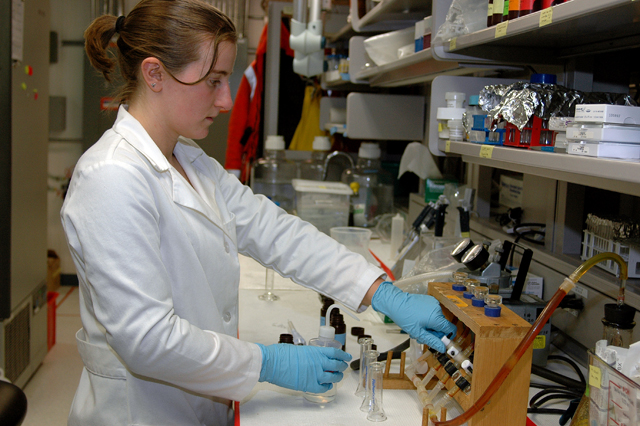
Photo Credit: Peter Rejcek
Alice Alpert processes water samples for Hugh Ducklow's microbes team in one of the Palmer Station labs.
When the Gould departed for its return across the Drake Passage to Punta Arenas, Chile, it took with it the last remaining members of the three LTER science groups. The birders, under principal investigator Bill Fraser Roberta Marinelli, the Antarctic Organisms and Ecosystems As a farewell celebration for the first wave of departing summer crew, we held a second Palmer Open Mic Night of the season. A wide variety of talent took to the stage for more than three hours of entertainment. Spoken performances included readings of short stories and poems, including an original two-act, radio-style crime drama based around station-specific puns. Musical acts included combinations of the accordion, drums, guitar, mandolin, piano and banjo. The evening finished with a set from the Palmer Band, with members of the community and the Gould sitting in for almost every song. Three antenna riggers were also at Palmer in March, updating and fixing the rigging on nearly every antenna around station. They also installed the new Palmer webcam on a radio tower high over station. Not that many years ago, almost all communication off continent involved a ham-radio patch, and now Palmer will be visible to anyone with an Internet connection. New in the neighborhood for the last few weeks has been an iceberg grounded near the station. It’s about the size of a city block, with sheer sides and a smooth top. The massive ice somehow perfectly catches the morning light, disappears into an afternoon snow squall, or has the full moon centered above it at night. So for now, the snow continues to fall and the days shorten. Most of the station’s remaining summer crew will leave in April when a fresh group comes in for the winter months. Projects are wrapping up, and everyone is dreaming of warmer locations. Days grow shorter but summer lingers at Palmer StationPosted March 12, 2010
February has been a busy month around Palmer Station Co-principal investigators (co-PI) Chuck Amsler and Jim McClintock The seven members of the group split their time between the lab and dive sites around Palmer collecting specimens to study. McClintock, Amsler, his wife Maggie Amsler and Bill Baker A different group of divers departed station the middle of February. Underwater photographer Norbert Wu They eagerly collected both video footage and still photography of marine creatures, such as humpback whales, leopard seals, krill and a wide variety of fish. Some small specimens were brought back from the depths to an aquarium for detailed photography and viewing by the station population. The month began with the return of the 17th annual Palmer Long Term Ecological Research (PAL LTER) Working off the ship, two members of Bill Fraser’s seabird research team spent a week studying a massive Adélie penguin population on Avian Island south of Palmer Station. And for a second year, the “birders” landed on ice-choked Charcot Island, even farther to the south, to visit its cliff-side rookery. After just one final night tied up at the Palmer pier to pack and organize, the PAL LTER scientists headed back north to Punta Arenas to conclude this year’s science cruise. The most surprising February visitors arrived in an unusual way for Palmer Station. Five scientists from the LARISSA (LARsen Ice Shelf System, Antarctica) After the British plane dropped off the glaciologists, the Gould shuttled them from Palmer Station to the awaiting RVIB Nathaniel B. Palmer A small ship from the Chilean Navy visited Palmer for a day in the midst of its bathymetric work in the area to map the seafloor. Half of the 50-person crew visited station and stayed for dinner, while a group from Palmer later visited the ship. The ship was familiar because it’s often tied up near the U.S. Antarctic Research Program’s Tourist ships continued to visit Palmer, including the MY Hanse Explorer, which brought Microsoft Chairman Bill Gates and his family to the research base, where he had lunch with station personnel. The weather in February hit wide extremes, with days of strong wind and rain balanced by others of sunshine and calm. One period of wind stranded thousands of krill in tide pools, providing an easy meal for seals and birds. High numbers of krill have also attracted a number of feeding humpback whales to the area. While South Pole and McMurdo Palmer Station supports big science on small crittersPosted February 5, 2010
The animal density around Palmer Station But for the last month there has been a group researching the opposite of this megafauna so often associated with Antarctica. Despite what one would expect, the largest land creature on the continent is a tiny, wingless midge named the Belgica antarctica that ekes out its existence on islands around the Antarctic Peninsula. 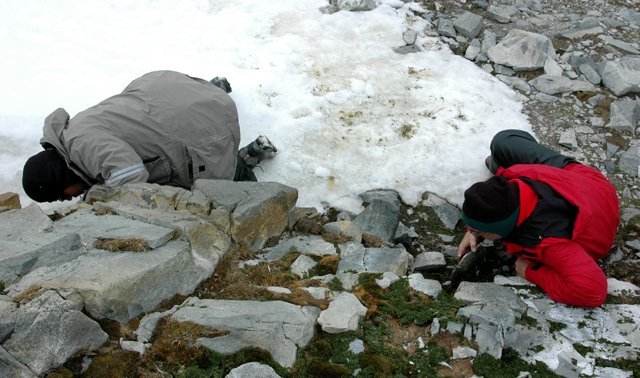
Photo Credit: Peter Rejcek
Scientists Yuta Kawarasaki and David Denlinger search for Belgica antarctica on Humble Island.
The bug has amazing capabilities, such as the ability to lose up to 70 percent of its usual mass to survive the winter season by avoiding the damage caused by freezing. They exist as larvae for two years before briefly maturing into adults during a 10- to 14-day window to reproduce. Rick Lee from Miami University Substantially larger than Belgica, but still quite small, krill are one of the key species in the Antarctic food web. Jonathan Cohen from Eckerd College He conducts experiments to determine what colors of the spectrum they see best to understand how they find food while avoiding predators, among other behaviors. Cohen is often out in an inflatable Zodiac boat, dragging a net in search of the elusive bigeye krill (Thysanoessa macrura), one of the three types of krill in Antarctic waters, and the least studied. During the month of January, scientists on the Palmer Long Term Ecological Research Life on station has also been eventful in January. Palmer’s population peaked at its maxim of 45 people, meaning that the whole group hardly fits together in one room. It’s necessary to show up early and fight for a seat at the weekly science lectures. Recent lecture topics have included mapping Antarctic penguin nesting locations from space, and research involving monk seals and nesting seabirds in the distant atolls of Hawaii. On New Year's Eve, our full population crowded into the lounge for a dance party with live music provided by the station's volunteer band. 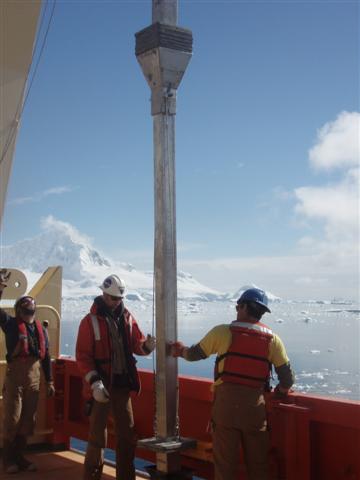
Photo Credit: Adam Jenkins/Antarctic Photo Library
Crew aboard the RVIB Nathaniel B. Palmer handles a sediment-coring instrument.
Well-known underwater photographer Norbert Wu A wide variety of ships visited throughout the month. Several small sailing yachts spent the night tied up in the harbor and enjoyed an opportunity to tour the station. The RVIB Nathaniel B. Palmer Larger cruise ships stop by about once a week with loads of curious passengers. The National Geographic Explorer even visited with Buzz Aldrin, who eagerly compared life at a small Antarctic research station with going to the moon and his dreams of future human trips to Mars. One of the rare perks of working at Palmer is that a guest astronaut occasionally trumps the usual visits by penguins and whales. Ship traffic increases at Palmer Station as summer work peaksPosted January 8, 2010
The ARSV Laurence M. Gould Ross MacPhee David Barbeau Finally, Joseph Kirschvink Ice largely prevented the Gould from gaining access to islands, and late season snow cover proved disruptive to investigating the geology onshore, but all three teams reported successes with their research time. On station, the fellowship of visiting journalists finished their three-week experience through hands-on scientific research. Scott Canon, Jason Orfanon and Angela Posada-Swafford took every opportunity to join in the routines of the science community, helping with all tasks from bird counts to water sampling and lab work. On their final night, the three presented their own science lecture explaining the successes and learning moments achieved over the course of their stay. Overall, they had an increased respect and understanding for the complexity of the environmental research happening at Palmer and the benefit of long-term data sets. The team for Oscar Schofield They brought three remote-operated underwater gliders with them this season that have all “flown” successfully while gathering good data about ocean properties. The deep glider even discovered an underwater trench was far deeper than expected while in its automated up-and-down routine. A second glider was deployed at the beginning of the season’s first phytoplankton bloom, documenting the change in the marine environment. One glider will also deploy during the LTER cruise south of Palmer Station. Bill Fraser’s “birders” group announced the first Adélie penguin chicks on nearby Humble Island in the middle of December, followed soon thereafter by chicks on Torgersen Island. The group will also be active on the LTER cruise looking mainly at several large penguin nesting locations. As we enter the height of summer, cruise ship visitors are more common, bringing people to Palmer from around the globe. They enjoy tours that include an introduction to the science performed here and a sampling of life at an Antarctic research station. One visiting group, part of an Abercrombie & Kent trip organized by longtime Antarctic researcher Jim McClintock, donated a new irradiance meter to the LTER program. It measures the amount of light present for a specific period of time so that researchers can adjust their data for light variations. This radiometer was presented in a ceremony to Alex Kahl, the expedition leader for the phytoplankton group using the gliders out of Rutgers University Around Palmer, the snow pack rapidly vanished in December, mostly thanks to above-freezing temperatures and a steady wind. A few days of rain helped — an un-Antarctic seeming type of weather. The skies cleared for the holidays, providing good boating and hiking opportunities before a Christmas feast and festive gift exchange. Penguins colonize island recently exposed by retreating glacierPosted December 11, 2009
Of all of our science groups here at Palmer Station’s Bill Fraser’s research team with the Polar Oceans Research Group out of Montana routinely visits most of the islands surrounding the station by Zodiac boat measuring and counting many of the local birds. For safety reasons, all boats communicate by radio with the station when they leave one location and arrive at another, so everyone grows accustomed to hearing the daily travels of the birders, with only rare exceptions to their usual patterns. Several weeks ago, things changed when they announced a detour upon their return from Dream Island. They had discovered the first new penguin colony in this area in more than 10 years. Gentoo penguins had nested for the first time on an unnamed island only recently exposed by the retreating glacier. Because everyone with a radio heard the news, the birders were later welcomed home with a barrage of questions and were excited to share the details. 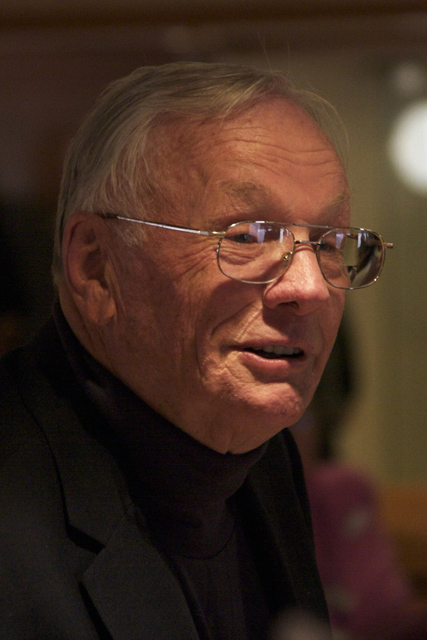
Photo Credit: Jon Brack
Neil Armstrong speaks at Palmer Station.
The other two Palmer Long Term Ecological Research (LTER) Schofield’s team has also launched its first automated underwater glider with plans to deploy a second one soon. All three groups are continuing to prepare for January’s LTER cruise. A couple of cruise ships have already brought a number of visitors to station, even though it’s still early in the tourist season. Palmer was honored to have former NASA astronaut Neil Armstrong as a guest a couple of weeks ago, reminding the 30 people on station that even though it sometimes feels like this is the middle of nowhere, the moon above is much, much farther away. The ASRV Laurence M. Gould They and their principal investigator, Christopher Neill (blog We celebrated Thanksgiving this year with everyone sitting down for a traditional feast that was finished off with a plethora of pies. The days have been warmer in the last month and largely above freezing, so the snow is beginning to melt away rapidly and rock is increasingly exposed. Weather has been calm lately, and a rare week of sun left behind a lot of suntans and smiles. On average, it is cloudy 80 percent of the time at Palmer, so such a solid dose of sunshine was a rare treat. It is now no longer dark at night and summer seems in full swing with active science groups and abundant wildlife. NASA plane flies by Palmer Station as summer takes offPosted November 6, 2009
A visiting airplane becomes a big event at a station entirely supported by ships, especially when it’s a NASA 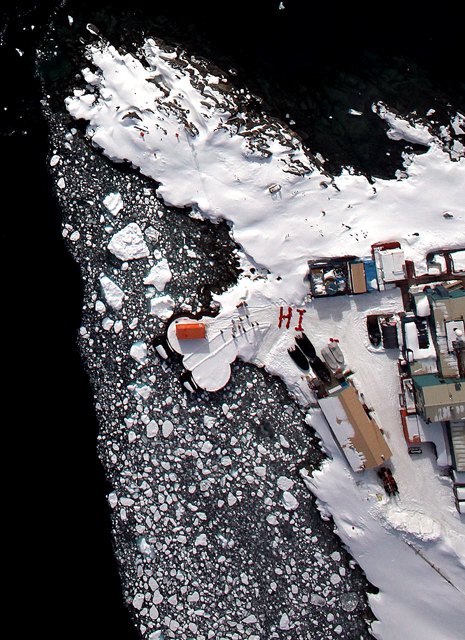
Photo Credit: John Arvesen/NASA
Palmer residents greet a NASA plane flying overhead on a mission to study polar ice.
The space agency’s DC-8 research plane flew over yesterday as part of its Operation Ice Bridge The plane is equipped with instruments to map the shape of the terrain below the ice, which isn’t possible from the usual coverage provided by the agency's dying ICESat satellite. Palmer Station’s Aside from the NASA diversion, Palmer has been a busy station for the last few weeks. The ASRV Laurence M. Gould The Gould also brought Derrold Burnett, the director of Supply Chain Management for Raytheon Polar Services Co. (RPSC) After their departure from Palmer, the Gould’s crew successfully repaired the GPS systems on Hugo Island, a process that took over four attempts because of the notoriously bad weather and ice conditions around the island. The GPS is in support of Eugene Domack’s LARISSA project The beginnings of this summer’s science population also arrived on the Gould, mostly to begin preparations for January’s annual Palmer Long Term Ecological Research (LTER) Oscar Schofield’s phytoplankton group brought along three underwater gliders this year, with high ambitions of launching them to explore the region's “ecological hotspots,” the topic of a recent weekly science lecture. Some of this work is being done in conjunction with Bill Fraser’s group and its study of the local birdlife. “The Birders” are already out in boats visiting islands, watching as the snow melts away to provide the penguins access to the small stones that they use to build nests. Hugh Ducklow’s team is also getting an early start on the summer season before the LTER cruise. They are investigating the mechanisms of climate change on the microbial level in the Antarctic marine ecosystem. Our station has also been busy with wildlife visits. An elephant seal camped out near our seawater pump house for a few days while recovering from what must have been a lost fight for mating rights. Penguins have made a few appearances on station. Nearby Torgersen Island now holds hundreds of Adélie penguins staking claims to nesting spots. Leopard seals are increasing patrols of the shoreline, and the first minke whale was sighted a week ago. Weather extremes have become the norm in our changing season. Days have been either plagued with high winds and snow or calm and clear with warm sun for working outside. Strong winds, though, have often gusted to more than 60 knots and create deep snow drifts all over station. Our days are getting dramatically longer, and soon darkness will become nonexistent. Until then, we’ll hopefully have a few more calm and star-filled nights to enjoy. New summer crew arrives at Palmer StationPosted October 16, 2009
Winter has come to an end here at Palmer Station The summer crew had a longer-than-normal crossing of the Drake Passage, due to some science work conducted en route from the Gould. The scientists aboard the ship, led by Colm Sweeney Many on both sides of the pier were glad when the Gould finally arrived. The new personnel not only assume their normal jobs — such as cook or mechanic — but also take on the responsibility for serving on one or more of several emergency teams. The fire team turnover involved just about the entire station in some form or another. The winter fire team turned over their bunker gear (protective outer gear worn by firefighters) to the summer crew, who received training in the United States before heading south. Part of this process involved a member of the winter team helping a member of the summer team set up his or her fire-gear stations. The new fire team members then practiced donning their gear and using the self-contained breathing apparatus. Finally, each person did a simulated blind search to make sure the gear worked properly. Then it was time for a drill. This required the summer crew to respond as if a real fire was under way, while the outgoing winter fire team shadowed them. This helps ensure that the summer crew could practice gearing up and conduct an exercise while the winter team was still around. After a successful drill, both fire teams met up for a debriefing to discuss the drill and address any areas of concern. 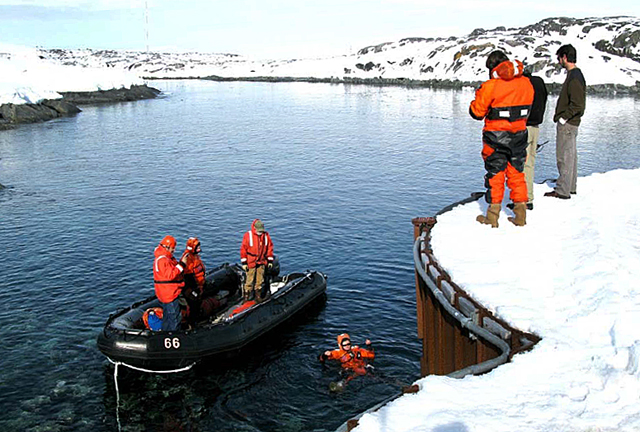
Photo Credit: Rebecca Shoop
The Palmer ocean search and rescue team conducts a drill with the new summer crew.
The turnover of the glacier and ocean search and rescue teams (GSAR and OSAR) was a little less involved, and amounted to little more than just a gear changeover. In the coming weeks, both teams will get more time to train and learn how to best use the resources at hand in the event that they need to respond to an actual emergency. Just as important as personnel turnover was the refueling of the station’s bulk tanks. This year the Gould offloaded 57,000 gallons of fuel. A fueling team assembled to transfer the fuel from the ship. Operating in shifts, the team members set up the fuel hose and walked along the fuel lines to catch any leaks before any fuel was released to the environment. Thanks to careful preparation and the teamwork of all involved, the operation took about six hours without spilling a drop. After a week of turnover, the Gould set sail from Palmer with 11 eager winter-overs glad to be northbound. The sun and wildlife return to Palmer StationPosted September 11, 2009
Winter here at Palmer Station The sun isn’t the only thing we’ve been seeing in the sky. It was during one of the clearest days we’ve had in the past month that a plane from Chile’s Frei Base decided to pay us a visit. We were startled from our lunches with a sound that we haven’t heard this winter. It was as if some Antarctic creature had decided to pay us a visit; everyone in the dining hall was pressed against the windows and then shortly outside taking pictures. After doing a few flybys, the plane disappeared into the clear, blue sky. Such clear blue skies have been more frequent this past month, bringing calm, beautiful days — perfect to get in boats and explore the islands near Palmer. It was on just such a day that most of us left the station for a few hours for some much-needed time off station, and also the first sightings of penguins starting to return to the area. The islands around Palmer, many of which are only open for use during the winter, are popular, alternative locations for recreational activities. Many are perfect for skiing or sledding down the hill on your backside, laughing and having a great time the whole way. Camping is also an option on these islands, though most of the camping has been spent in Palmer’s “backyard” area on Anvers Island. But with temperatures warming and less sea ice, island camping is becoming more attractive. The return of the ARSV Laurence M. Gould Winter isolation also means that the flu or other nasty bugs could arrive on the ship after an uneventful and relatively healthy winter. Preparations are being made to handle anyone who happens to become infected and to help stop the spread of any flu or other illness. Most of us are looking forward to the end of the winter and turning over our jobs to the incoming replacements. And, most of all, the ride back north when the Gould heads back to port to Punta Arenas, Chile, and beyond. Palmer Station emergency teams train for the unexpectedPosted August 7, 2009
With ice filling in both Arthur Harbor and Hero Inlet, winter is making certain we know it’s here at Palmer Station It has been a month from the time the ARSV Laurence M. Gould Compared to the International Polar Year Instead, logistics personnel find their time taken up by inventory. FEMC members are now focusing more on finishing projects rather than helping science groups set up to go with their projects’ needs. This is a much more isolated winter, one in which we must be able to rely on each other. To that end, most folks have their normal jobs, but are also members of an emergency response team of some sort or another. The trauma team meets once a week for an hour for training. Topics can range from how to package patients for transport, how to take vital signs and to give sutures, and even how to take X-rays. Trauma team members also serve as assistants to the doctor when there are patients who need care. This could mean taking vitals over an overnight shift to allow the doctor to sleep, while still keeping an eye on the patient, or even helping with lab work, like during a recent cholesterol screening of station personnel. 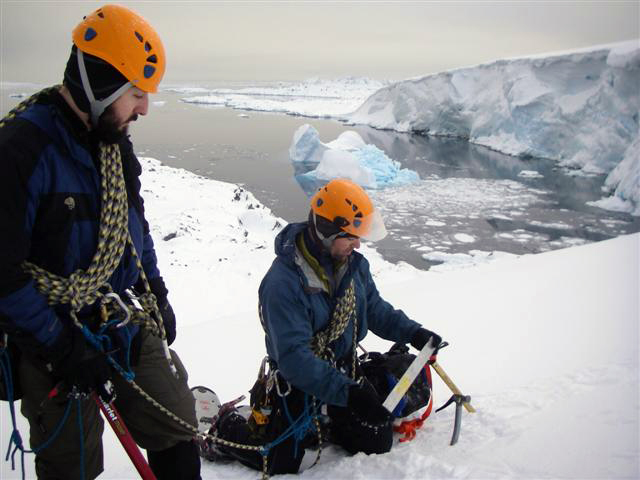
Photo Credit: Susannah Coates/Antarctic Photo Library
Jeff Braucher, left, and Ken Keenan conduct GSAR exercises on a glacier.
Due to Palmer’s marine location and the surrounding islands, the station has a small fleet of Zodiac boats for marine operations, which requires the need for an Ocean Search and Rescue (OSAR) team. Before coming to the station for the season, most of the winter-over crew trained in OSAR at Lake Powell in Arizona. There they learned the basics about search and rescue, such as how to use different safety equipment. Now they apply those basic lessons in monthly exercises around Palmer. Training sessions involve playing hide and seek using GPS, practicing landings in rough swells, learning the surrounding islands in the Palmer boating area, and improving general boating skills. With a glacier behind station, along with some of the icy terrain on the surrounding islands, Palmer also has a Glacier Search and Rescue (GSAR) team. The GSAR trains mostly on the glacier, learning different ways to work safely to rescue anyone who may, for example, have fallen down a crevasse, and then how to transport them either back to station or to a boat if on an island. The last emergency response team on station is the most important — the fire team. Just about everyone on station is involved with responding to a fire alarm. The same group that trained at Lake Powell also trained for a week in Arvada, Colo., learning the skills needed to keep a fire from spreading, and more importantly, how to find and save people who may be injured in a smoke-filled area. So we fill our days with not just our day-to-day jobs but also training and learning skills that we hope we never need to use beyond drills and exercises. With each drill, we learn new things and grow more confident in our ability to respond to a real emergency as needed and as safely as possible. Hazardous waste heads north from Palmer StationPosted July 10, 2009
The past month here at Palmer Station For the past few months, a group of “wasties,” led by Mark Furnish, has been hard at work consolidating and getting ready to ship all of the hazardous waste off the station to the United States for disposal. Furnish and his crew have spent most working hours outside among the milvans, or ship containers, housing the haz waste, and moving it down to the Palmer pier to be loaded onto the ARSV Laurence M. Gould All the long hours of work finally paid off with the Gould’s arrival just before Midwinter’s day, after thick sea ice slowed its arrival. The vessel also made a side trip to Hugo Island to attempt to repair a GPS station after its initial port call, but was unable to make the repair. The waste crew, with help from Palmer Logistics, managed to complete loading of the waste milvans on the pier and finally onto the ship. On the days preceding the departure of the Gould, word had made its way to station that the ship might have to leave a day earlier than planned. It turns out that one of the Chilean stations, Base General Bernardo O’Higgins Riquelme (O’Higgins Base), had lost power and would need the Gould to deliver some parts for a generator. The mission would require the Gould to travel to another Chilean Base, Base Presidente Eduardo Frei Montalva (Frei Base), on King George Island, to pick up some equipment that was being flown there from Punta Arenas, Chile. After the equipment was on board, the Gould would make its way to O’Higgins on the Antarctic Peninsula to unload it. Before going to Frei Base, the Gould attempted a second landing at Hugo Island to try to repair the GPS unit installed earlier this season. The GPS measures the effect of ice-sheet loading and the unloading on the landmass. Unfortunately, large swells stymied the vessel’s return. The Gould attempted to make its way towards Frei Base, only to have to backtrack and take an alternate route due to sea ice. Eventually the mission was canceled altogether because the pack ice at Maxwell Bay prevented the small-boat operations needed to get the replacement parts to the Gould. In the end, the Gould returned to Punta Arenas. It hasn’t been all work at Palmer this past month. Right before the Gould arrived for the hazardous waste run, we celebrated Midwinter’s day a few days early with a splendid dinner. Even though most station personnel were involved in preparing the feast, the main creative force behind it was station chef Eric Cooper. Some highlights from the dinner included smoked salmon mousse, krill bisque, fresh-baked breads, and a roast suckling pig. While the dinner was eaten a few days early, the celebratory polar plunge was held on Midwinter’s day. With the Gould gone, Palmer will be without any new station personnel or science groups until the end of September. While the winter crew is looking forward to finishing out the season, we all realize just how lucky we are to have such a great crew this year. We all wish all the other stations on the Ice a fine Midwinter and hope they are enjoying their winter as much as we are enjoying ours. Palmer goes prime time with Oprah appearancePosted June 5, 2009
Probably the most talked about event at Palmer Station Palmer’s own research associate Neil Scheibe was chosen to participate on a segment on the popular daytime show entitled "Where the Skype Are You" during a recent taping of the show. Appearing with Neil on Oprah was Bruce Sidell Skype is normally not allowed to be used on the U.S. Antarctic Program To ensure a successful Skype with Oprah, a special laptop was set up to have top priority on the network. A side benefit to this was that we needed to test the laptop for usability with Skype and Palmer’s Internet connection. Several station personnel were able to contact and talk with friends and family back home for testing purposes. Science personnel also conducted several outreach Skype sessions with schools back stateside. When it came down to the big day, we were lucky enough to have clear skies that enabled Oprah and her viewing audience a view of the glacier behind Palmer. Both Neil and Bruce did a great job telling Oprah and her audience about station life and the effects of global warming to the environment around Palmer. About two weeks after taping, the show aired to a packed Palmer lounge. The LMG has brought two science groups to the station for a six-week cruise. The group led by Sidell (University of Maine) and Kristin O’Brien (University of Alaska Fairbanks) Douglas Nowacek, with Duke University Soon the current LMG cruise will come to an end and with it the current science season here on station. The next work includes a hazardous waste run in the coming weeks. After that, Palmer will just be left with its winter-over crew to finish out the season. Season turn-over complete at PalmerPosted May 1, 2009
After starting out with a busy first week in April, thanks to turnover with the summer crew and fueling operations, the winter personnel at Palmer Station 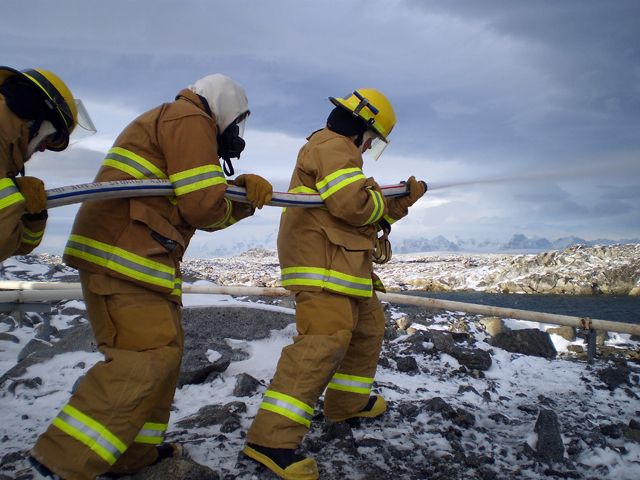
Photo Credit: Ken Keenan
Palmer personnel Greg Cocco, Harry Snyder and Sean Bonnette conduct a fire drill.
Most of the winter crew was lucky enough to join Robert Blanchette’s The Palmer winter-overs took the opportunity to explore both Whales Bay and Pendulum Cove. Thanks to the warming effects of thermal vents under the sands of Pendulum Cove, just about everyone abroad the ARSV Laurence M. Gould During the week of turnover, the Gould, along with Eugene Domack’s Back at Palmer, the winter fire team completed it turnover duties, with a combination drill and training exercise that successfully extinguished a mock fire in the clothes dryer on the second floor of the GWR (garage, warehouse and recreation) building. Another drill followed the next week that gave the fire team the chance to practice using charged hose lines, and to rescue an unconscious victim from the Boathouse. With the onset of winter fast approaching, the penguins around station have left the area except for a few stragglers. While out on a boating trip, a small group of station personnel witnessed firsthand the role of penguins in the food chain when a leopard seal attacked a lone gentoo penguin. In an instant, the leopard seal had emerged from the water under the gentoo, its mouth firmly grasping the penguin as it leapt from the water like a breaching whale, to return back under the ice-blue water with its fresh catch. The Gould left the winter crew with a night departure and the remaining station personnel did a polar plunge to wish those leaving a safe trip north. Winter changes under way at PalmerPosted March 16, 2009
Winter is quickly approaching at Palmer Station 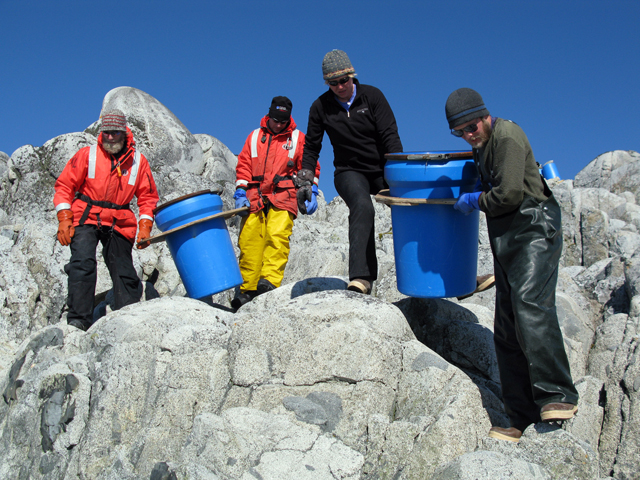
Photo Credit: Jon Brack
Jeff Otten, Ryan Wallace, Louise Hamlin and Kevin Lindburg, from left, change out a survival cache on Outcast Island near Palmer Station. The cache contains things like tents and stoves should someone spend unexpected night off the station.
We had a rare, clear night sky two weeks ago, with a dense blanket of stars, which happened to be on the night the Kepler Telescope Louise Hamlin, the research associate responsible for all science at Palmer of a geophysical nature, was the principal instrument engineer for NASA’s Jet Propulsion Laboratory Other excitement on station has surrounded some unexpected guests. A group of scientists under Ross MacPhee Both MacPhee, from the American Museum of Natural History Our local scientists have been busy with everything from weighing bird chicks to sampling seawater. Oscar Schofield’s The “Birders,” Bill Fraser’s seabird ecology group, have included many station volunteers in the process of weighing and measuring fledging Adélie penguin chicks. Chicks have to be measured when their chick-down is almost gone and new feathers have grown in completely. These chicks still haven’t figured out their need to feed themselves now that the parent penguins have abandoned them to molt before the winter approaches. The Birders have spent their remaining time mainly studying the local skua and giant petrel populations, species far less rigorous in their breeding cycles, which won’t see their offspring leave the nest for several more months. The final cruise ship of the season will visit the station this week, concluding an active and interesting summer of visitors. Fewer ships made the trip this year than previously, but we still managed to share our science and home with hundreds of happy and curious guests. Our search and rescue (SAR) teams are also finishing a safe and productive season. Ocean SAR has changed out two island survival caches and Glacier SAR practiced a double haul system, successfully dragging a snowmobile on the ice. Most people on station will depart with the next arrival of the Gould, and we are preparing for a busy turnover with the new station members. The increasing darkness and change in weather are signs that it’s time to leave and pass our home off to the next occupants. After seven months here, it will be both a sad and welcome departure. Wildlife action peaks at PalmerPosted February 6, 2009
Wildlife has been a highlight of the last month at Palmer Station The penguin chicks have grown dramatically in the last month to nearly the same size as their parents. In the last week most have begun to molt and will soon fledge their nests for the first time. The “Birders,” a nickname for Bill Fraser’s research team, have continued a busy summer schedule studying almost everything with feathers on all of the nearby islands. They’re currently in the process of weighing and measuring chicks before nests are left behind as species move north for the winter. We had one rare sighting of a stray Macaroni penguin amongst the Adelies on Torgersen Island. Their usual habitat is far north of here, so it was a surprise to encounter one this far from their normal warmer habitat. Daily sightings of humpback whales, by the scientists in Zodiac boats and from the dining facility windows at the station, have become common, and are enjoyed by all. The two Palmer artists-in-residence are sometimes the first to spot these giants of the deep when they’re out working on their month-long projects. Oona Stern (blog Cheryl Leonard (blog Norbert Wu, a famed underwater photographer known for his Antarctic images from the Ross Sea, is at Palmer for the first time diving and photographing the underwater habitats here. He and his assistant Conor McCracken have been making at least two Zodiac-based dives a day, after which they can often be seen snorkeling in Hero Inlet getting as much time in the water as possible during their month on station. We have hosted a few scheduled tour ships this month, some as big as cities and others as small as houses. Passengers from the smaller ships come ashore for a tour of the station and for a chance to indulge in our Antarctic-famous brownies. The visitors are always thrilled for the opportunity to see the station and hear firsthand about the science happening at Palmer. The U.S. Antarctic Program Our station population is up to 32, the highest it’s likely to get this summer season. The station continues to be both quiet and active, subtly tucked away on our little rocky outcropping amongst some of the most beautiful scenery on the Antarctic Peninsula. We all feel lucky to live and work in such a place as this, complete with everything from ugly molting penguins to playful humpback whales. Tourist season under way at PalmerPosted December 19, 2008
“It’s diving!” was announced as the torpedo-esque glider descended into the cold water. The bright yellow color was visible for a few moments before disappearing out of sight, hopefully for the next several weeks if all goes as planned. Principal Investigator Oscar Schofield’s team is at Palmer Station “The Birders,” Bill Fraser’s seabird researchers, have jumped at every window of good weather to get out in the field. Their work takes them to almost every nearby island to monitor the behavior and breeding patterns of a wide variety of Antarctic seabirds, continuing decades of research conducted by Fraser. [See article: Local extinction.] They’ve been banding and recording giant petrels and skuas, performing a full census of the gull population and maintaining their observations of nesting penguins. On nearby Torgesen Island, Adélie eggs have begun hatching, and the faint peeping of the small chicks has the Palmer community smiling like proud parents. The RVIB Nathanial B. Palmer Recent Thursday evening science lectures have covered the work of both of our resident science groups; impressions of current events in Pakistan; and Kwajalein Atoll and its strategic role in WWII. We were even treated to an update of recent discoveries in our solar system by resident research associate and NASA Tourist cruise ships are now our most common visitors, with an average of about one a week. Our guests seem thrilled to receive a quick tour of the station and learn about the science and research being conducted here. [See related article: Tourism influx and the sidebar Cruising around.] Thanksgiving was marked by a rare two-day weekend that began with a meal fit for royalty. All 25 of us sat at one long table stretching the length of the dining hall and feasted family-style on two roasted turkeys with all of the fixings. The following night we celebrated further with an open mic night in the Boathouse full of live music and storytelling. Looking to the future, the New Year will bring the ARSV Laurence M. Gould Palmer prepares for long summer isolationPosted November 14, 2008
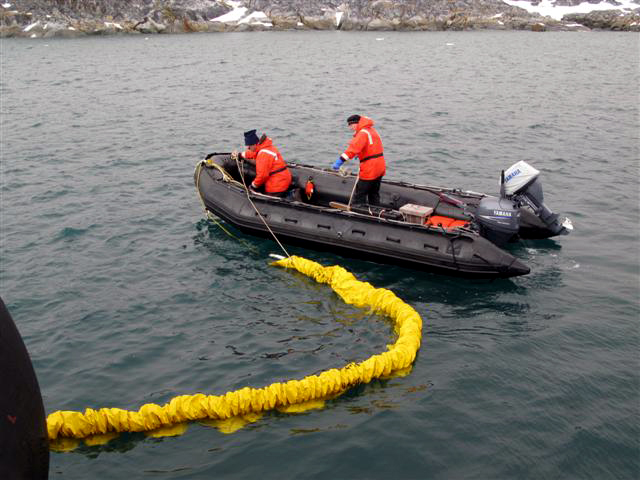
Photo Credit: Rebecca Shoop/Antarctic Photo Library
Palmer Station's spill response team perform a drill on the water.
The summer season is in full swing at Palmer Station This unusually long period between cruises has some referring to our isolated months as a “mini-winter.” Fresh vegetables will be scarce for the upcoming major holidays, and we had to send any outgoing gifts in September. Despite this, the 26 of us who remain don’t seem to mind and are enjoying a station with only just over half of its usual summer population. Science is going strong with two groups with the Palmer Long Term Ecological Research (LTER) 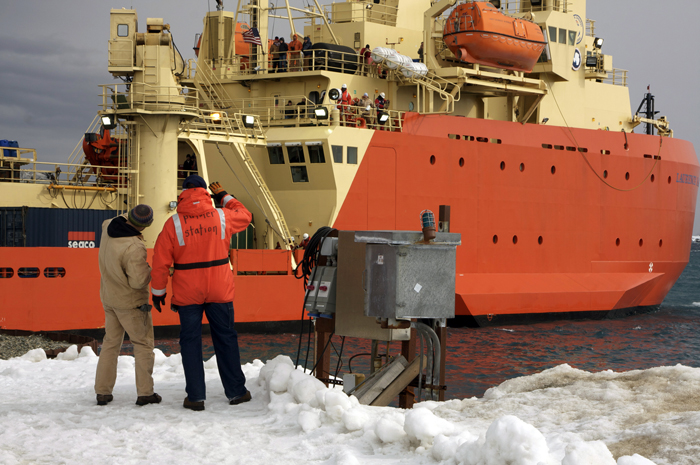
Photo Credit: Jon Brack
The ARSV Laurence M. Gould makes its last port call at Palmer Station until January.
With a pair of shiny yellow underwater gliders, the phytoplankton group with new LTER principal investigator Oscar Schofield, is preparing for their first launch in a couple of weeks. The bulk of their work will take place during the LTER cruise in January when the gliders will journey hundreds of miles south along the peninsula towards Rothera Station. [See related story: Below the surface.] For now, Schofield’s team is preparing and testing their equipment to determine the feasibility of using their science package in icy waters. The artist-in-residence, Scott Sternbach All station safety teams have completed initial drills with their summer crews. The spill response team successfully deployed the containment boom last week during a drill. This week the glacier search and rescue (SAR) team practiced self-arrests on a nearby glacier and the trauma team practiced their needlework with blood-testing procedures. Ocean SAR is constantly on the ready as the science groups travel throughout the nearby islands and on the water collecting their data. The new month means another fire drill is surely in the works and will likely surprise everyone with yet another mock emergency for the volunteer crew to tackle and learn from. Outside of work hours, a recent Halloween party attracted almost everyone on station, including Fidel Castro, Cleopatra and even Hermey the Misfit Elf. A string of nice weather and more daylight after work has allowed for skiing on the glacier and games of Frisbee golf in the backyard. The first tour ship visit is only two weeks away, so tour guide training will soon be in full swing to prepare for the arrival of happy visitors. [See related article: Tourism influx and the sidebar Cruising around.] The 26 of us will surely stay busy for the couple of months between boats as days continue to get longer and warmer. Crew swaps out at PalmerPosted September 26, 2008
McMurdo Station usually takes all of the fanfare that accompanies a new field season in Antarctica. But at Palmer Station, some personnel are swapping out as summer officially kicks off on the Antarctic Peninsula. The swap happens twice per year — once for the summer season and once for the winter. The transition was busy but smooth, according to Eric Pohlman, outgoing Palmer winter site manager. "It's chaos but a good chaos," he said. The five-day port call by the ARSV Laurence M. Gould also included the delivery of fuel. More than a dozen support personnel switched out jobs. Some positions only take a few days of turnover, while others, such as the medical doctor, require longer transitions, meaning outgoing employees will not leave until the Gould returns later in October, Pohlman explained. The transition also requires turning over the station's volunteer fire brigade, search and rescue team, and ocean search and rescue team. "We pretty much do a [fire] drill, and then the new team [is on the job]," Pohlman said. Palmer did find time in the hectic few days for the winter-over medal ceremony, when those who have spent the dark and cold months in Antarctica receive recognition of their service. "It's kind of unique for a middle manager to give out medals," Pohlman mused. It continues to be a relatively dry year at Palmer Station, according to an August weather report by the station’s research associate Payot Scheibe. Despite a 24-hour dump of about 30 centimeters (nearly a foot) of snow in August, snowfall for the month still came in at 46 centimeters. The total accumulation for the year, 193 centimeters, is well below the historical average of 246 centimeters. August also marked the first sea ice around Palmer Station for the season. Christopher Seliga, winter assistant supervisor of laboratory operations, reported numerous birds were seen during the month, including blue-eyed shags flying in large flocks or congregating on various islands. Other commonly seen birds around Palmer Station in August were giant petrels, sheathbills, kelp gulls and Antarctic terns. The only penguin sightings have been some gentoos spotted in the waters early in the month, before the sea ice set in. Sea ice clears out as summer season gets under wayPosted October 7, 2011
The sea ice, which surrounded Palmer Station Although the sea ice was no longer visible from station, there was enough of it surrounding the peninsula to delay the arrival of the research vessel Laurence M. Gould 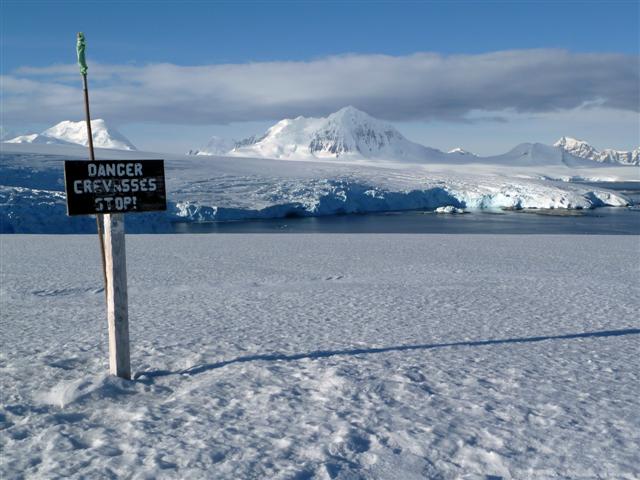
Photo Credit: Mindy Piuk/Antarctic Photo Library
A sign warns of crevasse danger at the top of the glacier that sits behind Palmer Station.
Winter and summer crewmembers worked together to offload fresh and frozen food. Several projects were planned for the port call, including the semiannual station refuel. Transferring fuel to Palmer Station from the ship is a station-wide project with many personnel involved in setting up, monitoring, and taking down the needed equipment. Many of the incoming summer personnel are returning crewmembers, picking up where they left off in March. Station positions and emergency teams turned over duties from the winter to the summer crew as well. The Gould left in late September, taking away half of the winter crew and leaving behind 35 station members, either completing their winter season, continuing their research, or beginning their 2011-12 summer at Palmer Station. |
Home /
Around the Continent /
Palmer Station Archives
"News about the USAP, the Ice, and the People"



For USAP Participants |
For The Public |
For Researchers and EducatorsContact UsU.S. National Science FoundationOffice of Polar Programs Geosciences Directorate 2415 Eisenhower Avenue, Suite W7100 Alexandria, VA 22314 Sign up for the NSF Office of Polar Programs newsletter and events. Feedback Form |

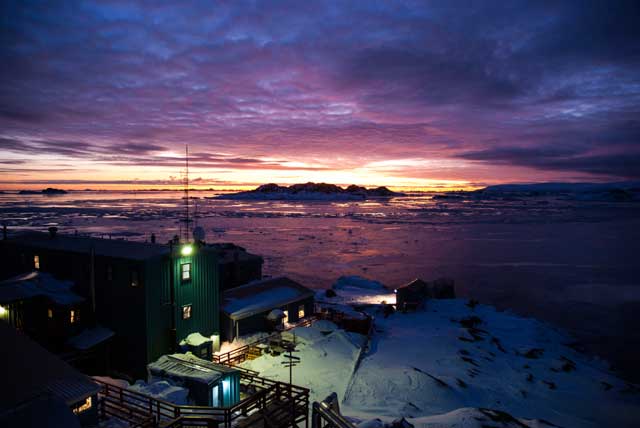
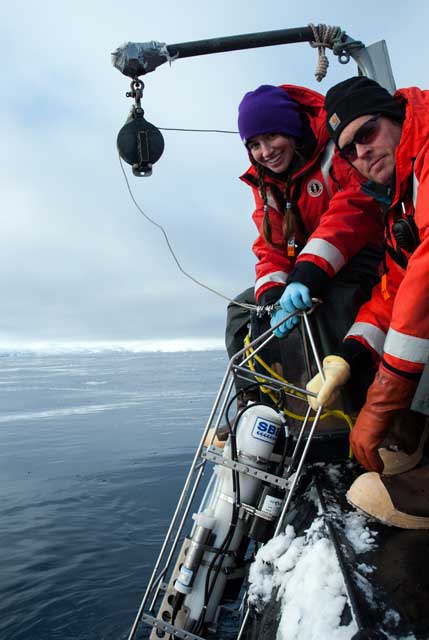
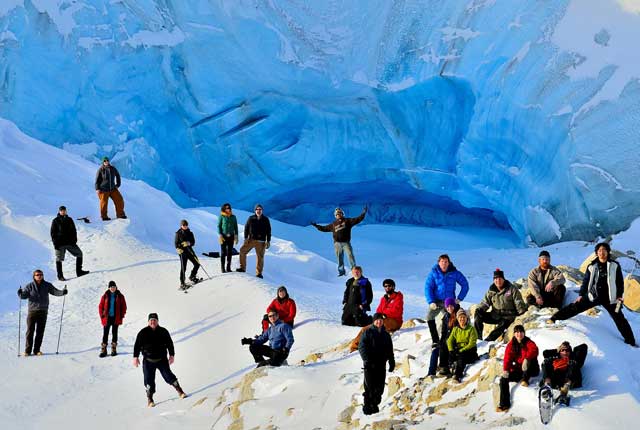
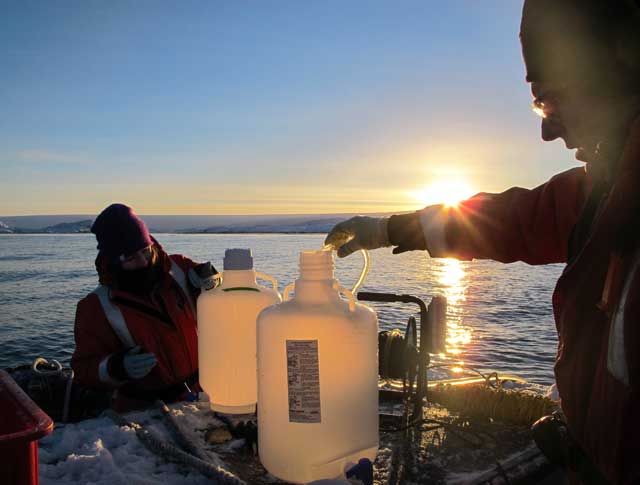
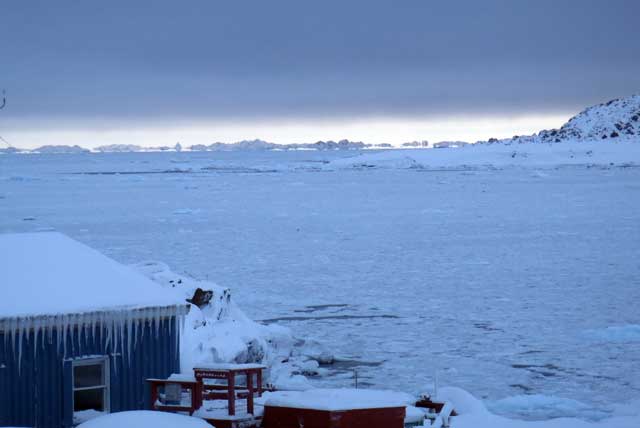
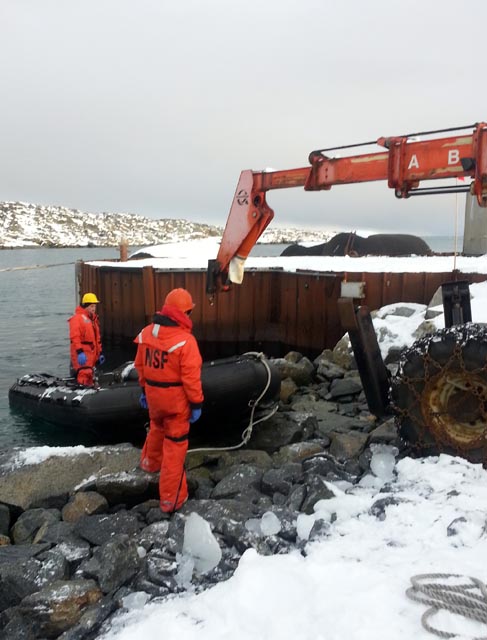
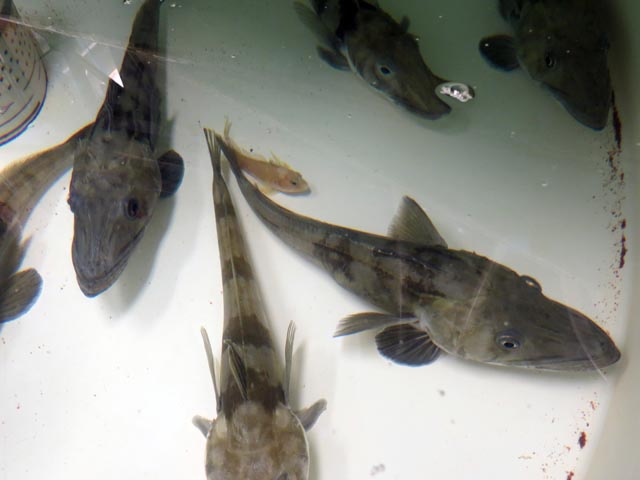
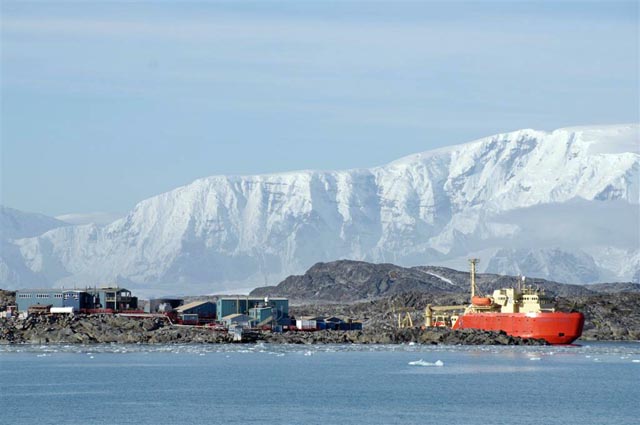
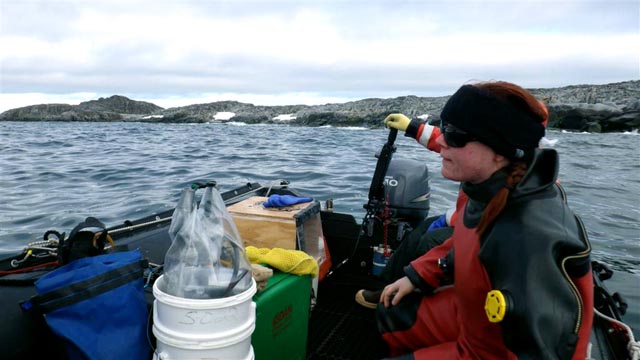
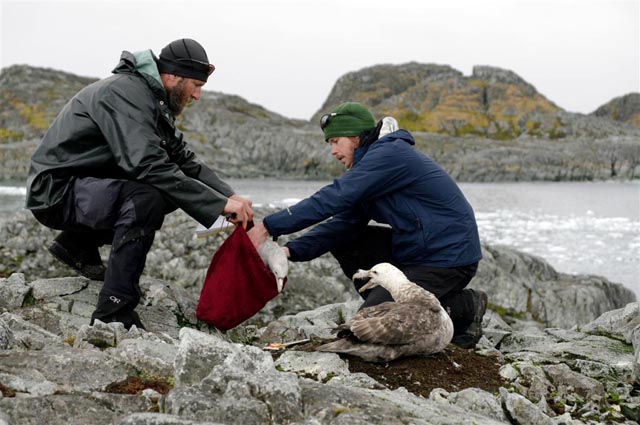
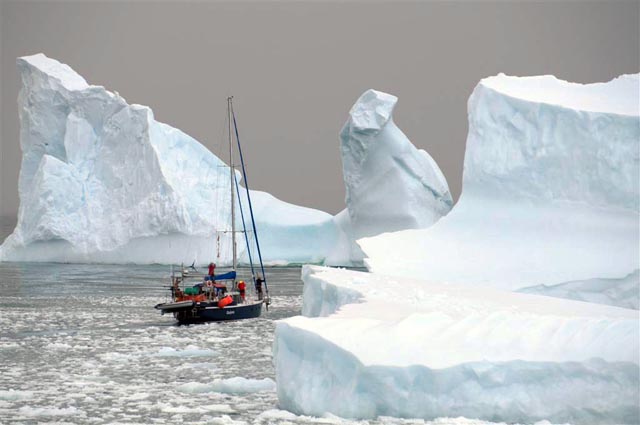
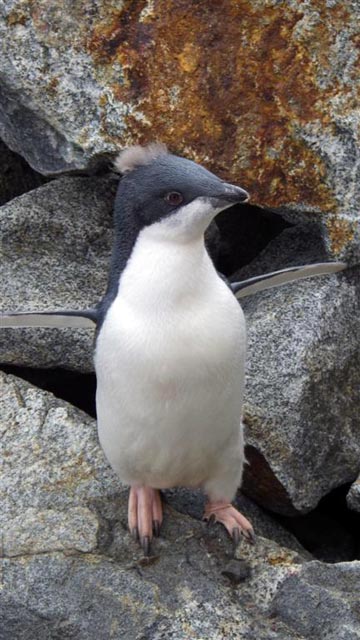
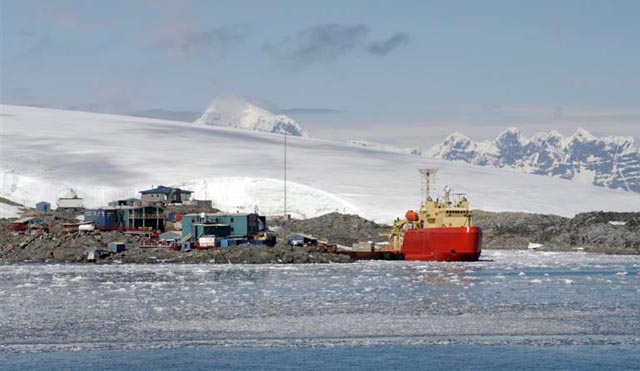
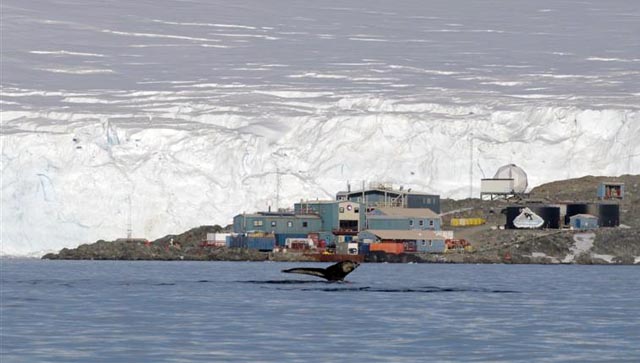
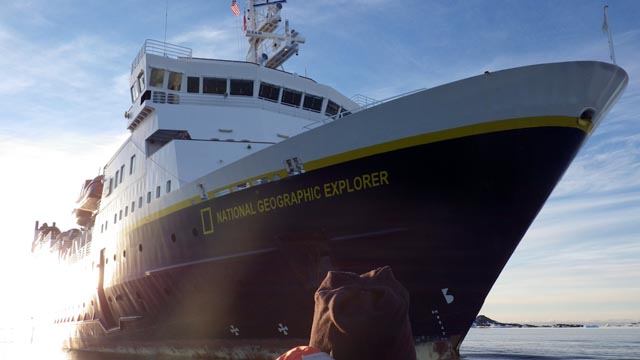
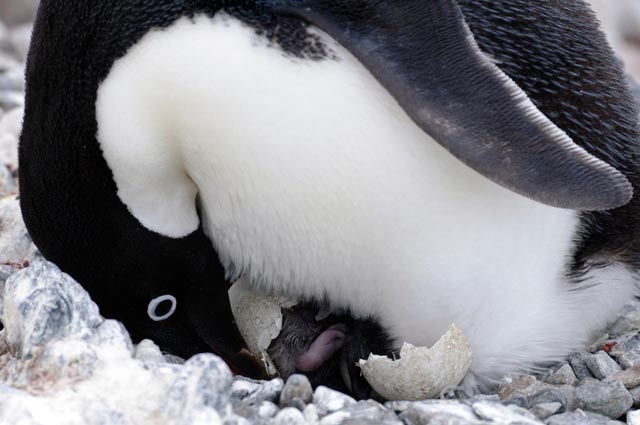
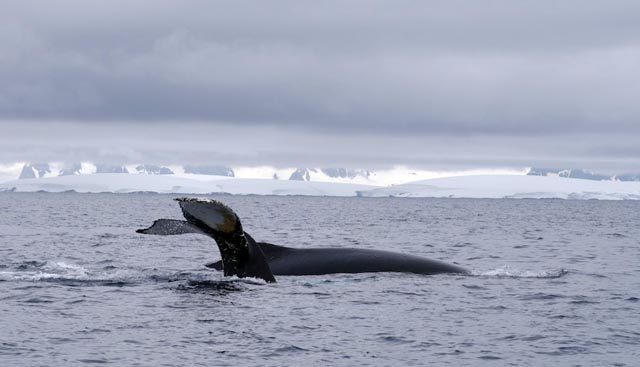
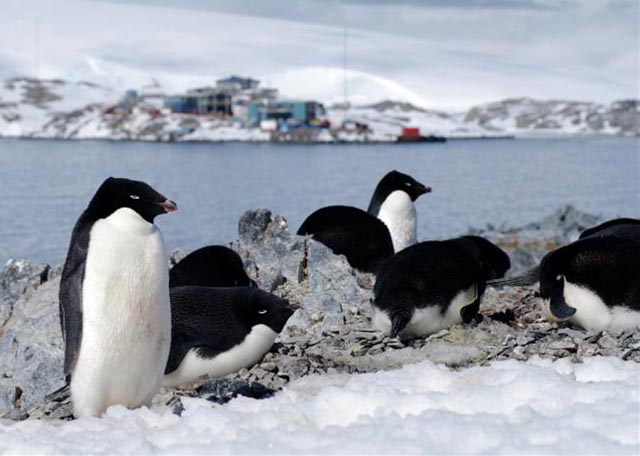
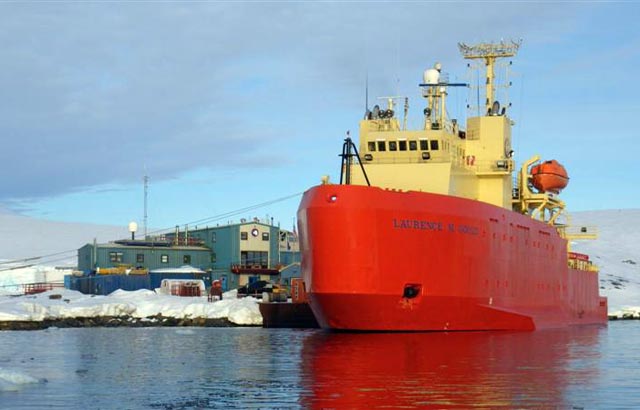
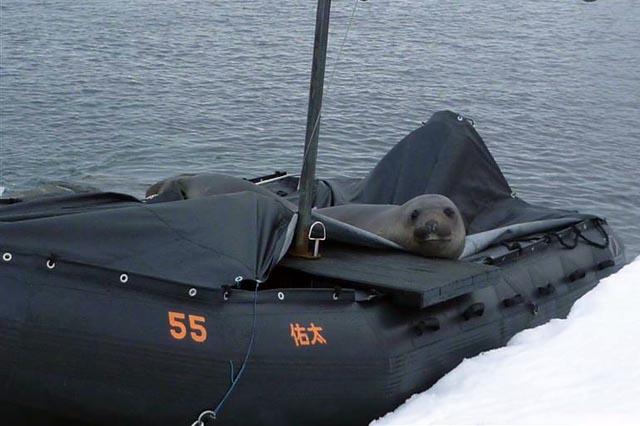
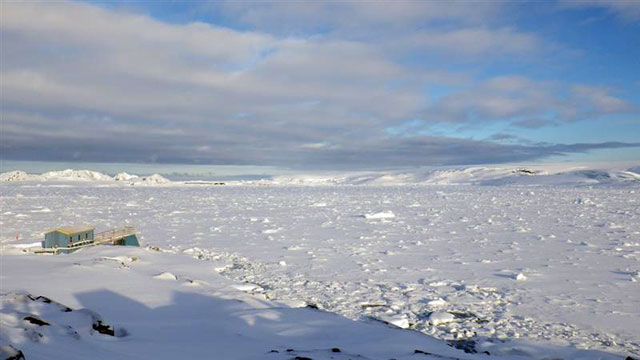
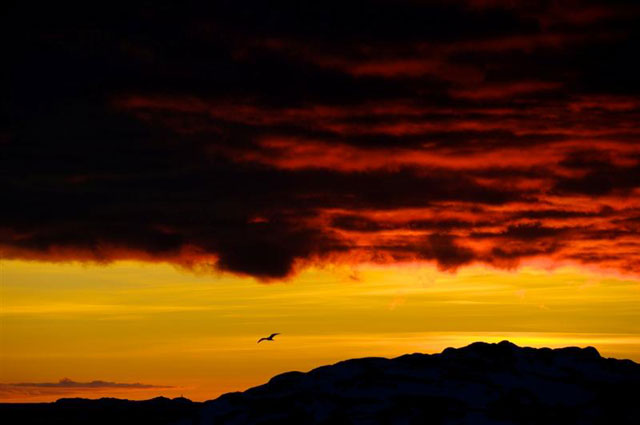
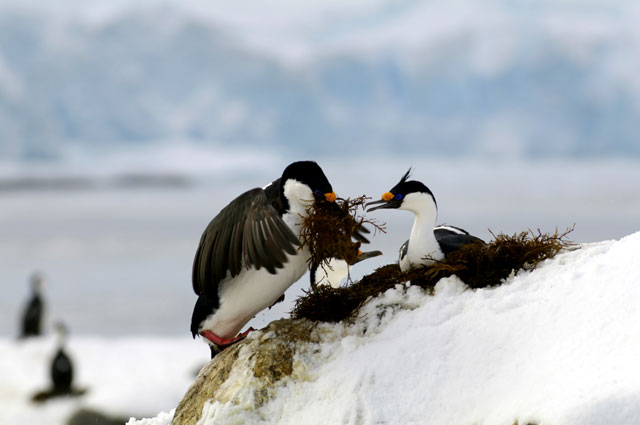
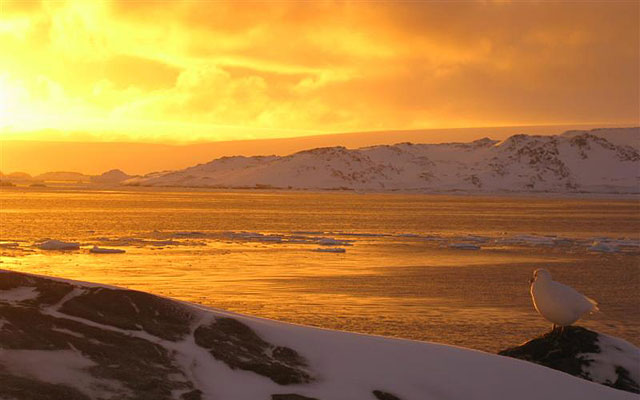
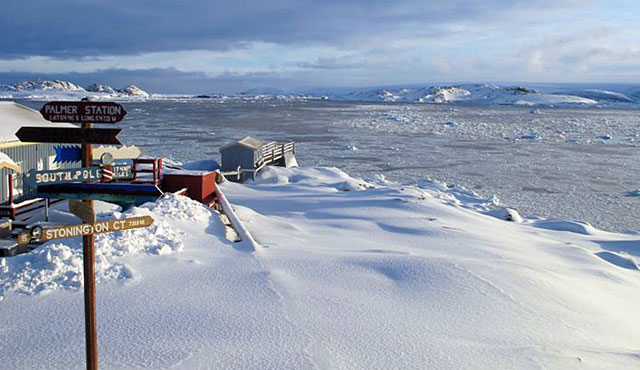
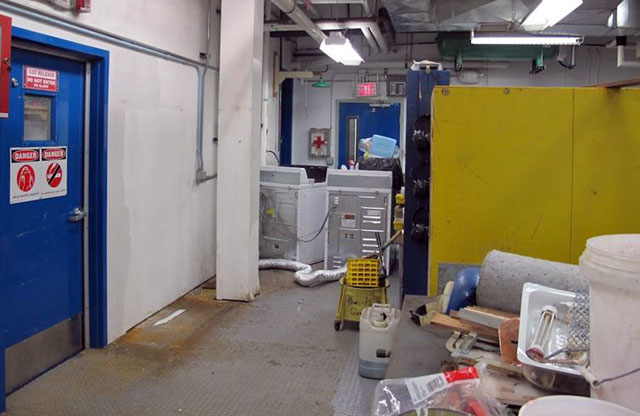
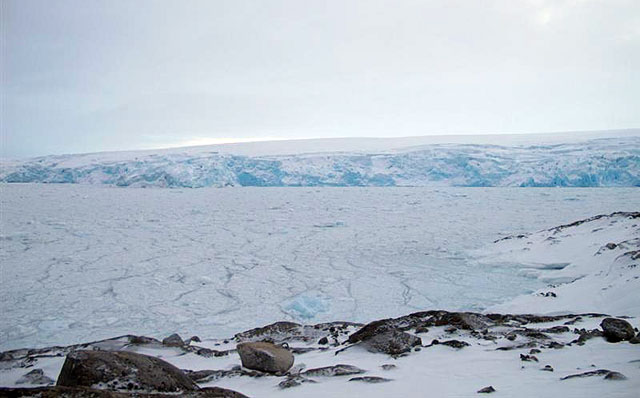
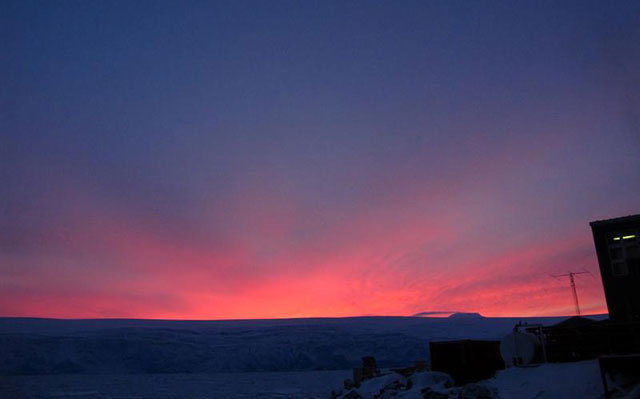
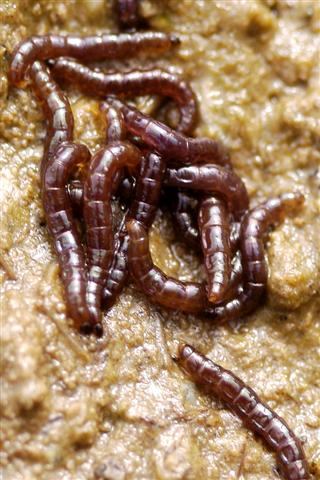
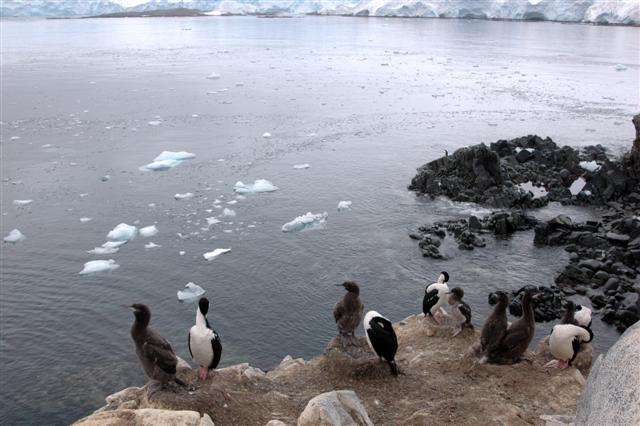
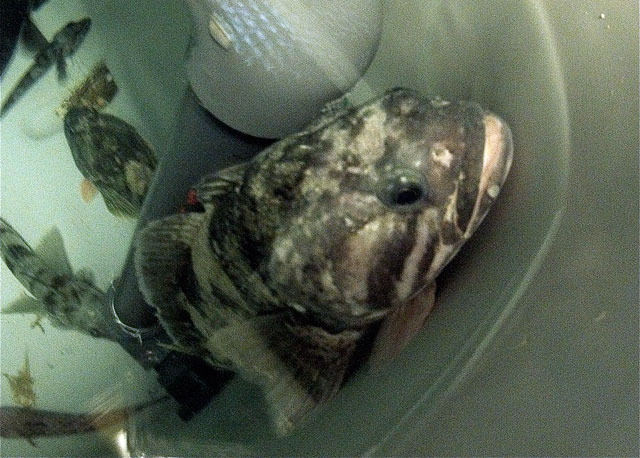
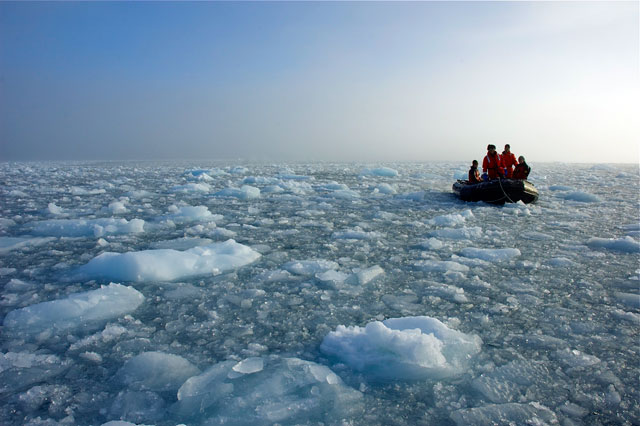
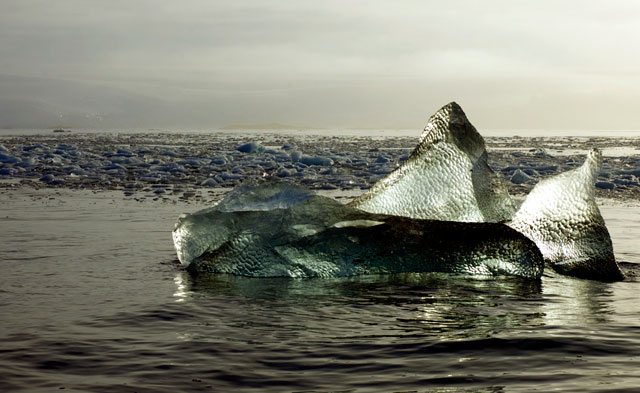
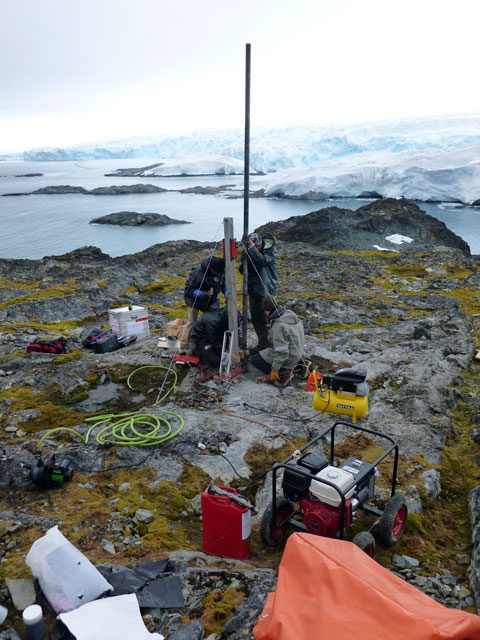
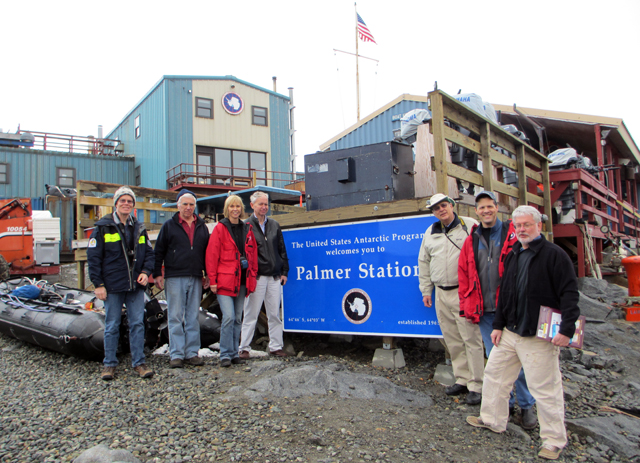
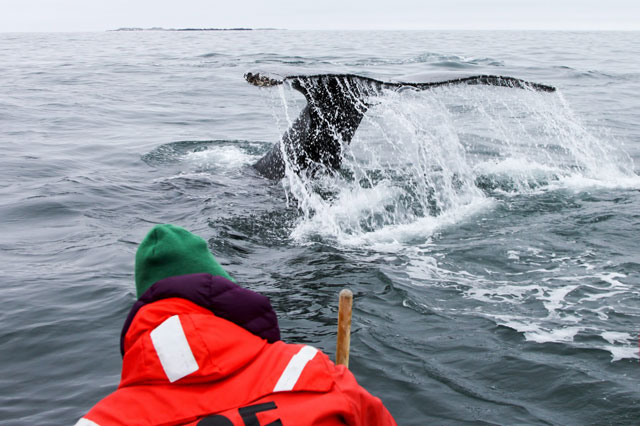
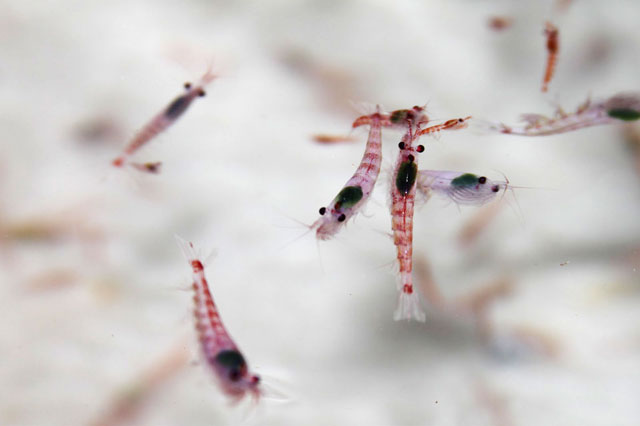
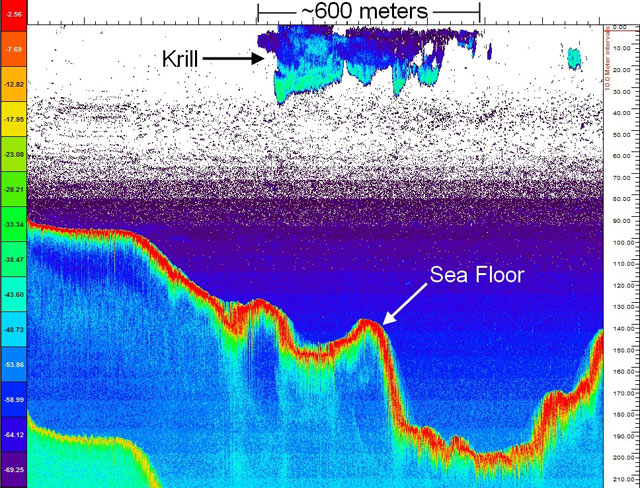
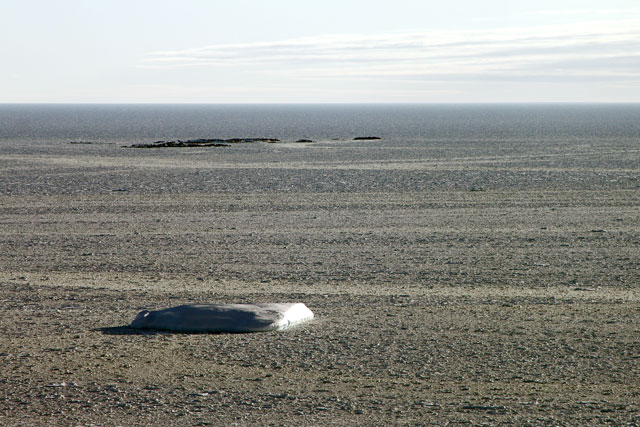
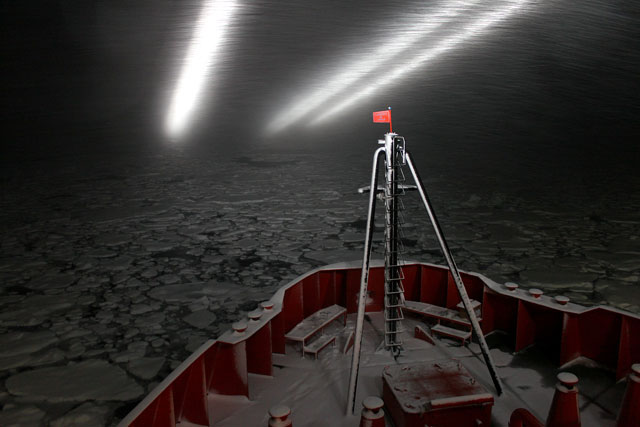
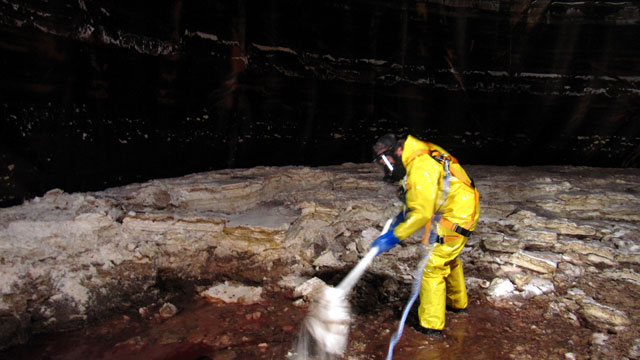
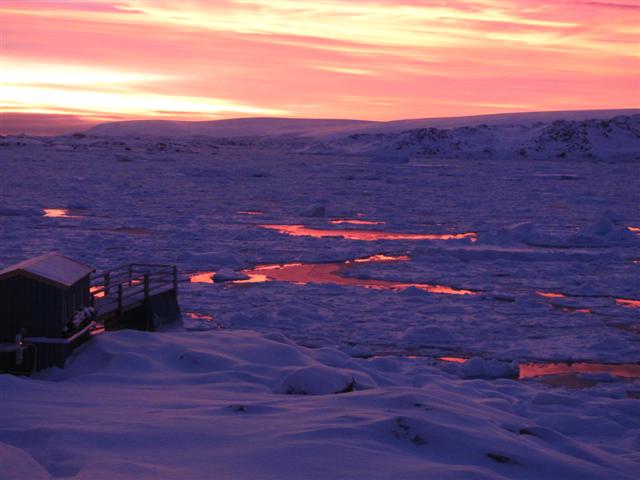
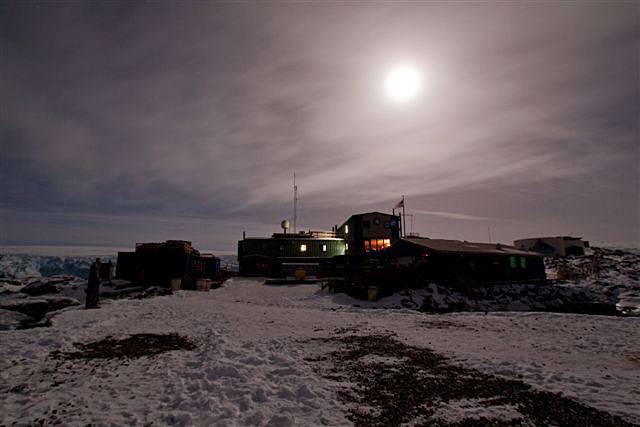
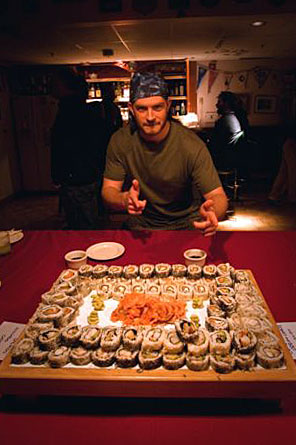
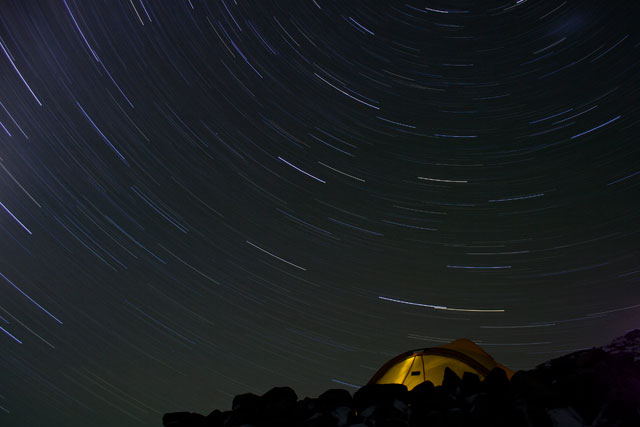
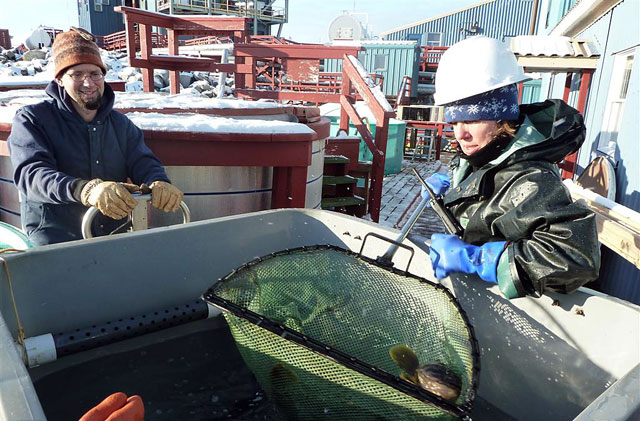
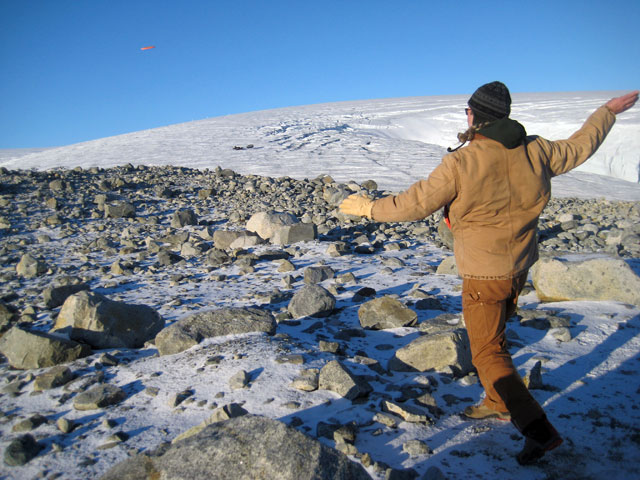
.jpg)
